

UNIQUE AND POPULAR WORKS FOR ALL
NATURE LOVERS.
Uniform with this Volume.
Wayside and Woodland
Blossoms
A Pocket Guide to British Wild Flowers for the Country Rambler.
(First and Second Series.)
With Clear Descriptions of 760 Species.
BY
EDWARD STEP, F.L.S.
And Coloured Figures of 257 Species by
MABEL E. STEP.
Wayside and Woodland
Trees
A Pocket Guide to the British Sylva.
BY
EDWARD STEP, F.L.S.
With 127 Plates from Original Photographs by
HENRY IRVING,
And 57 Illustrations of the Leaves, Flowers and Fruit by
MABEL E. STEP.
AT ALL BOOKSELLERS.
Full Prospectuses on application to the Publishers—
FREDERICK WARNE AND CO.
London: 15, Bedford Street, Strand.
New York: 36, East 22nd Street.
THE WAYSIDE
AND WOODLAND
SERIES
THE BUTTERFLIES OF THE
BRITISH ISLES

Pl. 1. Frontispiece.
Swallow-tail Butterfly.
Male and female, with caterpillars and chrysalids.
BY
RICHARD SOUTH, F.E.S.
EDITOR OF
"THE ENTOMOLOGIST," ETC.
WITH
ACCURATELY COLOURED FIGURES
OF EVERY SPECIES AND MANY VARIETIES
ALSO DRAWINGS OF EGG, CATERPILLAR
CHRYSALIS, AND FOOD-PLANT
LONDON
FREDERICK WARNE & CO.
AND NEW YORK
1906
(All rights reserved)
Few things add more enjoyment to a country ramble than a knowledge of the many and varied forms belonging to the animal and vegetable kingdoms that present themselves to the notice of the observing wayfarer on every side.
Almost every one admires the wild flowers that Nature produces so lavishly, and in such charming variety of form and colour; but, in addition to their own proper florescence, the plants of woodland, meadow, moor, or down have other "blossoms" that arise from them, although they are not of them. These are the beautiful winged creatures called butterflies, which as crawling caterpillars obtain their nourishment from plant leafage, and in the perfect state help the bees to rifle the flowers of their sweets, and at the same time assist in the work of fertilization.
It is the story of these aërial flowers that we wish to tell, and hope that in the telling we may win from the reader a loving interest in some of the most attractively interesting of Nature's children.
There are many people, no doubt, who take an intelligent interest in the various forms of animal life, and yet do not care to collect specimens because, as in the case of butterflies for instance, the necessity arises for killing their captives. Such lovers of Nature are quite satisfied to know the names of the species, and to learn something of their life-histories and habits. [Pg vi]Still, however, there are others, and possibly a larger number, who will desire to capture a few specimens of each kind of butterfly for closer examination and study. It is believed that this little volume will be found useful to both sections of naturalists alike.
The author in preparing the book has been largely guided by a recollection of the kind of information he sought when he himself was a beginner, now some forty odd years ago.
In conclusion, he desires to tender his most sincere thanks to the undermentioned gentlemen, who so kindly furnished him with eggs, caterpillars, and chrysalids; or favoured him with the loan of some of their choicest varieties of butterflies for figuring; without their valued assistance many of the illustrations could not have been prepared:—Rev. Gilbert Raynor, Major Robertson, Messrs. F. Noad Clark, T. Dewhurst, C.H. Forsythe, F.W. Frohawk, A.H. Hamm, A. Harrison, H. Main, A.M. Montgomery, E.D. Morgan, G.B. Oliver, J. Ovenden, G. Randell, A.L. Rayward, E.J. Salisbury, A.H. Shepherd, F.A. Small, L.D. Symington, A.E. Tonge, B. Weddell, F.G. Whittle, and H. Wood.
Varieties—Messrs. R. Adkin, J.A. Clark, F.W. Frohawk, and E. Sabine.
With kind permission of the Ray Society, figures of the following larvæ and pupæ have been reproduced from Buckler's "Larvæ of British Butterflies":—P. daplidice, C. edusa, M. athalia, P. c-album, S. semele, A. hyperanthus, C. typhon, C. pamphilus, C. rubi, C. argiolus, A. thaumas, A. actæon. Larva only—L. sinapis, A. selene, A. aurinia, and T. pruni.
Figures of A. cratægi, A. lineola, and C. palæmon have been made from preserved skins.
For coloured plates, 1, 30, 42, 48, 58, 66, 98, 100, 112, 116, 118, and the accurately drawn black-and-white figures, including enlargements, the author is greatly indebted to Mr. Horace Knight.
Butterflies belong to the great Order of insects called Lepidoptera (Greek lepis, a scale, and pteron, a wing), that is, insects whose wings are covered with minute structures termed scales. Moths (Heterocera) also belong to the same order, and the first point to deal with is how may butterflies be distinguished from moths? In a broad kind of way they may be recognized by their horns (antennæ), which are slender as regards the shaft, but are gradually or abruptly clubbed at the extremity. For this reason they were designated Rhopalocera, or "club horned," the Heterocera being supposed to have horns of various kinds other than clubbed. As a matter of fact this method of separating moths and butterflies does not hold good in dealing with the Lepidoptera of the world, and it is from a study of these, as a whole, that systematists have arrived at the conclusion that there is no actual line of division between moths and butterflies. In modern classification, then, butterflies are reduced from the rank of a sub-order, which they formerly held, and are now dovetailed into the various newer systems of arrangement between certain families of moths.
As regards British butterflies, however, it will be found that these may be known, as such, by their clubbed horns. Only the Burnets among British moths have horns in any way similar, and these are thickened gradually towards the extremity rather [Pg viii]than clubbed. Day-flying moths, especially the bright-coloured ones, might be mistaken for butterflies by the uninitiated, but in all these the horns will be found not at all butterfly-like.
Although varieties of the species will be referred to in the descriptive portion of the book, a few general remarks on variation in butterflies may here be made. All kinds are liable to vary in tint or in the markings, sometimes in both. Such variation, in the more or less constant species especially, is perhaps only trivial and therefore hardly attracts attention. In a good many kinds variation is often of a very pronounced character, and is then almost certain to obtain notice. Except in a few instances, where the aberration is of an unusual kind, it is possible to obtain all the intermediate stages, or gradations, between the ordinary form of a species and its most extreme variety. A series of such connecting links in the variation of a species is of greater interest, and higher educational value, than one in which the extremes alone have a place.
In those kinds of butterflies that attain the perfect state twice in the year, the individuals composing the first flight are somewhat different in marking from those of the second flight. Such species as the large and small whites exhibit this kind of variation, which is termed seasonal dimorphism. The males of some species, as for example the Common Blue and the Orange-tip, differ from the females in colour; this is known as sexual dimorphism. The Silver-Washed Fritillary, which has two forms of the female, one brown like the male, the other green or greenish in colour, is a good example of dimorphism confined to one sex. Gynandrous specimens, sometimes called "Hermaphrodites," are those which exhibit both male and female coloration, or other wing characters; when one side is entirely male and the other side entirely female, the gynandromorphism would be described as complete.
The ornamentation on the under side of a butterfly differs from that of the upper side, and is found to assimilate or [Pg ix]harmonize in a remarkable manner with the usual resting-place. It is therefore of service to the insect when settled with wings erect over the back, in the manner of all butterflies, except some few kinds of Skippers.
The number of known species of butterflies throughout the world has been put at about thirteen thousand, and it has been suggested by Dr. Sharp that there may be nearly twice as many still awaiting discovery. Dr. Staudinger in his "Catalog" gives a list of over seven hundred kinds of butterflies as occurring in the whole of the Palæarctic Region. This zoological region embraces Europe, including the British Islands, Africa north of the Atlas range of mountains, and temperate Asia, including Japan. The entire number of species that can by any means be regarded as British does not exceed sixty-eight. Even this limited total comprises sundry migratory butterflies, such as the Clouded Yellows, the Painted Lady, the Red Admiral, the Camberwell Beauty, and the Milkweed Butterfly; and also the still less frequent, or perhaps more accidental visitors, the Long-tailed Blue and the Bath White. Again, the Large Copper is now extinct in England, and the Mazarine Blue does not seem to have been observed in any of its old haunts in the country for over forty years. The Black-veined White is also scarce and exceedingly local.
The majority of the remaining fifty-seven butterflies may be considered natives, and of these about half are so widely distributed that the young collector should, if fairly energetic, secure nearly all of them during his first campaign. The other species will have to be looked for in their special localities, but a few kinds are so strictly attached to particular spots, that a good deal of patience will have to be exercised before a chance may occur of obtaining them.
A few remarks may here be made in reference to the names and arrangement adopted in the present volume.
As will be adverted to in the descriptive section, the English [Pg x]names of our butterflies have not always been quite the same as those now in general use. There has, however, been far less stability in scientific nomenclature, and very many changes in both generic and specific names have been made during the past twenty years, more especially perhaps within the last decade.
Genera are now founded by some specialists on characters which formerly served to distinguish one species from another, whilst other authorities merge several genera in one upon certain details of structure that are common to them all.
Patient research into the entomological antiquities has revealed much important material, some of which may furnish a new interpretation of the Linnean classification of Lepidoptera.
The discovery of the earliest Latin specific name bestowed upon an insect, is a labour which entails a large expenditure of time and requires fine judgment. Great credit is therefore due to those who undertake such investigations, the result of which may tend to the establishment of a fixed nomenclature in the, probably not remote, future, although it sadly hampers and perplexes students in the meanwhile.
All things considered then, it has been deemed advisable not to make many changes in specific names, and to retain the old genera as far as possible. The arrangement of families, genera, etc., will be found to accord with that most generally accepted both in England and on the continent.
As is the case with all other Lepidoptera, butterflies pass through three very distinct stages before they attain the perfect form. These stages are:—1. The egg (ovum, plural ova). 2. The caterpillar (larva, larvæ). 3. The chrysalis (pupa, pupæ). The perfect insect is called the imago (plural imagines).
Butterfly eggs are of various forms, and whilst in some kinds the egg-shell (chorion) is elaborately ribbed or fluted, others are simply pitted or covered with a kind of network or reticulation; others, again, are almost or quite smooth. If the top of an egg, such as that of the Purple Emperor (Plate 28), is examined under a good lens a depression will be noted, and in this will be seen a neat and starlike kind of ornamentation. In the middle of this "rosette" are, present in all eggs, minute apertures known as micropyles (little doors), and it is through these that the spermatozoa of the male finds entry to the interior of the egg and fertilization is effected. The changes that occur in the egg after it is laid are of a very complex nature, and readers [Pg 2]who may desire information on this subject are referred to Sharp's "Insects," Part I., in the "Cambridge Natural History," where also will be found much interesting and instructive matter connected with the caterpillar and chrysalis, to which stages only brief reference can here be made.
The second stage is that of the caterpillar, and in some species, such as the Red Admiral, this is of very short duration, a few weeks only, whilst in others, as for example the Small Blue, it usually lasts for many months. There is considerable diversity both in the shape and, where it is present, in the hairy or spiny clothing (armature) of caterpillars. All, however, are alike in one respect, that is the body is divided into thirteen more or less well-defined rings (segments), which together with the head make up fourteen divisions. In referring to these body-rings, the first three nearest the head, each of which is furnished with a pair of true legs (thoracic legs), are called the thoracic segments, as they correspond to the thorax of the perfect butterfly. The remaining ten rings are the abdominal segments; the last two are not always easily separable one from the other, and so for all practical purposes they may be considered only nine in number. These nine rings, then, correspond to the abdomen of the future butterfly. The third to sixth of this series have each a pair of false legs (prolegs), and there is also a pair on the last ring; the latter are the anal claspers.
The warts (tubercles) are the bases of hairs and spines, and are to be seen in most butterfly caterpillars, but they generally require a lens to bring them clearly into view. These warts are usually arranged in two rows on the back (dorsal series) and three rows on each side (lateral series).
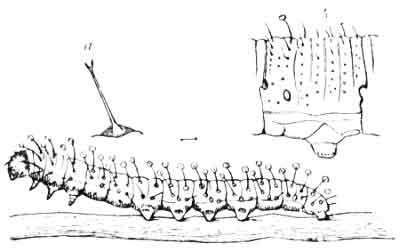
Fig. 1.
Young caterpillar of Orange-tip highly magnified.
(After Sharp.)
All the various parts referred to, or to be presently mentioned, may be seen in Fig. 1, which also shows a peculiarity that is [Pg 3]found in very young caterpillars of the Orange-tip, and in some others of the "Whites" (Pieridæ). The odd thing about this baby caterpillar is that the fine hair arising from each wart is forked at the tip (Fig. 1, a), and holds thereon a minute globule of fluid. When the caterpillars become about half grown these special hairs are lost in a general clothing of fine hair. Fig. 1, b, represents a magnified single ring of the caterpillar, and this shows a spiracle and the folds of the skin (subsegments). The manner in which such folding occurs is to be observed in the higher study of larval morphology.
On each ring, except the second (including now the three thoracic with the nine abdominal; and so making twelve rings), the third, and the last, there is an oval or roundish mark which indicates the position of the breathing hole (spiracle). Through these minute openings air enters to the breathing tubes (tracheæ), which are spread throughout the interior of the caterpillar in a seemingly complicated kind of network of main branches and finer twigs; air is thus conveyed to every part of the body. In the event of one or two air-holes becoming in any way obstructed, the caterpillar would possibly be none the worse; but if all the openings were closed up effectually, it would almost certainly die. Total immersion in water, even for some hours, is not always fatal.
Turning again to the "feet" of the caterpillar, it will be seen [Pg 4]from the figure that the true legs (a) differ from the false legs (b) in structure. The former are horny, jointed, and have terminal claws; the latter are fleshy, with sliding joints, and the foot is furnished with a series of minute hooks which enable the caterpillar to obtain a secure hold when feeding, etc. The false legs are also the chief means of locomotion, as the true legs are of little service for this purpose. The true legs, however, appear to be of use when the caterpillar is feeding, as the leaf is held between them so as to keep it steady whilst the jaws are doing their work.
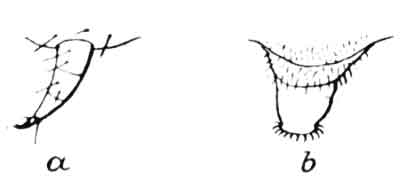
Fig. 2.
(a) True and (b) false legs.
In the accompanying figure of the head of a caterpillar the mouth parts are clearly shown. The biting jaws (mandibles) are slightly apart, above them is seen the upper lip (labrum), and below them is the under lip (labium or lingua). The maxillæ are very tiny affairs, but they should be noted because in the butterfly they become the basal portions of the two tubes which, when united together, form the sucking organs (proboscis). The eyes, or ocelli as they are termed, are minute, and are said to be of slight use to the caterpillar as organs of sight, so that it probably has to depend on its little feelers (antennæ) for guidance to the right plants for its nourishment. Attention should also be given to the spinneret, as it is by means of this that the silken threads, etc., for its various requirements are provided; the substance itself being secreted in glands placed [Pg 5]in the body of the caterpillar. The palpi are organs of touch, and seem to be of use to the caterpillar when moving about.
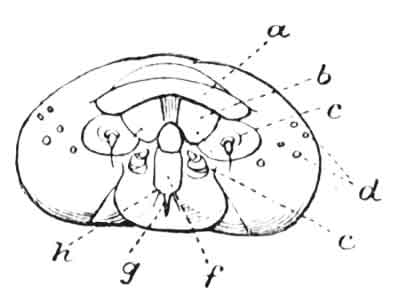
Fig. 3.
a, labrum; b, mandible; c, antenna; d, ocelli; e, maxilla;
f, labium; g, spinneret; h, labial palp.
Immediately after hatching, many caterpillars eat the egg-shell for their first meal; they then settle down to the business of feeding and growing. It should be remembered that it is entirely on growth made whilst in the caterpillar stage that the size of a butterfly depends. In the course of a day or two the necessity arises for fasting, as moulting, an important event, is about to take place. Having spun a slender carpet of silk on a leaf or twig, the caterpillar secures itself thereto, and then awaits the moment when all is ready for the transformation to commence. After a series of twistings from side to side and other contortions, the skin yields along the back near the head, the head is drawn away from its old covering and thrust through the slit in the back, the old skin then peels downwards whilst the caterpillar draws itself upwards until it is free. The new skin, together with any hairs or spines with which it may be clothed, is at first very soft. In the course of a short time all is perfected, and the caterpillar is ready to enter upon its second stage of growth. At the end of the second stage the skin-changing operation is again performed, and the whole business is repeated two or more times afterwards. Finally, however, when the caterpillar has shed its skin for the last time, the chrysalis is revealed, but with the future wings seemingly free. These, together with the other organs, are soon fixed down to the body by the shell, which results from a varnish-like ooze which covers all the parts and then hardens.
Generally speaking, newly hatched caterpillars, though of different kinds, are in certain respects somewhat alike, but the special characters of each begin to appear, as a rule, after the first change of skin (ecdysis), and these go on developing with each successive stage (stadium) until the caterpillar is full grown. The form assumed in each stage is termed the instar, therefore a caterpillar just from the egg would be referred to as [Pg 6]in the first instar; between the first and second changes of skin, as in the second instar, and so on to the chrysalis, which in the case of a caterpillar that moulted, or changed its skin, four times before attaining full growth, would be the sixth instar, and the butterfly would then be the seventh instar. In practice, however, it is usually the stages of the caterpillar alone that are indicated in this way.
The term chrysalis more especially applies to such of them as are spotted or splashed with metallic colour, as, for example, the chrysalids of some of the Fritillaries. The scientific term for the chrysalis is pupa, which in the Latin tongue means "a doll or puppet."
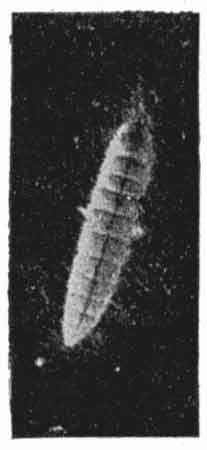
Fig. 4.
Caterpillar of Small White, about to change to chrysalis.
In passing to the chrysalis stage the caterpillars have sometimes to make rather more preparations than in previous skin-changing provisions. Those of the Swallow-tail, Whites, Orange-tip, and similar kinds have to provide a silken girdle for the waist as well as a pad for the tail. Chrysalids that hang suspended, head downwards, such as the Vanessids, Fritillaries, etc., are attached by the cremaster—a hooked arrangement on the tail (Fig. 5)—to a pad of silk; others, such as the Blues and the Coppers, appear to be held in position on a leaf, or some other object, by means of a fine girdle of silk, or sometimes a few silken threads spread net-like above and below them—rudiments of a cocoon in fact. Chrysalids of the Skippers are enclosed in a more or less complete cocoon placed within a chamber, formed of a leaf or leaves of the food-plant, drawn together by silken cables. Some of these [Pg 7]chrysalids are furnished with hooks on the tail as well as with a girdle for suspension; but others have hooks only.
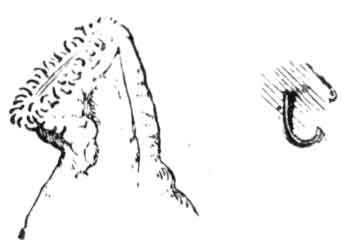
Fig. 5.
Enlarged view of cremaster,
and a hook still more enlarged.
(After Sharp.)
As almost all the chrysalids here considered are figured in the illustrations, it will be unnecessary to refer in detail to their great diversity in form, but a few general remarks on the structure of a chrysalis may be made.
If the upper (dorsal) surface of a chrysalis is examined, the thorax and the body divisions will easily be made out, while, by looking at the sides and the under (ventral) surface, the various organs, such as the wings, legs, antennæ, etc., will be found neatly laid along each side of the "tongue," or proboscis, which latter extends down the centre. All these are separately encased, but by reason of the shell mentioned in the remarks on the caterpillar, they appear to be welded together. When, however, the butterfly is ready to emerge, the shell of the chrysalis is split along the thorax and at the lower edge of the wing-cases, and the insect is then able to release itself from the pupal trappings. This breaking open of the chrysalis shell is termed dehiscence (dehisco, "to split open"), and the manner in which it is effected varies in different species. The emergence of a butterfly from the chrysalis is always an interesting operation to observe, and every one should make a point of watching the process, so that he may obtain practical knowledge of how the thing is done. A photograph of it will be found in the description of the Wall Butterfly.
Having safely cleared itself free of the chrysalis shell, the butterfly makes its way to some suitable twig, spray, or other object, from which it can hang, sometimes in an inverted position, [Pg 8]whilst a very important function takes place. This is the distention and drying of the wings, which at first are very weak and somewhat baggy affairs, although the colour and markings appear upon them in miniature. All other parts of the butterfly seem fully formed, but the helpless condition of the wings alone prevent it as yet from floating off into the air. In a remarkably short time, after the insect has settled to the business, the fluids from the body commence to flow and circulate through the wings, and these are seen gradually expanding and filling out until they attain their proper size. Occasionally there is some obstruction to the equal distribution of the fluids, and when this occurs a greater or lesser amount of distortion, or cockle, in the wing affected is the result. When the inflation is completed the wings are kept straight out for a time; they are then motionless, but all their surfaces are well apart. The wings being now fully developed, the further flow of fluid appears to be arrested. It has been stated by some authorities that this fluid is fibrin held in solution, and that when the work of expansion has been accomplished, the watery medium evaporates, leaving the fibrin to harden, and so fasten together the upper and lower membranes of the wing and to fix the veins, or nerves, in their proper position. Mayer, a specialist on these matters, referring to the expansion of the wings, remarks that the blood [the fluid previously mentioned] forced into the freshly emerged wing would cause it to become a balloon-shaped bag if it were not for fibres that hold the upper and lower walls closely together. The fibres referred to, he states, are derived from those hypodermic cells which do not contribute to the formation of scales, but are stretched out from one wall of the wing to the other.
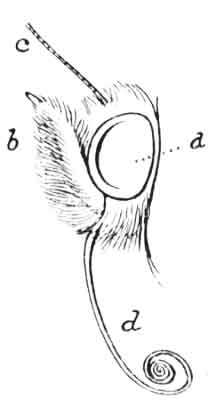
Fig. 6.
Head of Butterfly.
a, compound eye; b, palp; c, antenna; d, proboscis.
It may be well now to briefly consider some of the structural details of the perfect butterfly, so a beginning will be made with the head (Fig. 6). When looking at the head of a butterfly, the first thing to attract the attention is the very large size [Pg 9]of the compound eye (a), which seems to take up the largest share of the whole affair. Although so bulky and so complex in the matter of divisions, or facets, as they are termed (the facets are not shown in figure), the power of sight is not really very keen. A butterfly can see things in a general way readily enough, but it seems unable to clearly distinguish one object from another. When engaged in egg-laying, the female butterfly rarely fails to place her eggs on a leaf or spray of the plant that the future caterpillar will feed upon, and it has been suggested that in making this unerring selection the insect is guided more by the sense of smell than by that of sight.
The horns (c) (antennæ), or feelers, as they are sometimes called, which adorn the head, are now considered to be organs of smell. These are composed of a number of rings or segments, which vary in the different kinds of butterfly, as also does the shape of the terminal rings forming what is known as the club. In Fig. 7, e (Purple Emperor) and f (Marbled White) represent the gradually thickened club; in g (Brimstone) and h (Dark-green Fritillary) the clubs are more or less abruptly formed. Our Skippers have well-developed clubs; these may be hooked at the tip as in i (Large Skipper), or blunt at the tip as in j (Chequered Skipper); at the base of the Skipper's antenna, that is at the point where it is inserted in the head, there is a tuft of rather long hairs.
Of the various mouth parts it will only be necessary to refer to the suction-tube, Fig. 6, d (proboscis), often called the "tongue," which is perhaps the most important, at least to the butterfly itself, as this organ is, in a way, as useful to it in the perfect state [Pg 10]as were the very differently constructed strong biting jaws (mandibles) of its caterpillar existence. These latter in the butterfly are only microscopically represented, and the suction-tube of the perfect insect is an extension of the maxillæ, which in the caterpillar are not conspicuous. When not engaged in probing the nectaries of flowers for the sweets they contain, the suction-tube is neatly coiled up between the palpi (Fig. 6, b). Its great flexibility is due to the many rings of which it is composed. Although seemingly entire, it is really made up of two tubes, each being grooved on its inner side, and forming, when the edges are brought together, an additional central canal, through which the sweets from the flowers and other liquids are drawn up into a bulb-like receptacle in the head, whence it passes into the stomach. When it is remembered that the passage of sweet, and no doubt sticky, fluid through the central tube would most probably result in its walls becoming clogged, there is reason to suppose that the method of construction permits of the canal being cleansed from time to time.
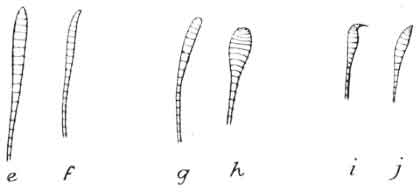
Fig. 7.
Antennæ of Butterflies.
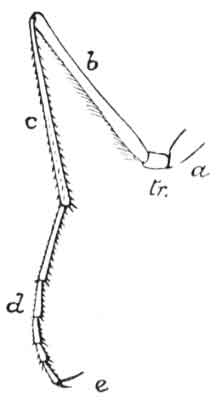
Fig. 8.
Leg of Butterfly.
The important divisions of the body are the thorax and the abdomen. The former is made up of three segments (named the pro-, meso-, and meta-thorax), each of which, as in the caterpillar state, is furnished with a pair of legs; the second and [Pg 11]third, which are closely united, each bear a pair of wings also. The legs, which in the butterfly are adapted for walking at a leisurely pace, are made up of four main parts; these are (a) the basal joint (coxa, coxæ), (b) the thigh (femur, femora), (c) the shank (tibia, tibiæ), and (d) the foot (tarsus, tarsi). The small joint uniting the coxa with the femur is the trochanter (tr.). The foot usually has five joints, the last of which is provided with claws (e). The abdomen really consists of ten rings or segments according to some specialists. Examined from above, the female butterfly appears to have only seven rings and the male butterfly eight. This discrepancy arises from the fact that in the former sex two rings and in the latter one ring are withdrawn into the body, and so are tucked away out of sight. The organs of reproduction are placed in the terminal ring. The breathing arrangements are pretty much as in the caterpillar, but the external openings are not so apparent owing to the dense clothing of the body.
The beauty of a butterfly's wings is intimately connected with the form and colour of the scales with which they are covered, as with a kind of mosaic; but before the scales and their method of attachment, etc., are referred to, something should be said about the wings themselves. The various shapes of these organs of flight will be seen on turning to the plates, where will be found accurate portraits of every species that will be dealt with in the descriptive section later on.
A butterfly's wing consists of an upper and a lower membrane, with a framework of hollow tubes, acting as ribs, between the two layers. Fig. 9, A, shows a fore and a hind wing of the [Pg 12]Swallow-tail butterfly. The point of attachment with the thorax is the base of the wing, and the edge farthest from the base is the outer margin (termen); the upper edge, or front margin, is the costa; and the lower edge is the inner margin (dorsum). The point where the upper margin meets the outer margin on the fore wing is the apex, but on the hind wing it is called the outer angle; the angle formed by the junction of outer and inner margins is the inner angle of the fore wing, but the anal angle of the hind wing. The term tornus is sometimes used for this angle on either wing. Dividing the wings transversely into three portions, we have three areas, termed respectively basal, central or discal, and outer. These are terms used in descriptions of butterflies, and it will be useful to remember them.

Fig. 9.
Butterflies' Wings.
The ribs of a butterfly's wings are by some authors described as veins, whilst others style the main ones nervures, and the branches nervules. Fig. 9, B, represents the venation, or neuration of the Black-veined White, and the numeral system [Pg 13]of indicating the veins has been adopted, as it is the most simple. In another method of referring to the venation, and one that has been much in use, vein 12 of the fore wing would be styled the costal nervure, or vein; veins 11, 10, 9 (absent in figure), 8, and 7 would be the subcostal nervules 1, 2, 3, 4, and 5; 6 would become the upper radial, and 5 the lower radial; 2, 3, and 4 would be the median nervules 1, 2, and 3; vein 1 would be the submedian nervure, or vein. On the hind wing, vein 1a would be the internal vein; 1 the submedian; 2, 3, and 4 the median nervules; 5 the lower and 6 the upper radials; 7 the subcostal, and 8 the costal nervures. Just near the base of the hind wing will be noted a short recurved vein (p.c.); this is the precostal vein, and so named because it comes before the costal. It is always absent in some species. Comparing the venation of A and B, it will be seen that in A the fore wing has 12 veins and the hind wing 8 veins, whilst in B there are only 11 veins on the fore wing, but the hind wing has one vein more than that of A. In the Black-veined White, vein 9 is absent on the fore wing, and on the hind wing there is one internal vein.
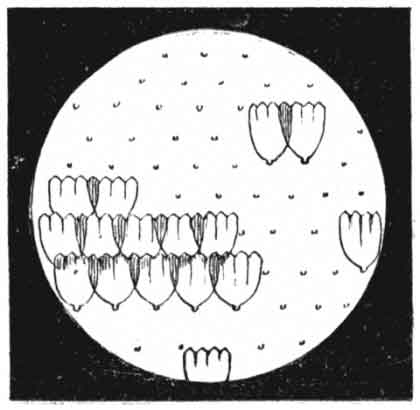
Fig. 10.
Arrangement of Scales.
(After Holland.)
Dust-like as they appear to the naked eye, the scales from a butterfly's wing seen under the microscope are found to be exceedingly interesting structures and very varied in shape. Dr. Sharp describes them as "delicate chitinous bags." Chitin, it may be mentioned, is [Pg 14] the horny substance of which the chrysalis shell is formed, and this was adverted to when discussing the chrysalis stage as a varnish-like ooze. As seen on the wings, the scales are flattened and the upper and under sides are then almost, or quite, brought together. They are attached in lines on the membrane or covering of the wing by short stalks which fit into sockets in the membrane. The arrangement of the scales, which has often been stated to resemble that of the slates on a roof, is shown in Fig. 10.
Colour is chiefly due to pigment contained in the scale or adhering to the interior of its upper side. Pigments, according to Mayer, are derived, by various chemical processes, from the blood while the butterfly is still in the chrysalis. Some scales have minute parallel lines (striæ) on their upper sides, and rays of light falling on these are turned aside or broken up, and so produce changes in the colouring of a wing, according to the angle from which it is looked at.
The males of many kinds of butterfly have special scales, which are known as androconia, or plumules. It is believed that these are scent organs. Whatever their particular use may be to the possessor, these androconia enable the entomologist to distinguish male specimens from females with great certainty. In the Fritillaries they are placed on one or more of the median nervules (veins 2, 3, and 4) of the fore wing. In the Meadow Brown and its kindred they form brands on the disc of the fore wing. In the Skippers they are placed in a fold of the costa in some species, and in other species they are clustered together, into more or less bar-like marks, about the middle of the fore wings. Some of these various shaped "plumules" are shown in the illustrations.
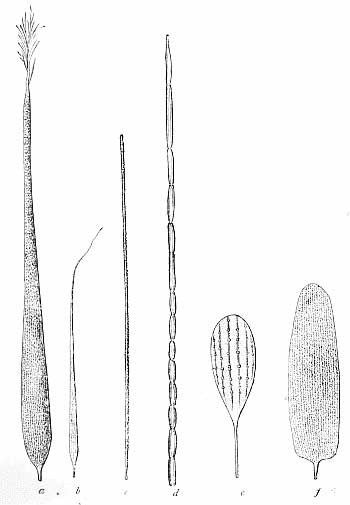
Fig. 11.
Butterfly Plumules.
a. Tufted Plumule (Satyrs);
b. Bristle Plumule (Grizzled Skipper);
c. Hair Plumule (Dingy Skipper);
d. Jointed Plumule (Silver-studded Skipper);
e. Bladder Plumule (Common Blue);
f. Dotted Plumule (White-letter Hairstreak).
(After Aurivillius.)
In the foregoing sketch of the life cycle of a butterfly, the object has been to condense as much necessary information as possible into a limited space. Many matters of importance to the student have not been touched on, but it was considered [Pg 16]that, as these were more especially connected with a higher scientific phase of the subject than would here be found helpful, they might be omitted.
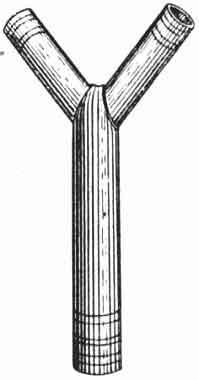
Fig. 12.
Y-piece
Naturally the first matter for consideration, when the formation of a collection of butterflies has been decided upon, is how to set about it. Well, there are two methods of effecting our purpose. The specimens may be purchased from a dealer in such things, or we may acquire an outfit comprising net, boxes, and pins, and go in search of the insects ourselves. Apart from its healthful and entertaining possibilities, the latter method has very much to recommend it. In the first place, those who are at all observant—and no true lover of Nature can be suspected of being otherwise—will become acquainted with the objects under natural conditions, and so be enabled to appreciate them more highly than could be the case if they were obtained in any other way. The chief purpose in making a collection of Natural History specimens should be study of some kind rather than mere accumulation.
The net may be a simple cane ring one of home construction, or the more elaborate, but not necessarily more efficient, fabrication of steel-jointed ring with grenadine bag and telescopic handle. A good serviceable butterfly-net may be fitted up as follows. Procure a light flexible cane, about 3 feet or so in length. Next, a Y-shaped holder (Fig. 12) for the two ends of the cane will have to be made, and either tin or brass may be used for the purpose. The latter is the better metal, and the [Pg 17]parts should be brazed and not soldered together. (If difficulty is experienced in the manufacture of this article, it may be obtained from any dealer in entomological requisites for a few pence.) The bag may be made of leno, tarletan, or fine mosquito netting; the latter is the most serviceable, and should be used wherever it can be obtained. The size of the bag at the top, where it has a wide band to take the cane, should not exceed the circumference of the cane ring when fitted in the two arms of the Y-piece; the depth should be just a little less than the length of one's arm, and the bottom should be rounded off so that no corners are available for the butterflies to get into and damage their wings. An opening about 3 inches in length is left in the seam of the bag just under the Y-piece, so that the cane may be removed and rolled up when the net is put out of action. The ring band should be covered with some stouter material to prevent it from fraying, thin leather is sometimes used for this purpose; the slit in the seam also requires protecting on each side, and strengthening at the lower end by a crosspiece. An ordinary walking-stick, with the ferrule end thrust into the longer tube of the Y, will serve as a handle to the complete net.

Fig. 13.
Kite or Balloon Net.
The dealers adverted to above generally stock a variety of nets ready fitted for use. Among these is a very useful pattern known as the kite or balloon net (Fig. 13). This is made in two sizes, and as the writer has used this kind of net for at least [Pg 18]twenty years, he is able to speak well of its merits. It does not need a stick for ordinary work, and the long end of the socket should be about 9 inches in length.
The "ring" being made of four separate rods, in addition to the Y-piece, some care will have to be taken when a balloon net is unshipped. It will be found a good plan to leave the two short curved canes in the hem or band of the bag, remove the two straight arms from the Y-piece and the band, place these on top of the bag when folded, and then roll all up together. A canvas or linen pouch or pocket, opening at one end, may be made to contain the whole affair.
The umbrella-net, when in its case, looks very like the familiar "gamp." Its chief merit is that it is quickly put up for use, and its principal defect is that the stick, which crosses the mouth of the bag, frequently damages the quarry.
Another implement of the chase known as the "Ortner" net is used pretty extensively on the Continent. English entomologists who have used it speak of it most favourably. Its great advantage over other nets is found in the simple and rapid method of its adjustment for use.
In connection with nets it may be well to advise the wielder to remember that carrying a threaded needle is a useful practice. Tears and rents are apt to occur, and it is well to have the means of repair handy.
Some collectors seem to be expert at killing butterflies by pressing the sides of the thorax together. The method is not, however, as satisfactory as one could wish, and so no more need be said about it. For the happy despatch of insects, the cyanide bottle is frequently used. All that has to be done is to clap the open bottle over the captive while still in the net, then draw the gauze or what-not over the mouth of the bottle until the bung can be inserted, and the whole affair withdrawn from the net.
Cyanide of potassium is a deadly poison, and no inexperienced [Pg 19]person should attempt to charge a cyanide bottle himself. In fact, chemists are not permitted to supply the poison to unknown customers. Under certain conditions, however, a chemist might consent to make up a killing bottle, and the following instructions may help him in doing this. A fairly strong, clear glass bottle, holding about 4 to 6 ounces; the mouth must be pretty wide, and closed with a well-fitting bung that has been dipped in melted wax; if the bung is of fine grained cork, the wax will not be needed. At the bottom of the bottle place a thick layer of the cyanide, and over this pour plaster of Paris which has been mixed with water and converted into a cream-like paste: one-third of the depth of the bottle to be occupied by the poison and plaster, but only a thin layer of the latter should cover the former.
Dealers who supply cyanide bottles (uncharged) also have in stock a brass bottle for chloroform, which some people prefer as a killing agent because it does not change the colour of insects as cyanide is occasionally apt to do. In using this, the insect should be boxed, then a drop of the chloroform may be allowed to run from the bottle over the perforated lid or bottom of the box, and a finger put over the hole or holes for a short time.
The majority of butterflies, if transferred to pill boxes from the net, settle down quietly. In this way they may be taken to one's home and there placed, boxes and all, into the ammonia jar, a simple but very effective contrivance. To start one of these lethal chambers, procure a good sized pickle jar, one of the brown earthenware kind, holding about 2 gallons. At the bottom put in several layers of stout blotting-paper, and have ready a covering for the mouth of the jar. This covering may be of skin, waterproof-apron material, or even thick brown paper. Before turning the boxes into the jar, lift up the blotting-paper, drop in about half a teaspoonful of strong liquid ammonia (⋅880) and replace blotting-paper. Directly the boxes are in the jar, [Pg 20]put on cover and tie it down securely. If brown paper is used, a piece of pasteboard should be put over it and a weight on top of that. Suffocation takes place directly the gas reaches the insect, but it often happens that one or more of the boxes exclude the gas longer than others. At the end of half an hour all may be removed, but the insects will not hurt in any way if left in all night.
The best kind of boxes for field work are those known as "glass bottomed," as in these the captives can be examined and, if not wanted, may be set free. It is always better to retain only those specimens that we know are really useful, rather than to incur the necessity of throwing away insects after we have deprived them of life.
If butterflies are pinned on the spot, a collecting box will be required, and the most useful and convenient is one of an oval shape. This should be made of zinc, and lined with cork that is held in place by zinc clips. The cork should be kept damp when in use, and the water used for damping should have a few drops of carbolic acid mixed with it so as to prevent the formation of mould. Insects may remain in such a box for several days without injury. This box will also be useful for relaxing specimens that have been badly set, or have been simply pinned during the busy season.
In the matter of pins, it is not altogether easy to make suggestions. There are, perhaps, only two makers in this country of entomological pins, and each of these supplies a large number of sizes. The selection of suitable pins will largely depend on the method of setting adopted. Black pins are, however, the best for butterflies, and are now used almost exclusively.
In pinning a specimen care should be taken that the pin passes in a direct line through the centre of the thorax. Insects that are properly pinned set better, and have a neat appearance when arranged in the collection. For regulating the [Pg 21]height of specimens on the pin, a handy graduated stage has been devised by Dr. Scarancke (see Fig. 14). Each of the little rests are hollowed to receive the body of the insect, so suppose we wish a quarter of an inch of the pin to show below the body of a specimen, the pin is pushed through a perforation in the centre of the rest groove marked "3/16" until the point touches the wooden base, and we have the required length.
Beginners would, perhaps, find three sizes of pins quite sufficient for almost every purpose—say, Nos. 10, 8, and 5 of one maker; or Nos. 9, 17, and 5 of the other. In each case the first size pin would be suitable for small butterflies, the second size for all other butterflies except quite the largest, for which No. 5 would remain. English pins are sold by the ounce.

Fig. 14.
Pinning Stage.
Setting, as it is called, that is, spreading out and fixing the wings so that all their parts are displayed, arranging the horns, etc., is perhaps the most tedious work that the collector will be called upon to perform. The various methods will be referred to, and he must then decide as to which he will adopt. Each style may possibly be found to have its difficulties at first; but time and patience will overcome these, therefore he must be prepared for a good deal of troublesome practice before he quite gets "the hang of the thing," and can [Pg 22]set out his specimens without removing a greater or lesser number of the scales.
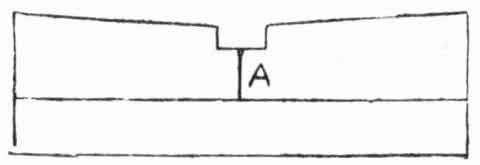
Fig. 15.
Board for Flat-setting.
First, as to the flat and high setting as practised by almost every lepidopterist abroad and by some in our own country. Boards of the pattern, shown in the illustration, will be required; also some tracing cloth, and a pair of entomological forceps, bead-headed pins, etc. In these boards, it will be noticed, the sides tilt outwards; this is to allow for drooping of the wings, which generally occurs after insects are removed from the "sets." In this case the wings would settle dead flat, which is considered to be the acme of perfection in this style of setting. Carlsbad or other foreign pins would be used for this kind of work. They are of a uniform length, about one inch and a half, but vary in thickness, and are usually sold by the 100 or 1000.
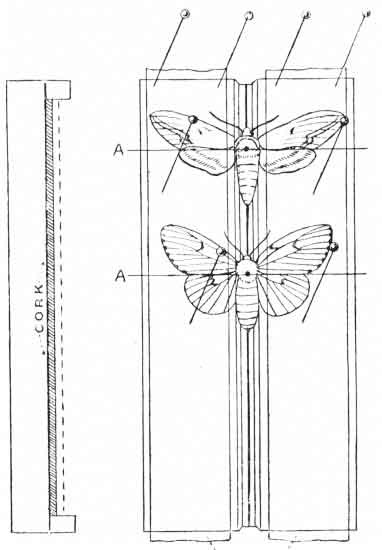
Fig. 16. Fig. 17.
Longitudinal Section of Setting-board.Setting-board in use.
Manipulation of the specimen on these boards is as follows. Having carefully pinned it, leaving the greater length of pin below the insect, guide the pin carefully through the narrow opening (a Fig. 15 and the cork (Fig. 16) below to a suitable depth, so that the body of the insect rests in the groove and the wings lie easily on the board. Then take two strips of tracing cloth, glazed side downwards, and pin them on at the end of each side of the setting-board (Fig. 17). The strip should be just wide enough to cover all but the basal part of the wings. Now pass the strips over the wings, press one side lightly with the fingers of the left hand while the wings are moved into position with the setting needle (a fine needle with eye end fixed into the stick of a small penholder will do for this) from the uncovered base, a pin being inserted below the fore wing while the hind wing is brought into position, but when this [Pg 24]has been done and another pin inserted to keep it in place, as shown in the diagram, the first pin may be removed; repeat the same operation on the other side. Other pins will be required to keep the horns, etc., in place. In dealing with the next specimen the strips will have to be turned back while it is fixed into position, then proceed as before. An imaginary line following the inner margin of the fore wings and passing through the pin on the thorax is an excellent guide to uniformity in setting. The groove will prevent the pin leaning to either side, but care should be taken that it does not incline either forwards or backwards. The strip of tracing cloth may be used more than once, but the roughness of the pin holes should be removed by drawing the strip across the back of a knife.

Fig. 18.
"Saddle" Setting-board.
The setting-boards most frequently used in this country have sloping sides, and are known as saddles (Fig. 18). Where tracing cloth is used, the modus operandi is exactly similar to that just described, but small pins will do for pinning down the strips, as the saddles are made of cork, or cork carpet, instead of wood.
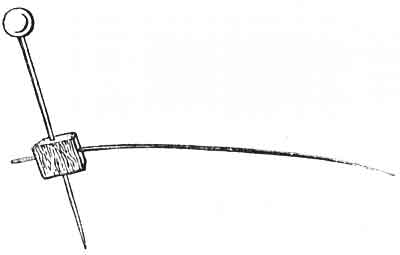
Fig. 19.
Setting-bristle.
The following method of setting butterflies on the English kind of "board" or saddle is frequently adopted. Select a suitable saddle, that is one that has the groove wide enough to take the body, and rather wider than the wings when expanded. A setting bristle [Pg 25]will then be required. This is made, as shown in Fig. 19, by fixing a fairly long and stout bristle, or a very fine needle, or a thin length of quill, in a cube of cork; the cork cube has a stoutish and sharp-pointed pin pushed through it as indicated. Having placed the first insect on the saddle with its body comfortably resting in the groove and the wings flush with the surface, the setting bristle is then brought into action. The point of the pin is rested on the saddle directly in the rear of the hind wing, and the top of the bristle touching the saddle in advance of the front wing. Tilt the pin slightly forward until the bristle presses lightly on the central area of the wings, then with the setting needle push the wings into the required position, and at the same time drive pin of bristle into the saddle. After the wings have been secured by means of braces (triangular pieces of thin card or stout paper, with a pin through the base of the triangle), proceed in the [Pg 26]same way with the other side. Finally, fix a brace to the tip and angle of each fore wing to keep them from turning up in drying, and a pin or two may be required for the horns if these are not in a good position. Instead of using braces, a strip of transparent paper may be pinned over the wings beyond the bristle, but in this case the bristle must be pressed across the wings at a point nearer their base than in the previous method (see lower figure in Fig. 20). In lieu of a setting bristle a length of sewing cotton may be used. Tie a double knot at one end, and through this pass the point of a pin in such a way that the cotton lies flush on the saddle when in use. Insert the pin firmly in the saddle a little in advance of the fore wing, then draw the cotton downwards across the wings and hold it taut, with the fore finger of the left hand placed on it just in rear of the hind wing. Whilst so held the wings can be got into pose with the setting needle, and braces may then be applied as previously directed.
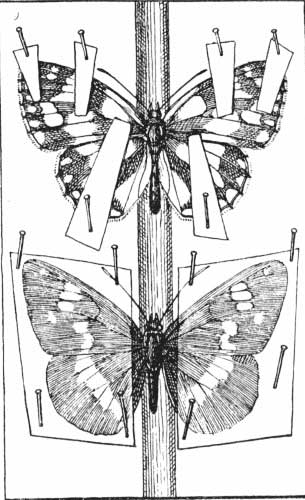
Fig. 20.
Brace and Band Modes of setting.
Fig. 21 shows a specimen set by a method that is in vogue in the north. Blocks of soft pine, grooved and bevelled as in the cork saddle, are easily made. Down the centre of the groove there is a saw cut for the point of the pin to enter, and nicks are cut along the bottom edge at each end. One end of a length of cotton is knotted and fixed in a nick, then a turn is taken over the wings on one side; these are placed in position and secured by other turns of the cotton. The other side is then treated in the same manner, and the end of the cotton fastened off in one of the nicks. This is a quick and, in skilled hands, a very neat method.
As specimens after being set will have to remain on the setting boards or saddles for at least a fortnight, it will be necessary to protect them not only from dust, but from possible attack by ants, cockroaches, mice, etc. This is best ensured by placing the sets into a receptacle called a setting or drying house. Dealers supply these, but the young collector may have a knowledge of carpentry and could make one for himself. The [Pg 27]height and depth of such a construction would depend upon the number and the width of the boards or saddles that would be put therein. The width would be that of the length of the boards, which is usually 14 inches. About a quarter of an inch of cork is cut off each end of the saddles, and grooves are cut in the sides of the house for these to run in. The back and the door should have a square of fine perforated zinc inserted in them for ventilation. As an example of holding capacity it may be well to note that a house with a height of 12 inches, and a depth of 6 inches, inside measurement, would take eighteen 2-inch boards if the grooves were cut at 2 inches apart, or twenty-four boards of same width if 1-1/2 inch only were allowed between the grooves.
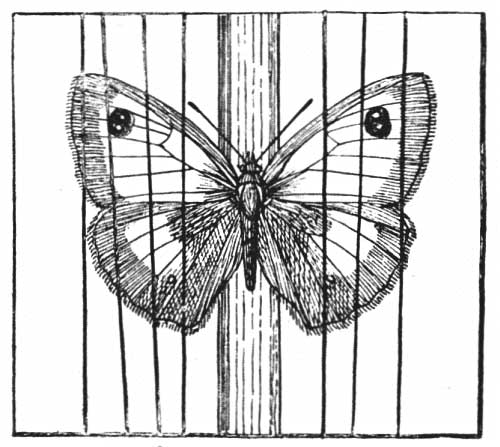
Fig. 21.
Cotton Method of setting.
In taking insects off the sets, the braces or strips should be removed from the wings, and the pins from the horns, with care, as a good deal of damage can be done in the performance of this operation, simple as it seems to be. A little twist of a brace and away goes a patch of scales, a side slip of a pin and off comes a horn.
Pending the arrival of that twelve or twenty drawer cabinet, the beginner will probably be content to arrange his specimens in boxes. A handy sized box is one measuring 14 inches by 10 when closed, and it should have a cell for naphthaline.
Before putting the specimens away into boxes or drawers [Pg 28]they should be labelled with the date of capture, the locality, the name of the captor, and any other detail of interest in connection with it. All these particulars may be written on small squares of paper and put on the pins under the specimens.
Cabinets or boxes containing insects should always stand where they are free from damp, otherwise mould may make its appearance on the specimens. Mouldy insects may be cleaned, but they never look nice afterwards; so it will be well to bear in mind that prevention is better than cure. Where drawers and boxes are not properly attended to in the matter of naphthaline, mites are apt to enter and cause injury to the specimens. If these pests should effect a lodgment, a little benzine poured on the bottom of box or drawer will quickly kill them. The benzine, if pure, will not make the least stain, and of course the drawer or box must be closed directly the benzine is put in. Do this only in the daytime.
Rearing butterflies from the egg is much practised, and is a very excellent way. One not only obtains specimens in fine condition, but gains knowledge of the early stages at the same time. The eggs of most of the Whites, the Orange-tip, the Brimstone, and some others are not difficult to obtain, but searching the food-plants for the eggs of many of the butterflies is tiresome work, and not altogether remunerative. Females may be watched when engaged in egg-laying, and having marked the spot, step in when she has left and rob the "nest." The best plan is to capture a few females and enclose them in roomy, wide-mouthed bottles, or a gauze cage, putting in with them a sprig or two of the food-plant placed in a holder containing water. The mouth of the bottle should be covered with gauze or leno, and a bit of moistened sugar put on the top outside. Either bottle or cage must be stood in the sunshine, but it must be remembered that the butterflies require plenty of air as well as sunshine, and that they can have too much of the latter.
The Swallow-tail butterfly is the only British member of the extensive and universally distributed sub-family Papilioninæ, which includes some of the largest as well as the most handsome kinds of butterfly. Our species has yellow wings ornamented with black, blue, and red, and is an exceedingly attractive insect. The black markings are chiefly a large patch at the base of the fore wings, this is powdered with yellow scales; a band, also powdered with yellow, runs along the outer or hind portion of all the wings. There are also three black spots on the front or costal margin, and the veins are black. The bands vary in width, and that on the hind wings is usually clouded more or less with blue. At the lower angle of the hind wings there is a somewhat round patch of red, and occasionally there are splashes of red on the yellow crescents beyond the band. The male and female are shown on Plate 2.
The eggs are laid on leaflets of the milk parsley (Peucedanum palustre), which in the fenny home of the butterfly is perhaps the chief food-plant of the caterpillar. This is one of the few eggs of British butterflies that I have not seen. Buckler says that it is globular in shape, of good size, greenish yellow in colour when first laid, quickly turning to green, and afterwards becoming purplish.
The caterpillar when full grown, as figured on Plate 1, is bright green with an orange-spotted black band on each ring of the body, and blackish tinged with bluish between the rings. The head is yellow striped with black. When it first leaves the egg-shell, which it eats, the caterpillar is black with a noticeable white patch about the middle of the body. After the third change of skin it assumes the green colour, and at the same time a remarkable V-shaped fleshy structure of a pinkish or orange colour is developed. This is the osmaterium, and is said to emit a strong smell, which has been compared to that of a decaying pine-apple. The organ, which is extended in the figure of the full-grown caterpillar, is not always in evidence, but when the caterpillar is annoyed the forked arrangement makes its appearance from a fold in the forepart of the ring nearest the head. Other food-plants besides milk parsley are angelica (Angelica sylvestris), fennel (Fœniculum vulgare), wild carrot (Daucus carota), etc. From eggs laid in May or June caterpillars hatch in from ten to twelve days, and these attain the chrysalis state in about six or seven weeks. If the season is a favourable one, that is fine and warm, some of the butterflies should appear in August, the others remaining in the chrysalids until May or June of the following year; a few may even pass a second winter in the chrysalis. Caterpillars from eggs laid by the August females may be found in September, nearly or quite full grown, and chrysalids from October onwards throughout the winter. They are most frequently seen on the stems of reeds, but they may also be found on stems or sprays of the food-plants, as well as on bits of stick, etc. It would, however, be practically useless to search for the late chrysalids as the reeds are usually cut down in October, when the fenmen keep a sharp look-out for them, and few are likely to escape detection in any place that would be accessible to the entomologist.
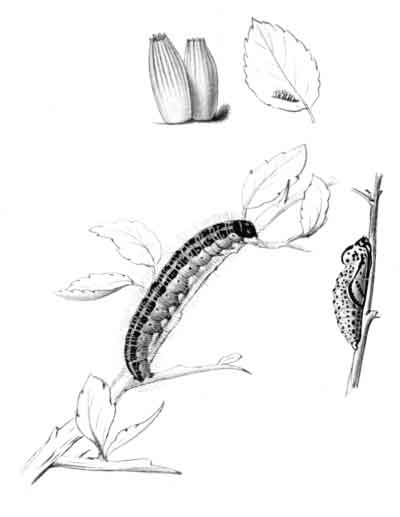
Pl. 3.
Black-veined White Butterfly.
Eggs, natural size and enlarged; caterpillar and chrysalis.
On Plate 1 three forms of the chrysalis are shown. The figures are drawn from specimens collected in Wicken Fen in October, 1905. Occasionally a much darker, nearly black, form is found.
This butterfly was known to Petiver and other early eighteenth-century entomologists as the Royal William. There is every reason to believe that at one time it was far more widely distributed in England than it now is. Stephens, writing in 1827, states that it was formerly abundant at Westerham, and gives several other localities, some very near to London.
During the last twenty-five years or so, the butterfly has been seen on the wing, from time to time, in various parts of the Southern and Midland counties. Caterpillars have also been found at large in Kent. Possibly attempts may have been made to establish the species in certain parts of England, and the presence of odd specimens in strange places may thus be accounted for. Or such butterflies may have escaped from some one who had reared them.
On the Continent the butterfly is common in woods as well as in meadows, and even on mountains up to an elevation of 5000 feet. It occurs also, but less commonly, at much higher altitudes. It therefore seems strange that in England it should be confined to the low-lying fens of Norfolk and Cambridgeshire. Such is the case, however, and a journey to one or other of its localities will have to be made by those who wish to see this beautiful creature in its English home.
It may be added that the geographical range of the butterfly extends eastwards through Asia as far as Japan. A form, known as the Alaskan Swallow-tail, is found in Alaska.
The following ten species belong to the Pierinæ, another sub-family of Papilionidæ.
The Black-veined White (Plate 4) may be at once recognized by its roundish white wings and their conspicuous veins, which latter are black in the male butterfly, and in the female brownish on the main ones (nervures) and black on the branches (nervules). As the scales on the wings are denser in the male than in the female, the former always appears to be the whiter insect. On the outer margin of the fore wings there are more or less triangular patches of dusky scales, and these in occasional specimens are so large that their edges almost or quite meet, and so form an irregular, dusky border to the fore wings. These patches are also present on the hind wings, but are not so well defined. Sometimes the patches are absent from all the wings. The fringes of the wings are so short that they appear to be wanting altogether. The early stages are figured on Plate 3.
The egg is upright and ribbed from about the middle to the curiously ornamented top, which appears to be furnished with a sort of coronet. The colour is at first honey-yellow, then darker yellow, and just before the caterpillar hatches, greyish. The eggs are laid in a cluster on the upper side of a leaf of sloe, hawthorn, or plum, etc., in the month of July.
The caterpillar when full grown is tawny brown with paler hairs arising from white warts; the stripes along the sides and back are black. The under parts are greyish. The head, legs, and spiracles are blackish. Caterpillars hatch from the egg in August, and then live together in a common habitation which is formed of silk and whitish in colour. They come out in the morning and again in the evening to feed, but a few leaves are generally enclosed in their tenement. In October they seem to retire for the winter and reappear in the spring. During May they become full grown and then enter the [Pg 33]chrysalis state. The butterflies are on the wing at the end of June and in July.
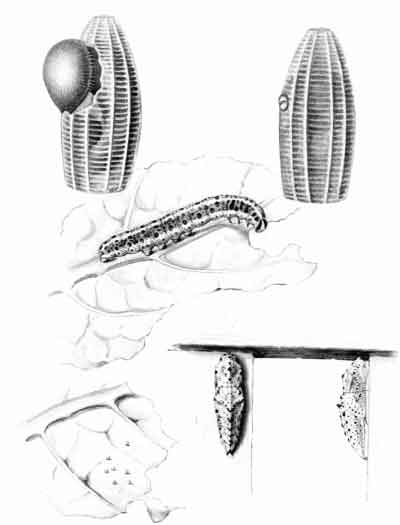
Pl. 5.
Large White Butterfly.
Eggs, natural size and enlarged; caterpillar and chrysalids.
The chrysalis is creamy white, sometimes tinged with greenish, and dotted with black.
This butterfly was mentioned as English by Merret in 1667, and by Ray in 1710. Albin in 1731, who wrote of it as the White Butterfly with black veins, figures the caterpillar and the chrysalis, and states that caterpillars found by him in April turned to chrysalids early in May and to butterflies in June. Moses Harris in 1775 gave a more extended account of the butterfly's life-history, and what he then wrote seems to tally almost exactly with what is known of its habits to-day. This species has seemingly always been somewhat uncertain in its appearance in England. Authors from Haworth (1803) to Stephens (1827) mention Chelsea, Coombe Wood in Surrey, and Muswell Hill in Middlesex, among other localities for the butterfly. It has also been recorded at one time or another, between 1844 and 1872, from many of the Midland and Southern counties. In 1867 it was found in large numbers, about mid-summer, in hay fields in Monmouthshire. The latest information concerning the appearance of the species in South Wales relates to the year 1893, when several caterpillars and four butterflies were noted on May 22 in the Newport district. At one time it was not uncommon in the New Forest, but no captures of the butterfly in Hampshire have been recorded during the last quarter of a century. At the present time it is probably most regularly obtained in a Kentish locality, presumably in the Isle of Thanet, which is only known to a few collectors. It may be mentioned that some thirty years ago caterpillars of the Black-veined White could be obtained from a Canterbury dealer at a few shillings per gross.
The species is widely distributed, and often abundant, on the Continent, and its range extends through Western and Northern Asia to Yesso, Northern Japan.
This butterfly is probably almost as familiar to those who dwell in towns as it must be to those who live in the country. It is perhaps unnecessary to describe it in any detail, and it may therefore suffice to say that it is white with rather broad black tips to the fore wings; there are some black scales along the front margin of these wings, and on the basal area of all the wings. The male has a black spot on the front margin of the hind wings, and the female has, in addition, two roundish black spots on the fore wings, with a black dash from the lower one along the inner margin.
As there is a rather important difference between the specimens of the spring (vernal) and the summer (æstival) broods, figures of a male and a female of each brood, and showing the upper and under sides, are given. Those on Plate 6 represent the spring form, which was at one time considered to be a distinct species, and named chariclea by Stephens. Plate 9 shows the summer form. The chief point of difference is to be noted in the tips of the fore wings, which in the spring butterflies are usually, but not invariably, greyish; in the summer butterflies the tips are black, as a rule, but not in every case.
Occasionally the black on tip of the fore wing in the female is increased in width, and from it streaks project inwards towards the upper discal spot. In some examples of the male there is a more or less distinct blackish spot on the disc of the fore wings. Very rarely the ground colour is creamy or sulphur tinted.
The greenish tinge about the veins, sometimes seen in these butterflies, is due to some accidental cause, probably injury to the veins.
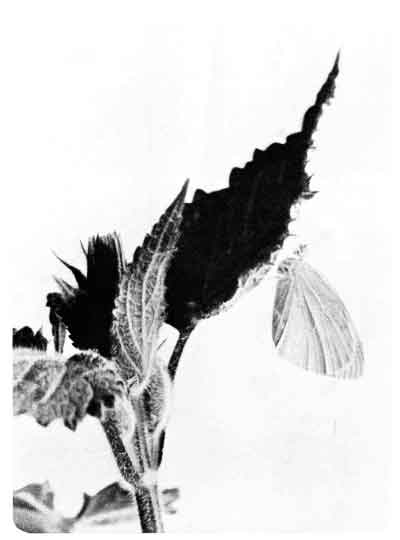
Pl. 7.
Small White Butterfly
Resting.
The egg is yellowish in colour, somewhat skittle-shaped, and very prettily ribbed and reticulated. On Plate 5 there are two figures of the egg from enlarged drawings by Herr Max Gillmer, to whom I am greatly indebted for the loan of them. In the figure on the right, the dark spot at the shoulder of the egg represents the head of the young caterpillar, and in that on the left is seen the caterpillar about to come out of the egg. The head is already out, and the jaws have left their mark on the egg-shell. Most caterpillars of the Whites, as well as those of other butterflies, devour their egg-shells.
The eggs are laid in batches of from six to over one hundred in each batch. They are placed on end, and on either side of a leaf, chiefly cabbage. Herr Gillmer writes that he watched a female depositing her eggs on a leaf of white cabbage in the hot sunshine, and found that she laid twenty-seven in about nine minutes. A previous observer had timed a female, and noted that she produced eggs at the rate of about four in the minute. Caterpillars hatch from the egg in about seven days in the summer. The caterpillar (Plate 5) when full grown is green tinged with blue or grey above, and greenish beneath. There are numerous short whitish hairs arising from little warts on the back and sides; the lines are yellow. The caterpillars feed in July, and sometimes again in September and October, on all plants of the cabbage tribe, and also on tropæolum and mignonette. A number of these caterpillars may often be seen crowded together on a cabbage leaf, and they sometimes abound to such an extent that much loss is sustained by growers of this most useful vegetable. A peculiarity of these caterpillars is that even when not numerous, their presence is indicated by an evil smell that proceeds from them. The unpleasantness of the odour is greatly intensified if the caterpillars are trodden upon.
The chrysalis (Plate 5) is of a grey colour, more or less spotted with black and streaked with yellow. It is often to be seen fixed horizontally under the copings of walls, the top bar of a fence, or a window-sill; but it sometimes affects [Pg 36]the upright position when fastened in the angle formed by two pales. A position that affords some measure of protection from weather is generally selected.
Although this butterfly is almost annually to be seen, in greater or lesser numbers, throughout the country, it is occasionally scarce, either generally or in some parts of the British Islands. For example, during the past year (1905) it was abnormally plentiful in Ireland, but at the same time comparatively rare in England. It is a migratory species, and no doubt its abundance in any year in these islands is dependent on the arrival of a large number of immigrants. Possibly in some years none of the migrant butterflies reach our shores, and that it is largely to this failure the rarity of the species in such years is to be attributed. Caterpillars resulting from alien butterflies may absolutely swarm in the autumn of one year, but the eccentricities of an English winter may be too much for the vitality of such of them as escape their enemies, Apanteles glomeratus, and other so-called "ichneumons," and reach the chrysalis state. So, with immigration on the one hand and destructive agencies on the other, it may be understood how it comes about that the Large White is sometimes abundant and sometimes scarce.
This species seems to range over the whole of the British Islands, with the exception, perhaps, of the Shetlands. Abroad, it has been found in all parts of the Palæarctic Region, except the extreme north, and Eastern Asia.
The Small White butterfly (Plate 11) is, perhaps, more often in evidence then its larger kinsman just referred to. It also is a migrant, and although it never seems to be absent from these islands, in its proper season, its great increase in numbers in some years is almost certainly due to the arrival of immigrants.
The spring form of this butterfly, named metra by Stephens, who, together with others, considered it a good species, has the tips of the fore wings only slightly clouded with black; and the black spots near the centre of the wings are always more or less faint in the male. Sometimes the central spot and also the blackish clouding of the tip are entirely absent. The summer brood, on the other hand, has fairly blackish tips and distinct black spots—one in the male and three in the female, the lower one lying on the inner margin. Occasionally examples of this flight bear a strong resemblance to the Green-veined White, the next species. The wings are sometimes, chiefly in Ireland, of a creamy colour, more especially in the female, or, more rarely, of a yellowish tint. In North America, where this species was accidentally or intentionally introduced some years ago, bright yellow forms are not uncommon in some localities, and the variety is there known as novangliæ.
In certain favourable years a partial third brood has occurred, but such specimens are often small in size.
The egg (Plate 8) is at first pale greenish, but later on it turns yellowish, and this tint it retains until just before the caterpillar hatches out.
The caterpillar when full-grown has a brownish head and a green body; the latter is sprinkled with black and clothed with short blackish hairs emitted from pale warts. There is a yellowish line on the back, and a line formed of yellow spots on the side. It feeds on most plants of the cabbage tribe, and in flower gardens on mignonette and nasturtiums. It is often attacked by parasites, and especially by the Apanteles, referred to as destructive to caterpillars of the Large White.
The chrysalis may be of various tints, ranging from pale brown, through grey to greenish; the markings are black, but these are sometimes only faint. It is to be found in [Pg 38]similar situations to those chosen by the caterpillar of the last species, but often under the lower rail of a fence or board of a wooden building. Where caterpillars have been feeding in a garden, they often enter greenhouses, among other places, to pupate; and where these structures are heated during the winter, the butterflies sometimes emerge quite early in the year. Distributed throughout the British Islands, except the Hebrides and Shetlands. It is common over the whole of Europe, and extends through Asia to China and Japan. In America, where it was introduced into the United States some forty-five years ago, it has now spread northwards into Canada, and also southwards.
This butterfly is not often seen away from its favourite haunts in the country; these are woods, especially the sunny sides, leafy lanes, and even marsh land. As in the case of the two Whites previously noticed, there are always two broods in the year. The first flight of the butterflies is in May and June, occasionally as early as April in a forward season. These specimens have the veins tinged with grey and rather distinct, but are not so strongly marked with black as those belonging to the second flight, which occurs in late July and throughout August. This seasonal variation, as it is called, is also most clearly exhibited on the under side. In the May and June butterfly (Plate 13, left side) the veins below are greenish-grey, and those of the hind wings are broadly bordered also with this colour. In the bulk of the July and August specimens (Plate 13, right side) only the nervures are shaded with greenish-grey, and the nervules are only faintly, or not at all, marked with this colour.
Now and then a specimen of the first brood may assume the characters properly belonging to the specimens of the second brood; and, on the other hand, a butterfly of the second brood [Pg 39]may closely resemble one of the first brood. As a rule, however, the seasonal differences referred to are fairly constant. By rearing this species from the egg it has been ascertained that part (sometimes the smaller) of a brood from eggs laid in June attains the butterfly stage the same year, and the other part remains in the chrysalis until the following spring, the butterflies in each set being of the form proper to the time of emergence.
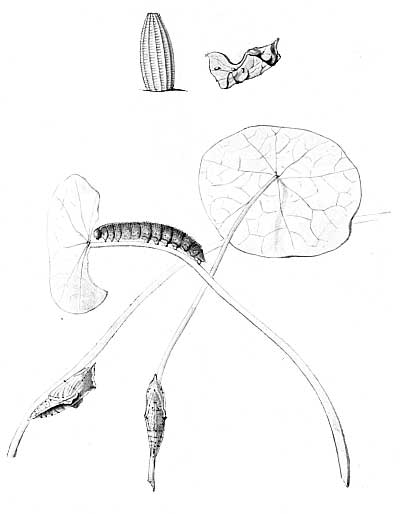
Pl. 8.
Small White Butterfly.
Eggs, natural size and enlarged; caterpillar and chrysalids.
The strongly-marked specimens (Plate 14) are from Ireland, and are of the first or spring brood. The seasonal variation in this species is not so well defined in Ireland as in England.
A form of variation in the female, and most frequent perhaps in Irish specimens, is a tendency of the spots on the upper side of the fore wings to spread and run together, and so form an interrupted band.
Specimens with a distinct creamy tint on the wings are sometimes met with, but such varieties, as well as yellow ones (var. flava, Kane), are probably more often obtained in Ireland and Scotland than in England. Occasionally male specimens of the second brood have two black spots on the disc of the wing. Some forms of this butterfly have been named, and these will now be referred to.
Sabellicæ (Petiver), Stephens, has been considered as a species distinct from P. napi, L. Stephens ("Brit. Entom. Haust.," I. Pl. iii., Figs. 3, 4) figured a male and a female as sabellicæ, which he states differs from napi in having shorter and more rounded yellowish-white wings. No locality or date is given in the text (p. 21) for the specimens figured; but referring to another example which he took at Highgate on June 4, he says that it agrees with his Fig. 2. Probably, however, it was his second figure that he intended, the Fig. 4 of the plate, which is a female. This is rather more heavily marked with dusky scales than is usual in specimens of the first brood, at least in England, although it agrees in this respect with some Irish June examples. [Pg 40]Fig. 3 represents a male which certainly seems to be referable to the spring form. Most authors give sabellicæ; as belonging to the summer flight, but this does not seem to be correct.
Var. napææ is a large form of the summer brood, occurring commonly on the Continent, in which the veins on the under side of the hind wings are only faintly shaded with greenish-grey. Occasionally specimens are taken in this country in August, which both from their size and faint markings on the under side seem to be referable to this form.
Var. bryoniæ is an Alpine form of the female, and in colour is dingy yellow or ochreous, with the veins broadly suffused with blackish grey, sometimes so broadly as to hide the greater part of the ground colour. This form does not occur in any part of the British Islands, but some specimens from Ireland and from the north of Scotland somewhat approach it.
All the early stages are shown on Plate 10.
The egg is of a pale straw colour when first laid, but it soon turns to greenish, and as the caterpillar within matures, the shell of the egg becomes paler. The ribs seem to be fourteen in number.
The eggs are laid singly on hedge garlic (Sisymbrium alliaria) and other kinds of plants belonging to the Cruciferæ. The egg in the illustration was laid on a seed-pod of hedge garlic, but the caterpillar that hatched from it was reared on leaves of garden "nasturtium" and wallflower.
The caterpillar when full grown is green above, with black warts, from which arise whitish and blackish hairs. There is a darker line along the back, and a yellow line low down on the sides. Underneath the colour is whitish-grey. The spiracular line is dusky, but not conspicuous, and the spiracles are blackish surrounded with yellow. It has been stated that caterpillars fed upon hedge garlic and horseradish produce light butterflies, and that those reared on mignonette and watercress produce dark butterflies. Barrett mentions having reared a[Pg 41] brood of the caterpillars upon a bunch of watercress placed in water and stood in a sunny window, but he does not refer to anything peculiar about the butterflies resulting therefrom. He states, however, that from eggs laid in June the earliest butterfly appeared within a month, and the remainder by the middle of August, only one remaining in the chrysalis until the following June.
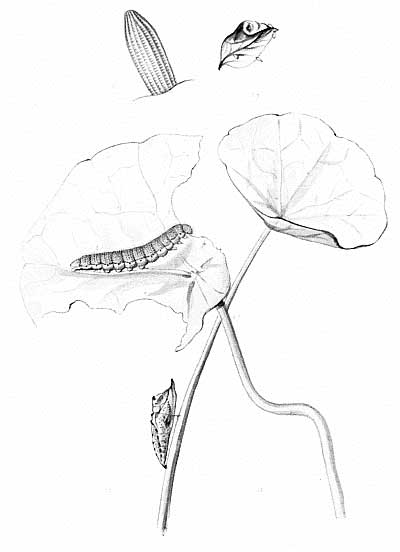
Pl. 10.
Green-veined White Butterfly.
Eggs, natural size and enlarged; caterpillar and chrysalis.
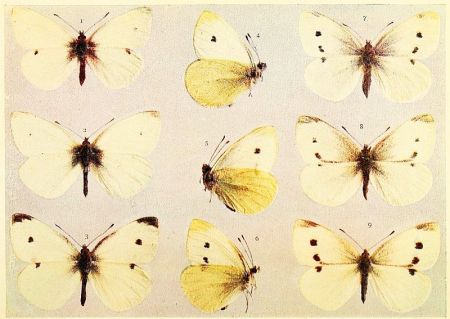
Pl. 11.
Small White Butterfly.
1, 2, 4 male (spring), 3 do. (summer); 5, 7, 8 female (spring),
6, 9, do. (summer).
Caterpillars may be found in June and July and in August and September.
The chrysalis is green in colour, and the raised parts are yellowish and brown. This is the most frequent form, but it varies through yellowish to buff or greyish, and is sometimes without markings.
Generally distributed throughout the British Islands, but its range northwards does not seem to extend beyond Ross.
In Europe it is generally common, and extends through Western and Central Asia to Siberia, and, according to Leech, is found in North Japan. In Amurland and Corea it is represented by the form orientis, Oberth. It occurs in North-West Africa, the Canary Isles, and the Azores. In America it is found in the Northern States and in California.
The Bath White (Plate 14) is such a rare visitor to this country, that any one who captures a specimen may congratulate himself on the event. During the whole of the last century not more than sixty specimens seem to have been recorded as taken in England, and ten of these were captured between 1895 and the present time. Nearly all of these were netted on the south or south-eastern coast, and in the months of July or August, but chiefly the latter. The occurrence of specimens in May or June appears to be quite exceptional.
Although it might be passed over for a Green-veined White, [Pg 42]or other common butterfly, when seen on the wing, it is very different from any of our other species when seen at close quarters. In the greenish mottling of the under side of the hind wings, the male has some likeness to the female Orange-tip, but on the Bath White the green is heavier and less broken up. On the upper side of the fore wings the black markings comprise a spot, sometimes divided, at the end of the cell, and a patch on the tips of the wings; the latter enclose spots of the ground colour. The markings of the under side show through blackish on the upper side of the hind wings. The female differs from the male in having a black spot between veins 1 and 2 of the fore wings, and the markings of the hind wings are blacker, especially on the outer area.
The egg is stated by Buckler to be of a bright pinkish-red colour, agreeing in this respect, as well as in size, with the anthers of the flowers of mignonette, upon which plant it is laid in an upright position. The shape is compared to that of an acorn without the cup, and it has twelve or fourteen rather prominent ribs.
The full-grown caterpillar is bluish-grey, dotted with glossy black warts, from each of which there is a short blackish hair. The lines along the back and sides are yellow, or white spotted with yellow. Head yellowish, dotted with black, and hairy. August and September. It feeds on garden as well as wild mignonette (Reseda).
The chrysalis is at first similar in colour to the caterpillar, but it afterwards becomes whitish. It has numerous black dots, and is marked with yellow along the sides and on the back of the thorax.
The above descriptions are abridged from Buckler's more detailed account of the life-history of this species. Of the caterpillars resulting from thirty-three eggs, only two attained the chrysalis state, in September. One of these turned black and died in November, and from the other a butterfly emerged [Pg 43]in the following June. The figures of caterpillar and chrysalis on Plate 12 are from Buckler's "Larvæ."
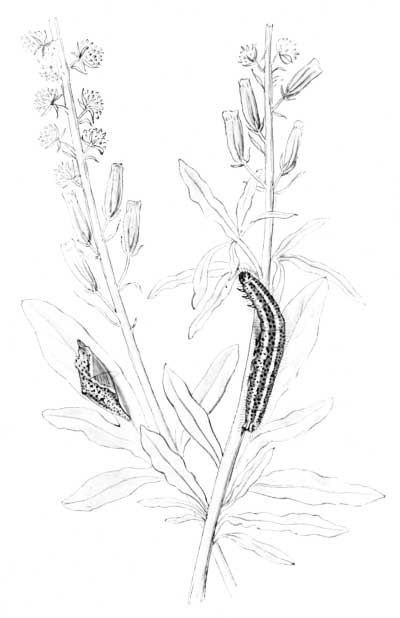
Pl. 12.
Bath White Butterfly.
Caterpillar and chrysalis (after Buckler).
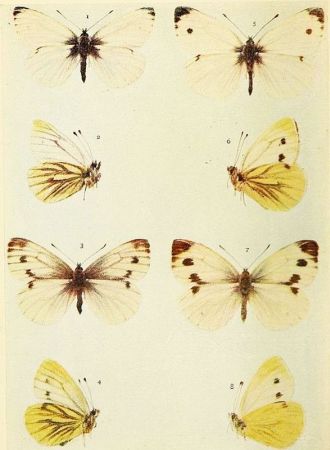
Pl. 13.
Green-veined White Butterfly.
1, 2 male (spring), 5, 6, do. (summer); 3, 4 female (spring), 7, 8 do. (summer).
It has been suggested that specimens taken in July and August are the offspring of immigrants that arrive here in May, but there is no conclusive evidence of this. It has, however, been proved that our climate is not suitable for the permanent establishment of the species here.
The earliest writers on English insects called this butterfly "Vernon's Half Mourner," or "The Greenish Half Mourner." It was first mentioned by Petiver, some two hundred years ago, and about that time only two British specimens were known. One of these was taken in Cambridgeshire, and one at Hampstead. According to Lewin, who wrote about it in 1795, the name "Bath White" was given to the butterfly "from a piece of needlework executed at Bath by a young lady, from a specimen of this insect, said to have been taken near that place." In 1796 Donovan only knew of the Bath specimen; and in 1803 Haworth mentions a faded specimen taken in June at Gamlingay in Cambridgeshire.
The species is more or less common in many parts of Europe, but it seems to be most at home and abundant in the south. Its range extends to North Africa, Madeira, the Canary Isles, and the temperate parts of Asia, including Northern China and Corea.
This butterfly (Plate 17), as its name suggests, has a large patch of orange colour on the outer third of its white, or creamy white, fore wings, and the extreme tip is blackish; at least, this is so in the male. The female is without the orange patch, and this is replaced by a smaller one of blackish-grey. The lower portion of this patch is broken up by the ground colour, and by white spots on the outer margin and around the tips of the [Pg 44]wings. The hind wings, in both sexes, appear to be dappled with greyish-green, and this is caused by the green marking on the under surface of the wings showing through. Some specimens, chiefly from Ireland, have all the wings in the male, and the hind wings in the female, distinctly tinged with yellow. The discal black spot varies in size and in shape; often it is roundish, and sometimes it is crescent-like. It is always larger in the female than in the male, and may be entirely absent in the latter sex; but this probably occurs very rarely. Usually the orange patch of the male extends very near to the inner angle of the wing, but sometimes it is continued through to this point. It ranges in colour from deep to pale orange, and occasionally to almost yellow. Small specimens, some not more than one inch and a quarter in expanse, occur from time to time. In these dwarfs the orange patch does not reach beyond the black discal spot, which in normal specimens it usually does. This small form has been considered a distinct species, and the name hesperidis has been proposed for it. Female specimens with splashes or streaks of the male colour on the upper or the under sides have been noted not infrequently; and more rarely specimens with one side entirely male and the other entirely female have been taken.
The egg (Plate 15), when freshly laid, is whitish, faintly tinged with greenish; it soon changes to yellow, and, later on, turns orange and then dark violet. When the latter colour appears, the little caterpillar may be expected to hatch out very shortly. The eggs are placed upright on the foot-stalks of the flowers, and may be readily found in June by searching the blossom-clusters of hedge-mustard or cuckoo-flower.
The caterpillar, when mature, is dull bluish-green, with raised dots and warts; from the former arise whitish hairs, and from the latter longer blackish hairs. There is a white line, or stripe, along the sides, and the underparts of the body are greener than the back. Both in colour and marking the [Pg 45]caterpillar agrees so closely with the seed-pods of its food-plant that its detection is not always easy. A peculiarity in very young caterpillars of this species, and also those of some of the "Whites," is, that the hairs are forked at the tips, and bear globules of moisture thereon (see figure and remarks on p. 3).

Pl. 14.
Green-veined White (Irish).
1 male; 2, 3 female.
Bath White.
4, 5 male; 6 female.
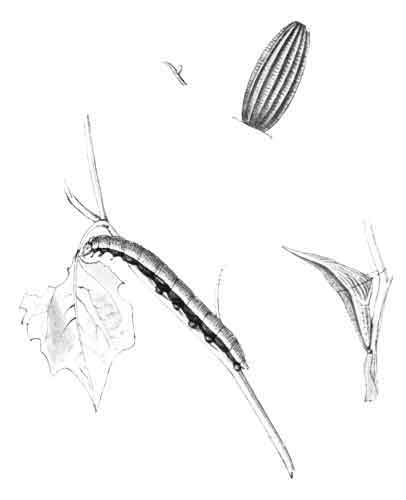
Pl. 15.
Orange-tip Butterfly.
Egg, natural size and enlarged; caterpillar and chrysalis.
The caterpillars feed in June and July on lady's smock or cuckoo-flower (Cardamine pratensis), charlock (Brassica sinapistrum), hedge-mustard (Sisymbrium officinale), garlic mustard (S. alliaria), rock-cress (Arabis), horseradish (Cochlearia armoracia), dame's violet (Hesperis matronalis), watercress (Nasturtium officinale), etc.
The chrysalis, as will be seen from the figure (Plate 15), is curiously elongated, and tapers towards each end; the outline of the back is curved, and the wing-cases bulge out into an angle about the middle of the under side. The colour is pale grey or whitey-brown, sometimes with a strong rosy tinge; the back is speckled with brownish, and has an olive-grey dorsal line, and the veins of the wings are well defined. This stage lasts, as a rule, from August of one year until May of the following year. When the chrysalis is first formed, it is green, with the wing-cases brighter, and this colour is sometimes retained. It has been stated that the chrysalids assume the colour of their immediate surroundings, and this may be so; but all that I have had under observation were of the colours described above, although some were fastened to green stem, others to muslin, and others, again, to glass.
Towards the end of May and in June is the usual time for this butterfly to be on the wing. It has, however, been noticed as early as about the middle of April, and as late as the middle of July, and rarely in August and September. The specimens, seen in the last-mentioned months, may have represented a second brood, and, if so, a very unusual event. Possibly, however, they may have been specimens whose emergence had for[Pg 46] some reason not understood, been retarded. There is at least one record of the insect remaining in the chrysalis for two winters.
Although generally distributed throughout England, Wales, and Ireland, and occurring in Scotland as far north as the Caledonian Canal, it seems to be more common in some districts than in others. Abroad, its range extends over Europe, and through Asia as far east as Amurland and China.
The graceful little butterfly figured on Plate 19 is creamy white, with a rather square black or blackish spot on the tip of the fore wings of the male. In the female the spot is reduced to some blackish scales on and between the veins. Occasionally there is a second brood in the year, and the specimens of this flight have smaller and rounder black spots in the males, and almost none at all in the females. Specimens of the female sex entirely devoid of black marking are referable to var. erysimi (see fourth figure in second row, Plate 16). Series of each brood are shown on Plate 16, which is reproduced from a photograph by Mr. Hamm. The lower specimen in each series has been reversed to show the seasonal variation of the under side. The row of specimens on the left are of the first brood, and the second and last examples in this series show the characters of var. lathyri—black tips to the fore wings, and dusky band-like shades on the hind wings; the under sides of the hind wings dull greenish—to which form a good many of our spring specimens belong. The specimens of the second generation are referable to var. diniensis. The species is sometimes referred to Leptosia, Hüb.
The egg, which is figured on Plate 18, is yellowish-white in colour; it is ribbed, and rather glassy in appearance. The caterpillars have been known to hatch out about a week after the eggs were laid.
The caterpillar when full grown is, according to Hellins, "a beautiful green, the front segments minutely dotted with black; dorsal line darker green, edged with yellowish-green; spiracular line distinct, of a fine clear yellow, edged above with darker green; spiracles indistinguishable." The chrysalis in shape is something like that of the last species, but the back is not curved, and the ends are less tapered. The colour is a "lovely delicate green; the abdomen rather yellowish; just in the spiracular region there runs all round the body a stout pink rib, enclosing the greenish spiracles; from this a strong pink line branches off, bordering the outer edge of the wing-case, and the nervures of the wings themselves are delicately outlined in pink" (Hellins). Sometimes the chrysalids are green without marking.
Mr. A.M. Montgomery, who on one occasion had four batches of eggs, and the subsequent caterpillars, under observation, states that the caterpillars hatched about June 2 from eggs laid about May 22. Pupation took place about July 3, and, except from one batch that remained for the winter in the chrysalids, the butterflies emerged between July 16 and 22. The food-plant in this case was bird's-foot trefoil (Lotus corniculatus). The yellow pea (Lathyrus pratensis) is a favourite pabulum, but the caterpillar will also eat a vetch (Vicia cracca), and probably many other plants belonging to the order Leguminosæ. Caterpillars from the July butterflies would feed in August and September.
This fragile-looking little species is somewhat local, but is not altogether uncommon in some of its particular haunts. As its English name implies, the butterfly is fond of the woods, or, perhaps, is rather more partial to their shady rides and margins. On dull or wet days, it settles on the under side of a leaf. The first brood is on the wing in May, and the second—when this occurs, which is not every year—in July and August. In Ireland, where it is abundant in the south and [Pg 48]west, there seems to be only one flight, and this is in June. It may be well to remember that this butterfly does not like the pill-box, and will not settle down quietly therein.
Possibly the Wood White had a much more general distribution in England at one time than it now seems to have. It was not uncommon in parts of Sussex some years ago, but there appears to be no record of its occurrence there now. It is certainly much scarcer in the New Forest than it used to be. However, it is still to be found, no doubt, in many parts of England and Wales, but chiefly perhaps in the counties of Berkshire, Devonshire, Cornwall, Worcestershire, Herefordshire, Lancashire, and Cumberland. Also in the south and west of Ireland. It occurs throughout Europe, Western and Central Asia, and its range extends eastwards through Siberia, Amurland, China, and Corea to Japan.
This usually scarce butterfly (Plate 21) is of a primrose-yellow colour in the male, and, as a rule, almost white in the female; sometimes the latter sex is of the yellow male colour. The outer margin of the fore wings is broadly black in both sexes, but there are some more or less united spots of the ground colour in the black towards the tips of the wings, and below vein 3 the black is usually confined to the outer margin. There is a black spot near the middle of the wing, and some blackish dusting quite near the base of the wing. The hind wings have a pale orange central spot, sometimes two spots, and the blackish border on the outer margin is generally narrow, and often interrupted or broken up into spots. The fringes of all the wings are pinkish, as also are the antennæ. The egg is pearly yellowish-white when first laid; a few days later the top becomes transparent, white, and glassy, shading downwards into yellow, and then clear rosy orange; the base is [Pg 49]pale, but less transparent than the top. It has a number of transverse ribs, ranging from nineteen to twenty-two. Before the caterpillar hatches out, the egg changes to a purplish leaden colour.
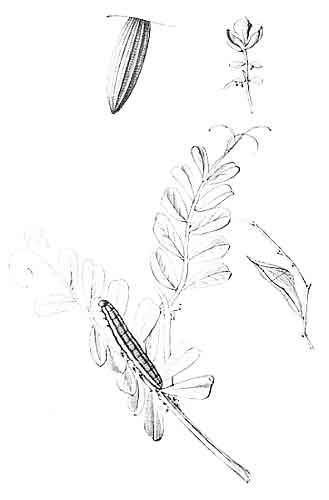
Pl. 18.
Wood White Butterfly.
Eggs, natural size and enlarged; caterpillar (after Buckler) and chrysalis.
The caterpillar in October, before hibernation, is about a quarter of an inch long, and deep clover-green in colour; it has a number of pale, shining warts along the back, from each of which there is a moderately long black bristle, and there is a pale yellowish-white stripe above the black spiracles. The head is pale ochreous green, with warts and bristles as on the body. It rests upon a pad of silk spun on the centre of a leaflet. When full grown the colour is clear light green, but has a darkish velvety appearance, due to the entire surface being densely sprinkled with black warts, the bristles from the warts on the back are black, and those on the lower surface are white, the line above the spiracles, which are white outlined with black, is made up of lemon-yellow, orange-vermilion, and orange with an upper border of white. The head, claspers, and legs are green. It feeds in June, and again in August, on clover, trefoil, etc. The figure on Plate 20 is after Hübner.
The chrysalis is very similar to that of the Clouded Yellow, the chief differences are that the head-beak of the present species is straight instead of being slightly upturned, and the tip of the wing-case extends further down the body.
The above particulars of the early stages of the Pale Clouded Yellow are adapted from Mr. Frohawk's account of the life-history of the species (Entomologist, 1892 and 1893).
From eggs laid in September by a captured female, Mr. Williams reared two butterflies in November of the same year. Other caterpillars from the same batch of eggs hibernated and recommenced feeding in the spring, but failed to attain the chrysalis state. Young caterpillars from eggs obtained in August were successfully hibernated by Mr. Carpenter, and many of these produced butterflies in the following May.
In rearing this species from eggs laid in the autumn, a fairly dry treatment appears to be the best. Protect the young caterpillars from frost, and do not water the plants during the winter. When they become active again, about February, transfer them to other growing plants, which should be kept ready for the change. Do not water the plants much, or wet the foliage at all, and keep a sharp look-out for earwigs.
It seems pretty clear that this species passes the winter as a caterpillar, and from the evidence available it appears equally certain that the caterpillars would not survive an ordinary winter in this country. Possibly, however, in very mild winters, or in certain warm nooks on the south coast, some may be able to exist until the spring, and then complete their growth and reach the butterfly state. In such native-born butterflies the ancestral migratory habit may be lost, owing to climate, and they would not, therefore, wander far from the spot where they emerged from the chrysalis, but found a colony, which probably would be cleared off sooner or later by the severity of an English winter.
The Pale Clouded Yellow was not mentioned as an English butterfly until Lewin wrote about it in 1795. He states that he only met with it "in the Isle of Sheppey and on a hilly pasture-field near Ospringe in Kent." He seems to have noted it in different years at both places. Stephens, in 1827, referred to it as a rare British species, and from that date until 1867 it seems to have been common only in 1835, 1842, 1857, and 1858. In 1868 it was abundant in the southern and eastern counties, and was observed as far north as Lancashire and Yorkshire, also in Ireland. It was common on the south coast in 1872, and rather more so in 1875, when it spread into Essex and Suffolk, and also inland. Until 1875 the butterflies seem only to have been noticed in the autumnal months, but in that year specimens had been seen in May and June. In 1876 the species was pretty plentiful, but after that date it did not again [Pg 51]occur in numbers until 1892, when it was recorded from most of the southern and eastern counties. In 1893 one or two specimens were reported as seen in April or May, but less than a dozen were recorded as captured during the autumn of that year. Not much was seen of the butterfly again until 1899, when a score or so were recorded from Kent. Two or three specimens were seen on the south coast in June, 1900, and the species was plentiful in the autumn of that year in many parts of the country. Single specimens were seen in June, 1901, and in the autumn the butterfly was again fairly common in several southern counties, and abundant in parts of Essex. In 1902 a male was taken near Dartford in March, and one example in May in a locality where two specimens had been captured on October 20 of the previous year; six males and one female were obtained between June 27 and July 12 at Sheerness. The summer of 1902 was a cold one, and, with the exception of four specimens at Folkestone in August, the species was not again seen during that year or the following one; but in 1904 a good many specimens were secured at Chatham in September, and one or two at Margate in August.
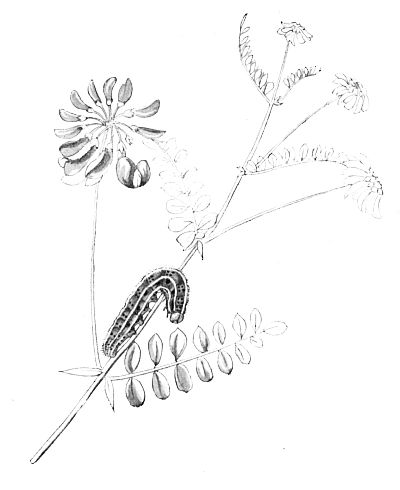
Pl. 20.
Pale Clouded Yellow Caterpillar.
(After Hübner.)
When it occurs in this country the butterfly should be looked for in clover and lucerne fields.
Common throughout the Palæarctic Region. It is probably a species of Eastern origin, but with a tendency to spread westward.
In its typical colouring—orange with broad black borders—this butterfly (Plate 22) will be recognized the first time it is seen. Both sexes have a black spot about the centre of the fore wings, and a deep orange spot near the middle of the hind wings—the latter is subject to variation in size and shape. The [Pg 52]female usually has the black borders spotted with yellow, but in some examples these spots are almost (Plate 24, Fig. 1) or quite absent. Another form of the female, known as var. helice (Plate 24, Fig. 2), has the orange colour replaced by yellowish-white, and in some years is not altogether uncommon. Between this yellowish-white at one end of the colour range and the typical orange at the other, specimens showing all the intermediate shades have been obtained, chiefly by rearing the butterflies from eggs laid by a female helice. One of these intergrades will be seen on Plate 24, Fig. 3. The males vary, especially bred ones, from "deep rich orange to the palest chrome yellow; the marginal bands also vary in width; in many examples the yellow nervules run through the borders of all the wings. A large proportion of the males have the hind wings shot with a beautiful amethystine blue" (Frohawk).
The egg (Plate 23) is oval, tapering towards each end, very pale yellowish in colour at first, but afterwards becoming darker yellow, and then pink. The eggs are laid, as shown in the figure, on the upper side of a leaf of clover or lucerne, sometimes singly, but often in small batches.
The caterpillar when full grown is deep green with minute black dots, from which fine hairs arise, and a pink-marked yellow, or whitish, spiracular line. The head is also green, rather downy, and small in size. When first hatched the caterpillar is brownish, but soon changes to greenish. It feeds on clover (Trifolium), trefoil (Lotus), melilot (Melilotus), etc., in June and again in September or October.
The chrysalis is yellowish-green above, somewhat paler below; the wing-cases are rather deeper in tint than the thorax and back, and have a central black speck and a row of slender marks at the edges. The body is marked with a splash of reddish and tiny black dots on the under side. The beak-like projection from the head is dark green above and yellow beneath.
The figures of the caterpillar and the chrysalis are taken from Buckler's "Larvæ of British Butterflies," and the descriptions of these stages by the same author have been followed.
The Clouded Yellow has a great fancy for clover or lucerne fields, and should be looked for in such places in August and September. It is not very difficult to rear from the egg, so that if a female is captured in August (the spring ones should not be taken), it would be a good plan to try to induce her to lay some eggs. The best method to succeed in this is to pot up a growing plant of clover, and over this place a glass cylinder with a muslin cover. (See further directions in the Introduction, page 28.)
This butterfly, which was known, to the earliest English authors as the "Saffron" or "Spotted Saffron," has always, no doubt, been erratic and uncertain in its appearance in this country, sometimes becoming increasingly abundant for three, four, or even five years in succession, and then scarce or entirely absent for similar periods. The most recent years of plenty, or when it was fairly common, were 1877, "the great Edusa year," 1892, 1893, 1894, 1895, 1899, 1900, and 1902. In some of these years the Pale Clouded Yellow was also common.
In some of the warmer countries that this butterfly inhabits it has certainly three, and possibly four, broods in the year. It is therefore conceivable that at times its increase in numbers may become very great in some particular area. At such times swarms of the surplus butterfly population set out to seek fresh fields and pastures new. Some portion of these flights reach our country from time to time, and this probably always occurs in the spring of the year. The weather conditions being favourable, the offspring of the visitors put in a welcome appearance in the autumn, and not only gladden the heart of the entomologist, but add a charm to the countryside which every one can appreciate.
The butterfly has probably occurred, at some time or other, [Pg 54]in almost every county in England and Wales, Ireland and Scotland, extending even to the Orkney Islands (1877).
Its home appears to be in North Africa and South Europe, whence it spreads over the greater part of Europe and Western Asia.
Note.—According to Kirby, this butterfly should be called Eurymus hyale, Linn., and the Pale Clouded Yellow be known as Eurymus kirbyi, Lewis.
This butterfly (Plate 26) has the tips of the fore wings sharply pointed, and there is a rather acute angle about the middle of the outer margin of the hind wings. The colour of the male is bright sulphur yellow, with a central orange spot on each wing, that on the hind wings usually the largest; there is also a rusty dot at the outer end of the upper veins and along the front margin of the fore wings towards the tip. The female is greenish yellow, and is marked similarly to the male. In both sexes the horns (antennæ) are reddish, and the long silky hair on the thorax is a noticeable character. It is probably this insect to which the name "butter-coloured fly," contracted into butterfly, was first given; anyway, it is the only species to which the name applies so well.
The egg. If the under sides of the leaves of buckthorn (Rhamnus catharticus) or of the berry-bearing alder (R. frangula) are examined in May or June, the eggs of this butterfly may be found thereon. They are often placed on a rib of the leaf, but sometimes they are laid as shown in the illustration (Plate 25). At first the colour is pale greenish and rather glossy, but it soon changes to yellowish, and later on, when the caterpillar has formed inside, to a dull purplish-grey.
The caterpillar when full grown is green, merging into bluish-green on the sides, thickly powdered with shining black [Pg 55]specks. There is a pale line on each side below the spiracles. It feeds in June and July on both kinds of buckthorn, and will generally be found resting along the main rib of a leaf.
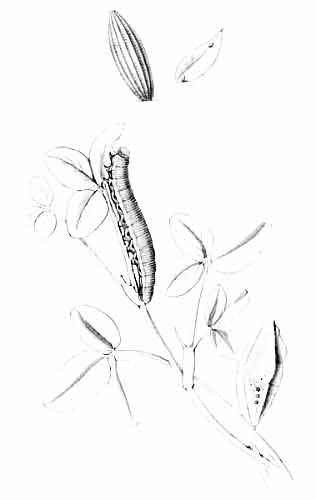
Pl. 23.
Clouded Yellow.
Eggs, natural size and enlarged; caterpillar and chrysalis.
The chrysalis is bluish-green in colour and of a curious shape. The sharp yellowish and brown beak-like projection in front and raised brownish bases of the wing-covers, together with the humped thorax, somewhat resemble a bird's head when seen from the front. Then, again, the enlarged wing-cases, which are rather greener than the other parts, in conjunction with the general outline, give a very good imitation of a curled leaf.
The butterfly is very constant as regards colour and marking, but occasionally the fore wings may be more or less suffused with orange, and in this respect assumes the coloration of the South European species known as G. cleopatra. The attempt has been made to establish the last-named butterfly in Ireland, but the experiment seems to have been only partially successful. Sometimes female specimens are found to have splashes of the male colour on their wings. Occasionally their colour is intermediate between their own proper tint and that of the male, and more rarely the wings on one side may be yellow, as in the male, while those on the other side are greenish, as in the female. Such specimens are termed gynandrous examples, and sometimes hermaphrodites. The latter, however, is not correct.
An unusual variation of the butterfly is shown on Plate 27. This has large oval pale brownish-orange marks on the under side of the wings. It was taken in the New Forest.
The Brimstone butterfly enjoys a longer existence in the perfect state than any of the other British species, with the exception, perhaps, of the Tortoiseshells and their allies. It leaves the chrysalis at the end of July or beginning of August, and is usually quite common during the latter month. After this it takes up its winter quarters, from which, however, it may be tempted to come out whenever the day is sufficiently[Pg 56] warm and sunny for it to indulge in a few hours' flight. The fine condition of some of the specimens that are seen in May or June has suggested the possibility of such specimens having remained in the chrysalis during the winter, but it is not at all probable that they do so. It may be seen any sunny day from March, or even February, to June in almost every English and Welsh county where its food-plant grows, and locally in Ireland. The best time to take specimens is in the autumn, when they are often to be seen in numbers flying along the rides in or on the outskirts of woods, and also in clover fields.
Distributed over the whole of temperate Europe, and extending through Asia to the far east and to North Africa.
The thirty butterflies now to be considered belong to the Nymphalidæ, which has a larger membership than any other family of butterflies. It is divided into several sub-families, but only four of these concern us; these are Apaturinæ (1 species), Nymphalinæ (17 species), Danainæ (1 species), and Satyrinæ (11 species). The next butterfly is our only representative of Apaturinæ.
On account of its large size and the beautiful purple sheen over its brownish-black velvety wings, this butterfly (Plate 29) is always counted a prize by the collector. It is, however, only the male that dons the purple, and he only when seen from the proper angle. The female is without the purple reflection and her wings are browner, but the white spots on the fore wings and the white bands on the hind wings are rather wider than those of the male. Above the anal angle of the hind wings, in both sexes, there is a black spot, ringed with tawny and sometimes centred with white, and a tawny mark on veins 1 and 2. As will be seen on turning to the figures on [Pg 57]Plate 31, the under side of this butterfly is exceedingly pretty. On the same plate there is a figure of the rare variety known as iole (for the loan of which I am indebted to Mr. Sabine), in which most of the white spots are absent or obscured. Intermediates between this extreme form and the type also occur, but all such aberrations are uncommon.
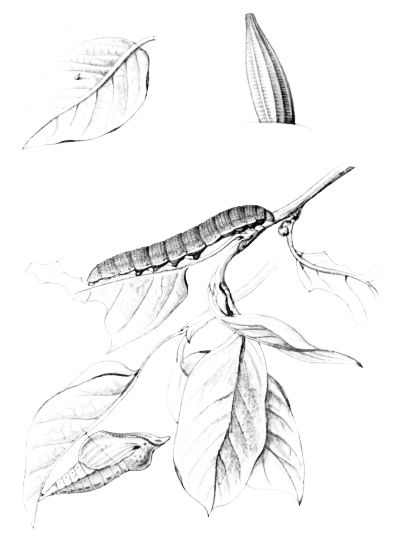
Pl. 25.
Brimstone Butterfly.
Egg, natural size and enlarged; caterpillar and chrysalis.
The egg (Plate 28) may be looked for in August on the upper surface of a leaf of the sallow (Salix caprea). According to Buckler, it is pale olive green in colour, and cylindrical in shape; the height from base to top being about equal to the width through from side to side. It has about fourteen ribs.
The caterpillar in October, just before hibernation, is dingy green roughened with numerous whitish warts from which arise short bristles, some of the latter appearing to be tinged with reddish, and those along the sides longer than those on the upper part of the body; the straight lines along the back and the oblique ones on the sides are yellowish. The head and the two horn-like projections, reminding one of the horns of a slug, are reddish-grey and covered with warts and bristles. The anal points (tails), which lie close together, are tipped with reddish. It should be mentioned here that on emerging from the egg the young caterpillar is without horns; these are not developed until the first skin is thrown off, which event happens from eight to twelve days after hatching.
The full-grown caterpillar is green, merging into yellowish towards the anal points (tails); the oblique stripes on the sides are yellowish, edged with reddish. The individual depicted on the plate took up a position for change to the chrysalis on June 6. It spun a mat of silk to the under side of a sallow leaf, and the next day it was found suspended by the claspers, which were grasping the silken mat. On the fourth day the chrysalis was fully developed, and from this a male butterfly emerged on June 24, an unusually early date.
The chrysalis is whitish, more or less tinged with green, but having the oblique lines on the sides whitish; the veins of the wings also show up whitish.
The caterpillar was well known to entomologists in this country as far back as 1758, when, in May, four were obtained from sallow at Brentwood in Essex. It usually occurs on sallow, but an instance is recorded of it refusing to eat this plant; it would probably have starved if willow, upon which it fed up, had not been substituted. A full-grown caterpillar was on one occasion found at Raindene in Sussex on poplar, which is a well-known food of the species on the Continent. Now and then a full-grown caterpillar has been met with in October, and Buckler reared two in the autumn from the egg almost to the chrysalis stage, but they died before the change was effected.
As befits his rank, the Emperor has lofty habits, and after quitting the clump of sallow bushes, among which its transformations from egg to the perfect insect were effected, it resorts to the oak trees, around which it flies in July, and, when not so engaged, rests on a leaf of the higher branches. To capture the butterfly, when seen at such times, is not altogether an easy matter, as for the purpose the net must be affixed to the end of a pole about 14 or 15 feet in length. The insect's rather depraved taste for the juices of animal matter, in a somewhat advanced stage of decay, is a fact well known to the professional collector and others who have taken advantage of it to the monarch's destruction. This method of attracting a butterfly for the purpose of capture is, however, not exactly to be commended. It surely is a greater pleasure to show one's friends a single specimen that has been captured by dexterity with the net, than to exhibit fifty that were secured by a device which is not only unsavoury, but unsportsmanlike. The female, however, is not to be allured; she must be sought among the sallows, and when seen is not easy to net, as she skims away over the tops of the bushes and is difficult to follow.

Brimstone Butterfly. Underside (aberration).

Pl. 27.
Common Blue. At rest.
Although most certainly not so common or so generally distributed as in former times, the butterfly still occurs in the larger oak woods in most of the midland, western, and southern counties of England, but is, perhaps, most frequent in Lincolnshire and Northamptonshire. In Wales it is found in Monmouthshire. It has not been recorded from Scotland, and only doubtfully from Ireland.
In Central Europe it is often abundant, and its range extends eastward into Amurland, Central and Western China.
Now follow seventeen butterflies of the sub-family Nymphalinæ.
The "White Admirable Butterfly," as it was called by some of the older English entomologists, needs only to be seen to be at once recognized (Plate 33). The white markings on its blackish wings are somewhat similar to those of the Purple Emperor. As in that butterfly, so, too, in this, the most beautiful ornamentation is found on the under side. The shape of the wing is, however, very different in the two butterflies, and there is no probability of confusing one with the other. A somewhat uncommon form is shown on Plate 31 (also kindly loaned by Mr. Sabine); this is var. nigrina. Intermediates also occur, but these, too, are also rather rare. The eggs, which I have not seen, are stated to hatch in about fourteen days, and are laid in July. They have been described as pale green in colour, and of the shape of an orange, but flatter at the base and top.
The caterpillar (Plate 30) when full grown is dark green on the back and lighter on the sides, roughened with yellow dots, and with a yellow-marked white line above the feet. The bristly spines are reddish with pinkish tips, and those on the second, third, fifth, tenth, and eleventh rings are longer than [Pg 60]the others. The first ring seems to be without spines, but the brownish head is set with short ones, two on the crown being rather longer and blacker than the others, and are inclined backwards.
In the autumn, when still quite tiny, it constructs a winter retreat (hibernaculum) (Plate 30) by fastening a growing leaf of sallow to a twig with silken threads, and then, using more silk, it draws the edges of the leaf together, and so forms a secure chamber wherein it can rest until the following spring, when it quits the domicile and sets to work on the tender foliage around it. At this time the caterpillar is brownish in colour. The chrysalis is of the remarkable shape shown on the plate. It is brownish, with purplish or olive tinge; behind the rounded hump there is a patch of bright green, and above the wing-cases a beautiful golden sheen. There are also other metallic spots and dots on various parts. Altogether, it is one of the prettiest of British butterfly chrysalids.
I am tempted here to quote Buckler's excellent description of the pupation of this species, as it will serve to show the remarkable method by which caterpillars are able to perform a seemingly impossible feat; that is, to get absolutely free of the old skin whilst hanging head downwards from the silken pad or button to which they attach themselves by the anal claspers when preparing to pupate.

Pl. 28.
Purple Emperor.
Egg enlarged; young and full-grown caterpillars; chrysalis.
"When full fed the larva becomes rapidly paler, and then suspends itself by the anal prolegs to a stem of the honeysuckle or other surface, and hangs with its body downwards in a sinuous curve, with its head bent a little upwards, facing the abdomen; it then remains motionless for three days, becoming whitish on the abdomen, and remaining very pale green on the thoracic segments. In the course of the third day the creature seems to wake up, unbends its head, swings itself to and fro a few times, then stretches itself downwards in a long attenuated line, which causes a rupture of the skin close to the head;[Pg 61] the skin then is seen slowly to ascend, exposing the bare and soft shining parts below, from which a flat and forked pair of horns grow out perceptibly as one beholds this wonderful process; the skin continues to glide slowly upwards, and as the soft parts become exposed, they are seen to swell out laterally, and to assume the very singular projections so characteristic of this chrysalis, the skin of the old head gliding up the belly marks the progress of the disclosure, as the colour of the old and new surfaces is at this time alike, the new being, however, rather more shining and transparent. Occasionally during the bulging out of the soft parts, a kind of convulsive heave or two occurs, but otherwise it remains still until the creature is uncovered as far as the ninth or tenth segment; it then curves its anal extremity by a sudden twist laterally, and in a moment dexterously withdraws the tip of the anal segment from the larval prolegs by an opening on the back of the skin at that part. At this critical moment one has time to see that the naked shining point is furnished with black hooks, and to apprehend a fall; but in another moment the pupa has forcibly pressed the curved tip with its hooks against the stem close to the previous attachment of the anal prolegs, and now it is strongly and firmly fixed. The creature now seems endowed with wonderful power and vigour; it swings boldly to and fro, and undulates itself as if to gain longer swings, when presently the old skin that remains is seen to burst away and fall off, the chrysalis gradually becoming quiescent, the entire metamorphosis, from the first waking to the last movement, occupying nearly seven minutes. In sixteen days the perfect insect emerged."
Linnæus in 1767 wrote of the sexes of this butterfly as sibylla, or rather sibilla, and camilla, but, as Kirby points out, three years earlier the same author had given the butterfly the name camilla. It is probable, therefore, that the latter name will have to be adopted for our butterfly. Certain it is that [Pg 62]the older British authors—Donovan, Haworth, Stephens, etc., knew our species as camilla. The species known on the Continent as camilla, and which, owing to the confusion of names has been supposed to be British, will have to be called drusilla, according to Kirby.
This species seems to be pretty much restricted to the southern and eastern counties of England. In the New Forest, Hampshire, it is often exceedingly abundant in July. So long ago as 1695 the butterfly was known to occur in Essex, and the species is found in some woods in that county at the present time. It has, however, quite disappeared from several woodland localities in Kent and Sussex, where it formerly occurred. It has been recorded from Shropshire and also from Worcestershire, but both these counties appear to be beyond the normal range of the species.
Almost all writers on our butterflies, from Haworth downwards, have commented on the graceful flight of the White Admiral as it skims aloft and alow through the woodland glades. This elegance of motion is still retained even when the wings become sadly torn and frayed, probably by contact with twigs and thorns.
Widely distributed throughout Central Europe. It is also found in Amurland, Corea, and Japan.
The peculiar shape of the wings of this butterfly (Plate 35) might cause it to be mistaken for a very tattered example of one of the Tortoiseshells. The irregular contour of the outer edges of the wings is, however, quite natural, and is subject to some variation in its jaggedness. Their colour is deep tawny or fulvous, with brownish borders on their outer margin. On the fore wings there are three black spots on the front or costal area, and below the first, which is often divided, there is a [Pg 63]roundish black spot (sometimes double) just above the inner margin; two, sometimes three, other spots lie between this and the third costal spot. On the hind wings there are three black spots on the basal half, and a series of pale fulvous spots before the brownish border; these are inwardly edged with brownish, and sometimes this edging is united with the marginal border. Similar spots are, in some specimens, present in a like position on the fore wings also. On the under side the wings are of various shades of brown, sometimes variegated with whitish, or yellowish, and greenish, the latter often conspicuous; other specimens are paler on the outer half than on the basal half, and, except occasionally having a series of greenish or dusky spots on the outer area, are without marking. These differences occur in both sexes. The white comma or c mark, placed about the middle of the under side of the hind wings, is rather stronger in the variegated specimens; but it varies, generally, in shape as well as in size.
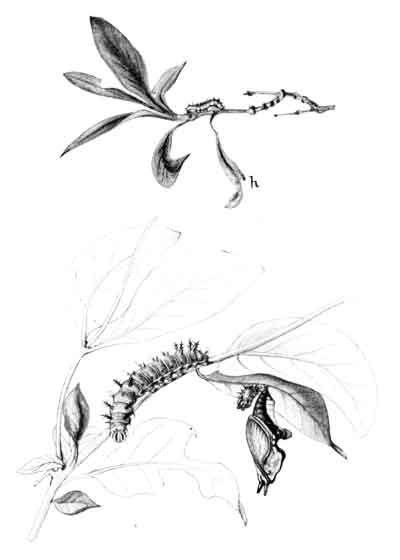
Pl. 30.
White Admiral.
Young caterpillar with hibernaculum (h); caterpillar and chrysalis.
Var. hutchinsoni, Robson, which has been renamed pallida and lutescens, differs from the typical form in having the ground colour much lighter and brighter on the upper side and ochreous on the under side. It is shown on Plate 35. The outline of the wings of this form, which occurs in June and July, is said to be less jagged, and this may be so as a rule, but it certainly is not always the case. Possibly this is "The Pale Comma" of Petiver.
There are two broods of this species in the year, but the first or summer flight of butterflies seems to depend upon a favourable season, as also does the second or autumnal brood, at least as regards the number of butterflies representing it. The late butterflies hibernate and reappear in April, or even March, of the following year. It has been stated that all the specimens appearing in the spring are of the form with plain under sides.
From eggs laid between April 27 and May 6, Miss E. Hutchinson, writing in 1887, says caterpillars hatched between [Pg 64] 5 and 11. They were "fed" on currant and nettle mixed, and were full grown from June 17th till the 23rd. The first butterfly emerged on June 26, and the last on July 3, and all were very fine and of the pale summer variety. Two of the insects paired on June 30, and the female commenced laying on July 1, and continued doing so till the 10th, when there were 120 ova. Unfortunately, a very cold spell of weather began on July 12, and more than half the eggs perished. The butterflies resulting from the remainder appeared during August, from the 17th to the 27th, but they would not pair, probably because, although they had emerged at an early date, they properly belonged to the autumnal flight.
In 1894 Mr. Frohawk reared 200 of these butterflies from 275 eggs laid by a female between April 17 and June 1 of that year. The caterpillars were supplied with nettle only. The first butterfly emerged on June 30, and the last on August 2. Of the whole number forty-one were of the light fulvous form, var. hutchinsoni, and all the others of the dark or typical form. With few exceptions, the light-coloured butterflies were the first to emerge, and the major portion of these during early July, and before any examples of the dark form had come out.
The egg is at first green in colour with ribs whiter, but changes before the caterpillar hatches out to yellowish. In confinement the female butterflies deposit their eggs singly or in chains of three or four; probably the latter is the usual method of laying the eggs under natural conditions.
The caterpillar when full grown is black, netted with greyish; the spines on the second to fifth rings inclusive are yellowish, and those on the back of the other rings are white; the back from ring 6 to ring 10 inclusive is broadly white, marked with black, and the upper surface of the other rings is more or less yellowish. The head is black, marked with ochreous; the crown is lobed, and on each lobe is a short club-like knob.
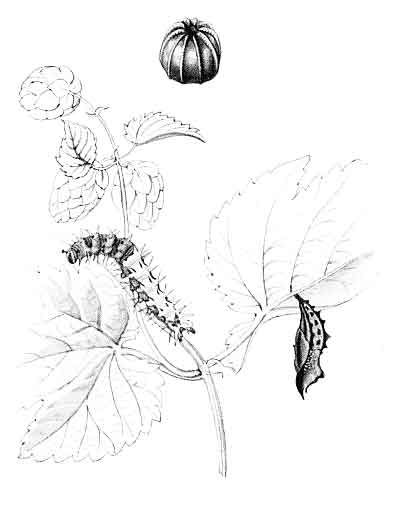
Pl. 32.
Comma Butterfly.
Egg enlarged; caterpillar and chrysalis.
The chrysalis is brownish tinged with pink; the wing-cases and the rings of the body are edged with blackish; there is a greyish line along the back of the body and a brownish stripe along the spiracles; at the point where the body joins the thorax there are some silvery or golden spots. The figures of caterpillar and chrysalis on Plate 32 are after Buckler.
This butterfly seems to have disappeared from many localities in England where it formerly flourished. About seventy or eighty years ago, for example, it was plentiful in Epping Forest, in Herts, and in Dorset. During the last half-century or so it has been common in certain parts of many of the counties from Somerset to Durham and Cumberland, but seems to have occurred only sparingly or singly in Norfolk, Suffolk, Essex, Kent, Sussex, Hants, Wilts, and Devon. It still occurs now and then in the Dover district, the most recent record being of one taken in October, 1894; and it was reported from North Staffordshire in 1893. Probably it is now almost entirely confined to favoured districts embraced within the area represented by the counties of Herefordshire, Worcestershire, and Monmouthshire, whence it may occasionally stray into the adjoining counties, or even further afield.
This butterfly is often associated with hop gardens, but it is by no means restricted to such places. The usual food-plants of the caterpillars are hop (Humulus lupulus), nettle (Urtica dioica), and currant (Ribes), but it is reported to eat gooseberry (R. grossularia) and elm (Ulmus).
Abroad it has a very wide distribution in Europe, and extends through Asia to Japan.
Apart from its larger size, and somewhat different outline, this butterfly may be known from the Small Tortoiseshell by its duller colour, which is brownish-orange; on the fore wing [Pg 66]there are, as a rule, no blue crescents in the hind marginal border, but there is an extra black spot placed between veins 1 and 2; on the hind wings a black spot on the front area represents the black basal area seen on the Small Tortoiseshell; and this is an important point of difference, although the two species are not likely to be confused when both are well known. The blue spots referred to as not usually present on the fore wings are stated to occur in specimens emerging from chrysalids that have been kept in a rather cold temperature for a certain length of time.
An aberration known as testudo has the black spots of the fore wings united, and forming blotches on the front and inner areas; the ground colour of the fore wings is lighter, and the hind wings are blacker. This form occurs at large on the Continent, but it is rare; it has also been produced in the course of temperature experiments.
The only eggs of this butterfly that I have been able to obtain are the batch figured on Plate 34. These were purplish with whitish ribs, but no caterpillars hatched from them. Hellins, who squeezed a few eggs from a freshly killed female, states that the colour apparently is a dull green. The ribs vary from seven to nine in number.
The caterpillar in the adult stage is black, with a speckled dark ochreous band traversed by a black central line on the back; the sides are dappled with ochreous grey; the under parts are brown dappled with darker, and merging into the black. The spines are dark ochreous tipped with black, and the head is shiny black and bristly. (The figure is after Buckler.)
These caterpillars live in large companies, often at the top of a high elm tree, from which they may be dislodged by a well-aimed stick, if this happens to be heavy enough to jar the branch when it reaches the mark. Besides elm trees (Ulmus), they also may be found on willow and sallow (Salix), aspen and poplar (Populus), white-beam (Pyrus aria), and various [Pg 67]fruit trees, especially cherry. Occasionally they have been found on nettle, but the butterflies from these were small in size. June is the best month for them.
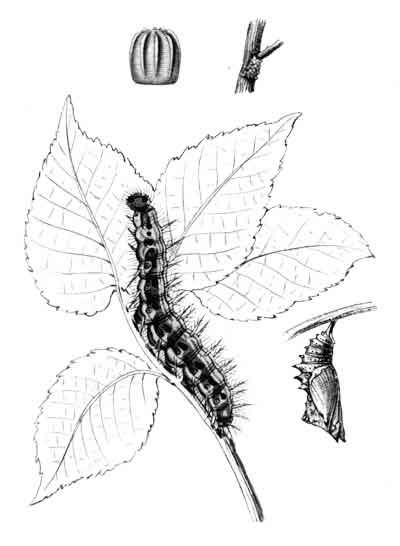
Pl. 34.
Large Tortoiseshell.
Eggs, natural size and enlarged; caterpillar and chrysalis.
The chrysalis (Plate 34) is greyish, tinged with pink or reddish, sprinkled with greenish, and shaded with brown and black; the back of the body nearest the thorax is adorned with golden spots. I once obtained a number of these chrysalids in July at Mill Hill; they were found suspended by the tail from the edges of boards that formed a rickety old cart-shed standing at one end of a field and beneath an elm tree.
Although this butterfly is often common in the caterpillar state, the perfect insect, which emerges in July and August, is more frequently seen in the spring after hibernation than before that event. It probably establishes itself in suitable quarters, in old trees, faggot stacks, barns, etc., for its long rest during the winter, at an early period after emerging from the chrysalis.
No doubt large numbers are destroyed by their great enemies, the parasitic flies, chiefly perhaps the Hymenopterous Apanteles. An observer states that from fifty chrysalids only one butterfly resulted, all the others were found to be filled with parasites. In another case of one hundred caterpillars, some collected when quite small, only one was not "ichneumoned."
These butterflies, in common with most other Vanessids, do not pair until the spring, but Barrett cites an instance of caterpillars, from eggs laid by a female in early September, being reared until about 1/2 inch in length, when they apparently laid up for hibernation.
Lanes margined with trees, especially elms, or the verges of woods, are the most likely places in which to find the butterfly. At one time and another it has been observed in nearly every county of England and Wales, and also in some parts of Scotland, but not in Ireland. It appears to be more or less common in all counties around London, extending to [Pg 68]Somerset in the west; to Cambs, Norfolk, and Suffolk in the east; and to Northampton and Warwick in the Midlands.
Abroad it is found throughout the greater part of Europe, Asia Minor, and eastward to the Himalayas.
This butterfly is one of the most ubiquitous as well as prettiest that we have in this country. Its reddish-orange colour, marked with yellow patches, black spots, and blue crescents, gives it a charming appearance as it sits on a flower, or even on the ground, with wings fully expanded to the sunlight. When the wings are closed up, however, the butterfly seems to disappear, as the under side of the wings is quite sombre in colour. The only bright spot on the under side is the yellowish central area of the fore wing, and when the wings are held erect over the insect's back this is not seen, but only the tips of these wings, which are of the same dull colour as the hind wings.
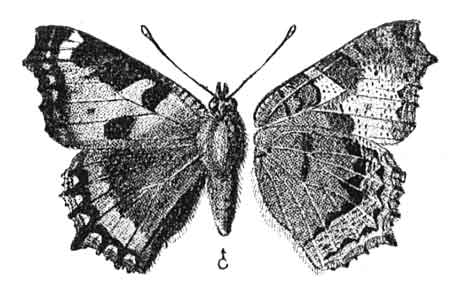
Fig. 22.
The ground colour is subject to modification as regards the shade of red in the orange, and this may be intense or reduced to just a mere tinge. Specimens have been taken on the wing in which the colour was some shade of buff, and the same kind of colour change will sometimes result from an over-long [Pg 69]exposure to the action of ammonia. The black markings vary in size, and sometimes those on the costal area are more or less connected or even confluent (Fig. 22); a greater or lesser amount of blackish suffusion on the hind wings (Fig. 23) generally accompanies confluence of the costal spots on fore wings. The two black spots between veins 2 and 4 occasionally enlarge and unite, or, on the other hand, they decrease in size to vanishing point. Some specimens have black scales between the second costal spot and the black spot on the inner margin, and the space between these two spots may be entirely covered with black and so form a central transverse band (var. polaris). A modification of this form is shown on Plate 38, lower figure. The yellow patch between the second and third costal black spots is sometimes continued right across the wings to the yellow spot on the inner margin, and in this respect resembles an Indian form of the species named ladakensis. Dwarf specimens result, in most cases, when the caterpillars have fed on hop (Humulus); at least, this is so in confinement.
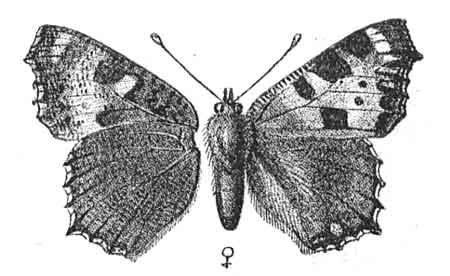
Fig. 23.
The egg is at first green, but after a time becomes tinted with yellow and the ribs stand out clear and transparent. The eggs are laid in a cluster on the under side of a terminal leaf of a nettle plant in May and again in July.
The adult caterpillar is yellowish, closely covered with black speckling and short hairs; there is a black line down the centre of the back, and this is bordered on each side by the clear ground colour. The spiracles are black ringed with yellow, and there is a yellowish line above them. The yellowish spines have black tips. Head black, hairy, and speckled with yellow. Individuals of another company were almost entirely black, the spines alone being tinged with yellow. These caterpillars are gregarious from the time they hatch from the egg until about the last stage.
The chrysalis is most often of some shade of grey and sometimes tinged with pinkish. The points on the upper parts of the body are in some examples metallic at the base, and occasionally the metallic lustre spreads over the thorax and other parts as well.
There are two broods in the year, one in June, the other in August and September. The latter brood, or at least some of the butterflies, hibernate and reappear in the earliest sunny days of spring. They have been seen on the wing as early as January and February (1896), and as late as December.
The geographical range of this species extends through Europe and Asia to Japan.
Unlike the last species referred to, this handsome butterfly is more frequently seen in the autumn than after hibernation. It is not likely to be mistaken for any other kind, for on its brownish-red velvety wings it bears its own particular badge, the "peacock eyes." The marks on the hind wings are more like the "eyes" on the tail feathers of the peacock than are those on the fore wings, and the brownish-red on these wings is confined to a large patch below the eye-mark, the remainder being blackish, powdered with yellow scales on the [Pg 71]basal area. Some specimens have a blue spot below the "eye" on the hind wings, and the name cyanosticta has been proposed for this form by Raynor. The under side is blackish, with a steely sheen, and crossed by irregular black lines; the fore wings are tinged with brown on the inner area, and the central dot and a series of dots beyond are ochreous; the hind wings have an ochreous central dot.
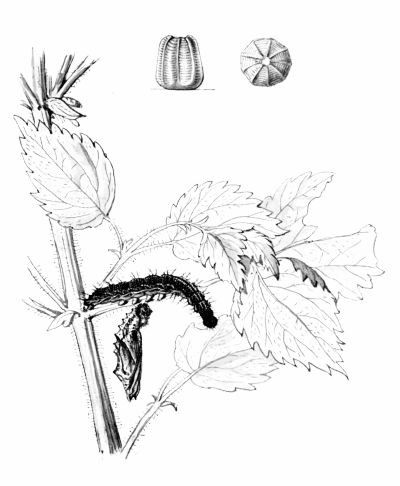
Pl. 37.
Small Tortoiseshell.
Eggs enlarged; caterpillar and chrysalis.
In a state of nature the butterfly seems little given to variation. In rearing from the caterpillar, however, some curious aberrations occasionally crop up. In my early days of collecting I raised a number of specimens from caterpillars selected from a large brood; every one of these butterflies was of a dull brownish colour and had a greasy semi-transparent appearance. I regret to add that I set them all at liberty as they did not come up to my, then, standard of what a Peacock butterfly should be. Now and then specimens are bred from collected caterpillars, in which the eye spots are represented by a broad white cloud-like suffusion on the fore wings, and by a pale roundish patch on the hind wings; in conjunction with this the black costal spots of the fore wings are all more or less united (see Plate 41). This extreme variety is known in the vernacular as the "Blind Peacock," and as ab. belisaria in science; between it and the typical form there are all kinds of intermediate modifications, and one of these is also shown on the plate referred to. It may be interesting to remark that similar varieties have been produced by subjecting the chrysalids at a particular period to a very low temperature. Readers who may wish to know more about "Temperature Experiments" are referred to a pamphlet on the subject by Dr. Max Standfuss.
The egg, an enlarged figure of which will be found on Plate 39, is olive green in colour, and has eight ribs, which start just above the base and turn over the top. The eggs are laid in April or May in batches on the upper part of nettle plants and under the young leaves.
The mature caterpillar is velvety black with white dots, and the divisions between the rings of the body are well marked. The spines are black and rather glossy, and besides this clothing, the body is also provided with short hair which gives the velvety appearance. The head and a plate on the next ring, also the legs, are shining black; the prolegs are blackish, tipped with yellowish. When quite young they are greenish-grey, and although hairy are without spines. The caterpillars usually feed in companies in June and July on the common stinging nettle. They have also been found on hop. Once or twice I have reared caterpillars of this butterfly, and also those of the Small Tortoiseshell and the Red Admiral, on hop, but the result has been disappointing, as the specimens produced were always small in size. The individuals for these experiments were obtained from nettle, and were generally about half grown at the time they were put on the hop diet.
The chrysalis is figured on Plate 39. Its colour may be pale greenish, greyish, pale brown, or brownish-grey, but is usually stippled with blackish, especially the antennæ and the outline of the wing-cases. Some of the points on the thorax and the ring, or rings, next to it have a metallic lustre. Two chrysalids among those resulting from my hop-fed caterpillars were more or less suffused with the metallic sheen. It does not seem to be very clearly known where the caterpillars retire to for pupation. Those that I have found have been under a tent-like arrangement of the lower nettle leaves. In confinement, however, I have noted that in a roomy cage they all go to one end of it and suspend themselves from the roof; in a large flower-pot they crowd together in much the same way.
The butterfly is on the wing in August and September, and frequents all and every kind of ground where flowering plants, especially the taller kinds, are available; clover fields are attractive, and so also are orchards. It passes the winter in some hollow tree trunk, wood stack, or possibly buildings of [Pg 73]some kind, and in the spring it again comes forth. March and April are the usual months for its reappearance, but in 1900 it was seen flying over the snow on February 17. The time last mentioned is probably an unusual one, but it is interesting to note that a very similar observation was made by Harris, who in 1778 wrote in his remarks on this butterfly, "I have seen them flying in February, when the snow has been on the ground."
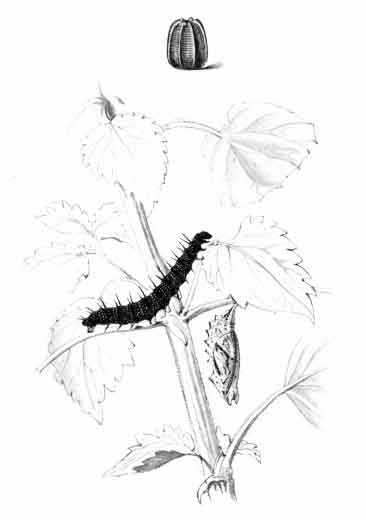
Pl. 39.
Peacock Butterfly.
Egg enlarged; caterpillar and chrysalis.
Usually the Peacock butterfly assumes the perfect state but once in the year. There is, however, a record of half-grown caterpillars being found in September, and that these produced butterflies in due course.
Although not always abundant, the butterfly is to be, or has been, found in almost every part of the kingdom, excepting perhaps north of the Caledonian Canal in Scotland. Around Bishop Auckland and in other parts of the county of Durham, and also in Northumberland, it was common some forty years ago, but it seems to be hardly ever seen there now. The same applies to other northern localities where it was once plentiful. Its distribution includes the whole of Europe, Asia Minor, Siberia, Amurland, Corea, and Japan.
This is a large and handsome insect; its chocolate-brown wings are bordered with ochreous speckled with black scales. The border is variable in width, and this is occasionally so wide that it partly or completely hides the blue spots, which in the ordinary form are placed on a dark band just before the ochreous border. Such specimens are known as var. hygiæa or var. lintneri (Plate 41); but in the former form the yellow spots on the front edge of the fore wing are absent, and in the latter variety these spots are sometimes united and form a blotch. One authority states that the proportion of these extreme variations in nature is about 1 in 500. The same form may be produced [Pg 74]by subjecting summer chrysalids to a temperature of about 110° Fahr. during three to five consecutive days, the chrysalids being placed in this heat four times a day, and for a period of one hour each time. Dr. Max Standfuss, who has made many experiments with this and other butterflies, states that the result of such treatment as that adverted to, and as regards this species, has been the production of as many as seven of the varieties among forty specimens. It would seem probable, then, that the varieties occurring in the open are from chrysalids that received a greater amount of heat than those that produce the ordinary butterfly.
It has been stated that the borders are ochreous, but this only applies to the specimens seen in the summer or early autumn. The butterflies hibernate, and when they leave their winter retreats in the spring, the colour of the border is considerably paler and often even white. For some time it was considered that white borders were a peculiarity of the British Camberwell Beauty and stamped it a genuine native. Probably there are some who may still hold this opinion. An example of each form is represented on Plate 43, the upper one was taken in the spring, and the other in the autumn. Both belong to Mr. J.A. Clark, to whom I am indebted for their loan.
The egg is at first deep ochreous yellow, changing through olive brown to red brown, and a day or two before the larva hatches out becoming leaden grey. The ribs, which are eight or nine in number, are most prominent below the top, and disappear before the base is reached. The eggs are laid on twigs or stems in small batches of 30 or 40 up to large ones of 150 to 250.
The caterpillar has been described by Mr. Frohawk, who gives a full account of the life-history of this species in the Entomologist for 1902 and 1903. The following is an abridgement of his description.
The head is bilobed, having a deep notch on the crown, and of a dull black colour, covered with black warts, each emitting [Pg 75]a white hair. The ground colour of the body is deep velvety black, and densely sprinkled with pearl-white warts, each emitting a fine white hair, some being of considerable length, and the majority slightly curved. Down the centre of the back is a series of rich deep rust-red shield-like markings, which commences on the third segment and terminates on the eleventh segment. In the centre of the anal segment is a shining black dorsal disc, much resembling the head; the legs are black and shining, and the four pairs of prolegs are rust colour, with a polished band above the feet, and the anal pair are black with pale reddish feet.
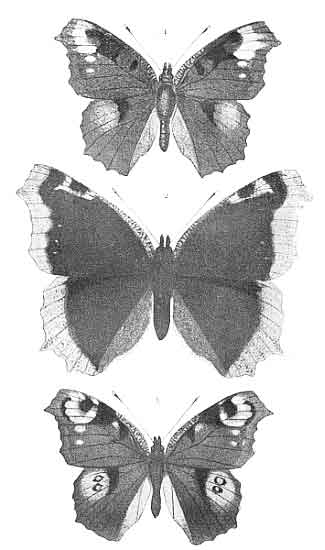
Pl. 41.
1, 3 Peacock vars.; 2 Camberwell Beauty var.
The caterpillars feed on sallow, willow, birch, and elm. They cover the leaves of their food-plant with a silken web and live thereon in companies, and do not separate until about to prepare for the chrysalis state.
The chrysalis. The dorsal half of the head and wing points are black, and the ventral half orange. Some of the points on the body are tipped with orange. The whole surface is finely and irregularly furrowed and granulated. The ground colour is pale buff, covered with fine fuscous reticulations. The entire surface is clothed with a whitish-powdery substance, giving a pale lilac or pinkish bloom to the chrysalis, which, however, is easily rubbed off, the chrysalis then assuming a brownish hue. Our figure of the chrysalis is after Holland.
Mr. Frohawk, who had female butterflies living under observation for about three months, states that eggs were laid in April, May, and June. Caterpillars from the first batch of 192 eggs hatched early in May, nineteen days after they were laid. These were full grown by June 20, and entered the chrysalis state soon after. The butterflies from these commenced to emerge about the middle of July.
He says: "Both sallow and willow are equally suitable food for the larvæ, and birch is readily eaten, even when willow has formed the sole food until the last stage; they will feed on elm. [Pg 76]Nettle was not appreciated, and not touched by them during the last two or three stages."
This butterfly appears to have first attracted the attention of the earlier British entomologists about the middle of the eighteenth century. Stephens, writing in 1827, remarks that "about sixty years since it appeared in such prodigious numbers throughout the kingdom, that the entomologists of that day gave it the appellation of the Grand Surprise." Harris figured the butterfly under the name mentioned by Stephens, and it has also been referred to by others as the "Willow Beauty" and the "White Petticoat." Newman called it the "White-bordered;" and from this, as well as from his description of the butterfly, it would seem that he had not seen any specimen, caught in Britain, with ochreous borders. Such specimens have most certainly been captured in these islands, and occasionally in some numbers, as, for example, in the autumns of 1872 and 1880. In the former year the butterflies were seen or taken in a great many parts of the kingdom. The single specimens that are taken now and then in the spring have hibernated, and possibly they may have just come over from the Continent. It is, however, equally possible that they may have arrived in the country the previous autumn and passed the winter here. After the invasion in the autumn of 1872, specimens were observed in January, March, and April, 1873, at places widely apart. In 1881 single specimens were taken in April in Surrey, Kent, and Brecknockshire; and in Essex and at Hampstead in August. One or two specimens were taken in the summer or autumn of the years 1884 to 1887 inclusive. In 1888 two were captured in Essex in May; and in August, three in Kent, one each Surrey, Hants, and Isle of Wight; and one in Kent in September. In 1889 a specimen was taken in Surrey in April, one in Kent, and one in Cambs in May; a few also in the autumn of that year. In 1891 a specimen was seen at Balham in September. In 1893 one was taken in Epping [Pg 77]Forest in April, and one in South Devon in August. Single specimens were noted in Oxfordshire, Lincolnshire, Berwick, and the Isle of Skye, in September, 1896, and one at Epsom in December of that year. In 1897 one was recorded from Yorks (August), and one from Norfolk (September); and in May, 1898, one was taken at Norwich. One or two were observed in August or September, 1898 and 1899; and in 1900 there seems to have been an invasion, on a small scale, of this butterfly in August into some of the eastern and southern counties of England. It extended westward to Somersetshire, and northward to Roxburghshire. A few were taken in various southern localities, including south-east and north London, in August and September of 1901. A specimen occurred in the Isle of Wight in September, 1903, and one in September, 1904; and in the latter year one was captured in August at Raynes Park in Surrey. In 1905 one butterfly was taken at Harrow, Middlesex, on July 27; one at Norwich on August 26, and one in Suffolk on September 29.
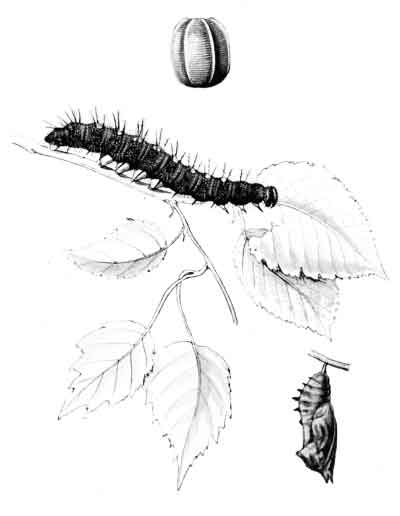
Pl. 42.
Camberwell Beauty.
Egg enlarged; caterpillar and chrysalis.
A full record of this fine butterfly in the British Islands would occupy too much space, but the details given above will show something of its erratic occurrence since 1880. It visits Ireland occasionally, but there are no recent reports of its having been seen there.
Kane, in his Catalogue of the Lepidoptera of Ireland, mentions a specimen taken in Co. Kerry, July 21, 1865; one from near Belfast [in 1875?]; and a third example seen by a friend "many years ago" near Trillick, Co. Tyrone. The latter was "settled on the roadside, but not captured, it being Sunday."
Distributed throughout the temperate parts of the Northern Hemisphere, it is common in the Scandinavian Peninsula, whence probably our specimens came; also in Germany. In some parts of the Continent it is, however, almost as uncertain in its occurrence as in England.
The usual colour of this butterfly is tawny-orange, but in some specimens, especially fresh ones, there is a tinge of pink, or a rosy flush; the markings are black, and there are some white spots towards the tips of the fore wings. The black markings on the hind wings are subject to variation in size, and sometimes they run one into the other. Occasionally this union of the spots is accompanied by blackish suffusion spreading more or less over the entire surface of the wings, so that they appear blackish with tawny-orange patches or clouds. A somewhat peculiar variety of the species, kindly lent by Mr. J.A. Clark, is shown on Plate 49. Specimens of this form, or some modification of it, have been obtained in England, but very rarely. Similar examples have also been found in other parts of the globe. Fig. 24 represents another interesting aberration of this butterfly.

Fig. 24.
The egg is at first green, and gradually becomes darker. It is strongly ribbed from the base to the top, where the ribs become finer and turn over towards the central hollow, at the [Pg 79]bottom of which is the micropyle. The fine cross-ribs form slight bosses at their junction with the upright ribs. The eggs are laid on the leaves of the thistle, but usually only one on a leaf.
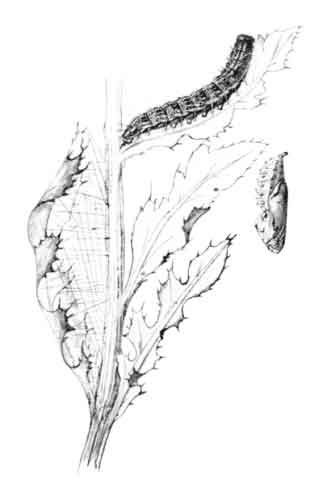
Pl. 44.
Painted Lady.
Caterpillar, chrysalis and protection-web.
The caterpillar is rather stout for its length. It has a dark greyish head, which is covered with short bristles. The ground colour of the body varies from greyish-green and ochreous-grey to blackish, and in the darker colour is generally freckled with paler, sometimes yellowish. There is a black line along the back, often edged with yellowish, and sometimes much broken up; the lines on the sides are yellowish, but not always distinct; the line below the yellow-ringed black spiracles, however, is generally broad and yellowish in colour. Although thistles (Carduus) appear to be the plants most frequently eaten by these caterpillars, they have sometimes been found feeding upon mallow (Malva), burdock (Arctium), viper's bugloss (Echium), and even nettle (Urtica). They commence life by fixing up the edges of a leaf so as to form a sort of pocket in which to conceal themselves, but as they eat away the fleshy part of the leaf their retreat is easily detected. The hiding-place, or dining-room, of a full-grown caterpillar is shown on the plate; change to the chrysalis is often effected in a somewhat similar structure.
The chrysalis is grey, ochreous-grey, or greenish; shaded or striped with brownish. The raised points are burnished, and according to the way light falls on them appear golden or silvery. This metallic effect is also seen on other parts of the chrysalis, but chiefly on the back.
This butterfly is a notorious migrant. Its proper home is probably in Northern Africa, and there it, at times, becomes so exceedingly numerous that emigration is possibly a necessity in the interests of future generations of the species. Whatever the cause of their leaving may be, there is no doubt about the fact that the butterflies do quit the land of their birth in great swarms. Almost any part of the world may become the[Pg 80] dumping-ground of this surplus stock. Our own islands are frequently favoured in this way, and it is most likely that if this were not so, this pretty butterfly would not be so common throughout Great Britain as it is in some years. The natural habit of the species is to go on reproducing its kind throughout the year, and those individuals that arrive here most certainly endeavour to do this in their new home. Unfortunately our climate is not, as a rule, a suitable one for those caterpillars which hatch from the egg late in the season, and although some may complete their growth, and even attain the perfect state, the butterfly, so far as is known, does not hibernate as do the Tortoiseshells and the Peacock. It may therefore be assumed that the specimens seen in May or June of any year are not native born, but early immigrants, and that it is from such aliens that the caterpillars and butterflies observed later in the year are descended.
A curious habit of the Painted Lady, and also of the Red Admiral, is that of continuing on the wing long after other kinds of butterfly have retired to their resting-places for the night. Both have been seen flying about at dusk, and have been recorded as attracted by light on more than one occasion.
It has been noted that these butterflies, in early summer, usually occur singly, and seem to become attached to some short stretch of ground, over which they career to and fro with almost mechanical regularity. They may be struck at with the net again and again, but do not desert their beat. Even if caught and released again they appear to be undismayed, and resume their interrupted patrol either at once or very shortly afterwards. The later butterflies also are not afraid of the net, and will repeatedly return to some favourite perch after being struck at and missed.
Although the butterfly has been observed, sometimes in abundance, in every part of the British Islands, even to the Shetlands, its occurrence in any given locality is always [Pg 81]uncertain. In some years it may be fairly common in the early part of the year and very scarce later on.

Pl. 46.
Red Admiral.
Eggs enlarged; young and adult caterpillars; chrysalis.
A North American species, Pyrameis virginiensis (huntera), has been once or twice, since 1828, reported as captured in England, but its occurrence in this country can only be regarded as accidental.
The vivid contrast of black and scarlet in this butterfly will certainly arrest the attention of even the least observant. But Nature, ever excellent in her colour schemes, has toned down the glare of the scarlet bands by the addition of some splashes and dots of white above them on the fore wings, and some dots of black on those of the hind wings. Then, by way of a finish, there is a delicate tracing of blue along the outer margin of the fore wings, and a touch of the same colour at the angle of the hind wings, the scalloped margins of all the wings being white relieved by black points. On the under side the combination of colour on the fore wings is much the same as above, but there is also some blue tracing on the central area, and the tips harmonize with the hind wings, which are mottled with various shades of brown, traversed by wavy black lines, and have a more or less square pale spot on their front edges.
The ordinary variation in this butterfly consists of slight differences in the tone of the red markings, which ranges from the normal scarlet in one direction to almost crimson, and in the other to orange-yellow. The bands on the fore wings may be broken up into two, or sometimes three, distinct parts; and a specimen with the bands of hind wings marked with yellow has been noted. There is often a white dot in the bands of the fore wings, and this occurs in both sexes.
A somewhat rare variety is represented on Plate 49. It was reared from one of three caterpillars casually picked up at Erith, and is now in Mr. Sabine's collection. Somewhat similar specimens have been figured elsewhere. One of these was bred from a caterpillar found at Ashton in 1867, and another was captured in Jersey in 1893. All these varieties seem to be modifications of the form named klemensiewiczi by Schille, and which was figured by Esper as a variety of atalanta in 1777. This form has also resulted from temperature experiments on the chrysalis, of the kind previously adverted to.
The egg when first laid is green in colour, but as the caterpillar matures within the colour changes to greenish-black, with the ten ribs showing up more or less transparent. The egg is laid in an upright position on nettle leaves and young shoots, but not in batches like those of the Tortoiseshell, etc.
The caterpillar varies in colour. Some are blackish freckled with white, with two yellow stripes, sometimes broken up, on the sides; and the rows of branched spines yellow, except those nearest the head, which are black or tipped with black. Others are greyish, or grey marked with yellowish-green. Others, again, are dark brownish, with the spines on the back pale, and those on the sides black; or all the spines may be shining black (Hellins).
The chrysalis is greyish, prettily ornamented with gold along the centre of the back and on the thorax and head. The projections are also tinged with metallic gloss. It is generally suspended under a canopy of nettle leaves.
The caterpillars do not live in companies like those of the Peacock and Tortoiseshells, but each individual constructs for itself a kind of tent (see Plate 48) by spinning together the leaves of its food-plant, the common stinging-nettle. Although the caterpillar is well concealed in such hiding-places when newly made, it "gives itself away" when it has partly consumed its home. It has been found on pellitory (Parietaria officinalis), [Pg 83]and also on hop (Humulus); but I have found that caterpillars fed on hop alone always produce small butterflies.
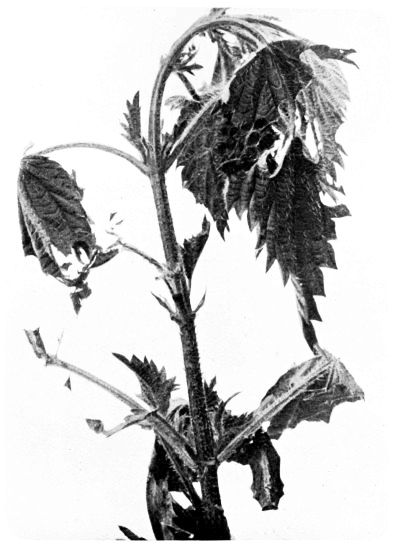
Pl. 48.
Red Admiral.
Caterpillar's shelter-tent, and chrysalis.
The caterpillars, which in a state of Nature are often badly "ichneumoned," have been noted in England as early as the end of June and as late as October. In the South of Europe they have been seen in February.
The butterflies seen in spring and early summer, up to, say, the beginning of July, are supposed to have wintered in this country, but there is no positive evidence, that I can find, that the butterfly does hibernate here. It is, however, most probable that they are arrivals from abroad. The species is found throughout Europe and North Africa, Northern Asia, and North America, and it may be suspected of migration, although there is, perhaps, not such conclusive evidence on this point as in the case of its cousin, the Painted Lady.
Anyway, unless we admit immigration, it seems difficult to understand why this butterfly should suddenly become common in some British localities from which it has been almost or quite absent for several years. Again, we rarely hear of butterflies moving about at night, but the Red Admiral, as well as the Painted Lady, are known to do this. If it does hibernate in this country it is very late in taking up winter quarters, as it is seen on the wing at the end of October, and sometimes even in November; it has also been known to emerge from the chrysalis in the latter month. It does not appear in the spring with other hibernating species, and is rarely seen before the end of May, but June seems to be about the normal time.
In the autumn it is fond of making excursions into the flower garden and the orchard, where it takes toll from flower and fruit, an over-ripe pear or plum being its special weakness. The blossoms of ivy, hop, thistle, teazle, etc., are attractive, but a tree-stem that has been bored by the caterpillar of the goat moth will be visited by nearly every Red Admiral in the district. One observer mentions that he once saw quite thirty of these [Pg 84]butterflies gathered around one wounded birch tree on Wimbledon Common. There was not room for all to imbibe at the same time, but those unable to satisfy their desire at the moment were content to sit around and await a favourable opportunity of joining in the feast. The seductive fluid obtained from such trees is evidently more potent than the nectar from flowers, as under its influence the insect is so listless that it may be taken up between the finger and thumb.
Its range extends throughout the British Islands, and seems to be very similar to that of the Painted Lady.
The wings of this fine butterfly are fulvous, with the veins and spots black; the spots on the hind wings are band-like, and the central spots on the fore wings are sometimes connected. The female is paler than the male, and is without the heavy black scales (androconia) on veins 1, 2, and 3; the basal third of the fore wing, and a larger area of the hind wing, tinged with greenish. The form of the female with all the wings greenish is the var. valesina (Plate 52), and between this and the type there are various intergrades, one of which is shown on the plate. Specimens with white spots on the fore wings, and chiefly in the males, are sometimes not uncommon in the New Forest, as, for instance, in the year 1893, when quite a large number were secured. Very much more rarely white spots occur on all the wings (Plate 57, Fig. 1). In a very remarkable male specimen, taken in the New Forest in 1881, the central area of all four wings is black, and the veins beyond are broadly edged with the same colour. A curious female aberration has the central black spots much reduced or absent, whilst those on the outer margin are united, and form elongate blotches between the veins, the upper one being wedge-shaped. Aberrations of the valesina form, similar to that figured [Pg 85]on Plate 57, Fig. 2, and Fig. 25 on next page, are not often met with; the ground colour is greenish, but much suffused and clouded with black. Now and then gynandrous specimens are obtained, the one side normal male and the other side typical female, or var. valesina.
The egg when newly laid, in July, is whitish tinged with green, ribbed, and cross-furrowed, the alternate ribs not extending to the top. As the caterpillar matures, the egg-shell appears blackish and the ribs hoary.
The caterpillar when full grown is velvety black with two bright yellow lines along the back; the spines are of a reddish-ochreous colour with the extreme tips and branches black. There are only two on the first ring, and these are inclined forward over the head. The chrysalis is of a pale ochreous colour, streaked and mottled with brownish; the hollow part of the back has a brilliant golden sheen, and the points on the rest of the body are gold tipped. Suspended by the anal hooks to a silken pad spun on a twig, rock, or other object in the vicinity of its feeding-place, it is capable of much activity in the way of wriggling when touched, and displays the beauty of its metallic adornment to the greatest advantage when so engaged.
The caterpillar hatches in August, and after eating its egg-shell and nibbling a leaf or two of dog-violet (Viola canina), goes into winter quarters whilst in its second skin, and consequently very small; the spines, which are such an imposing feature of the adult caterpillar, have not yet appeared. In April, after feeding again, it moults the second time, and the spines are then disclosed.
Sometimes caterpillars continue to feed in the autumn instead of hibernating. This, at least, has happened to Mr. Frohawk on two occasions, notably in 1893, when he had several individuals of a brood, from eggs laid by a female of the valesina form, that departed from the usual custom of their [Pg 86]kind by feeding and growing until they eventually passed through all the stages and emerged perfect butterflies in September and October of that year. Something similar occurred in a brood that he was rearing in the autumn of 1895, but on this occasion only one caterpillar continued to feed beyond the normal time.
The English name by which we now know this, the largest of the six British Argynnids, seems to have been given to it by Moses Harris in 1778. Sixty years or so before that date it was called the "Greater Silver-streaked Fritillary." Fortunately, in this case, as in others where the vulgar tongue is entomologically concerned, the law of priority does not apply, so that the name Silver-washed, which so well expresses the underside ornamentation, may be retained.
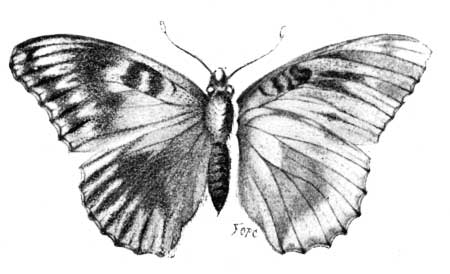
Fig. 25.
Aberration of var. valesina.
The butterfly is probably to be found in most of the Southern English and Welsh counties, especially where there are extensive woods. In North Devon, however, it occurs in places where there is not much in the way of woodland. It is abundant [Pg 87]in the New Forest, and also in some parts of Ireland. Although it has been observed as far north as the Clyde, it is scarce in North England and Scotland. The valesina form is to be seen, in July and August, in the New Forest every year, and sometimes in numbers. This variety has been reported from Kent, Sussex, Devon, and Dorset; also from "near Reading" and "the border of Hertfordshire."
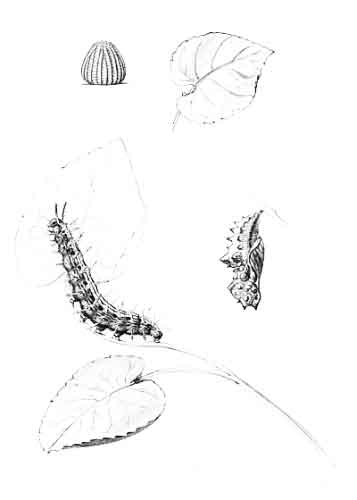
Pl. 51.
Silver-washed Fritillary.
Egg, natural size and enlarged; caterpillar and chrysalis.
Abroad, the typical form is distributed through Europe and Asia to China, Corea, and Japan. The valesina variety is uncommon in Northern Europe, but in some parts of China it seems to be the dominant form.
Bright fulvous with black spots and veins. The female is not so bright in tint as the male, and is without the thick patch of scales on veins 2 and 3. The series of black spots parallel with the outer margin of the fore wing are normally six in number, but the third is usually small and sometimes absent, whilst the fourth and fifth are often much larger than others of the series. In the corresponding row on the hind wing the first and third spots are sometimes wanting. On the under side the silvery spots are generally as seen in Plate 54, but they are subject to modification, and not infrequently are absent from the tips of the fore wings, and sometimes from the outer margin of the hind wings also. A very rare aberration has the central area of the fore wings black on the upper and under sides; the hind wings are black above with fulvous lunules on the outer margin, and the silvery spots on the under side are reduced to five, and these are confined to the basal area. In another remarkable form the hind wings above are similar to the last-mentioned variety, but on the under side the silvery spots on the basal half are united and form a large patch, which is divided by the nervures, and there are no silvery spots on the outer [Pg 88]margin. The variety shown on Plate 57 has the under side of the hind wings buff in colour, the markings on the outer margin are reddish-brown with a few silvery scales towards the anal angle, and the basal silvery spots are confluent, agreeing in the latter character with the preceding variety, and also with var. charlotta of the next species. In var. cleodoxa the spots on the under side are yellowish instead of silvery, but the red spots on the outer area are sometimes silver centred; this form is only rarely found in Britain. Possibly some of the reputed British examples of A. niobe may have been referable to cleodoxa, but what appears to be more certain is that the actual occurrence of niobe in England is exceedingly doubtful.
The egg when newly laid is yellowish-green; it afterwards turns pink, and then rosy red; during the winter it changes to greyish or bluish-green. As a rule, the eggs are laid at the end of July, and the caterpillars do not hatch until the following March or early in April. In 1893, however, Mr. Frohawk had a few caterpillars hatch out between the middle of August and September 20, from a number of eggs laid at the end of June. One of these, fed up, pupated on October 13, and the butterfly emerged on November 21. The majority of the eggs remained over to the following spring. According to an observation made by Mr. W.H.B. Fletcher, the caterpillar is fully formed soon after the egg is laid, but remains within the shell all the winter.
The caterpillar, which feeds upon dog-violet, and also the sweet violet, is figured on Plate 53. The head is pinkish-brown, covered with short greyish bristles. Body black, incrusted with ochreous grey on the sides, and on the back marked with ochreous grey on the hinder half of each ring; dorsal line white. The branched spines are pinkish-brown.
The chrysalis is deep brown, freckled with paler; points along the back of the body brilliant greenish-golden, as also are the four points on the thorax. The wing-cases are rather [Pg 89]paler. The foregoing brief description was taken on July 10, and the butterfly emerged five days afterwards.
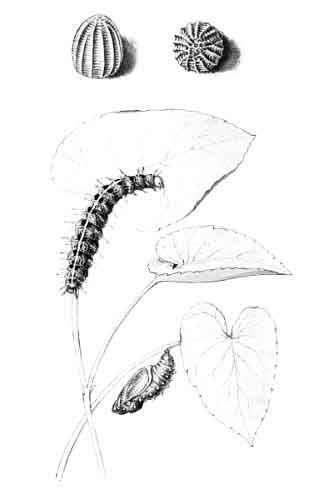
Pl. 53.
High Brown Fritillary.
Eggs enlarged; caterpillar and chrysalis.
Barrett says, "Apparently found in most of the larger woods of the southern counties, from Kent, Essex, Suffolk, and Norfolk on the east, to Devonshire, Glamorganshire, and Merionethshire on the west; also in similar situations through the north-western counties and the more sheltered woods of the Midlands to Herefordshire, Shropshire, Derbyshire, and Lincolnshire. Found in several localities in Yorkshire, in the favoured Grange and Silverdale districts of Lancashire, and near Lake Windermere in Westmoreland, its extreme northern boundary being reached in Cumberland."
It is widely distributed over Europe, and its range extends into Asia Minor and Amurland. In China and Japan it is represented by various forms, the commonest of which is var. locuples.
This butterfly is bright fulvous in the male, paler in the female; the latter sex is blackish towards the base, and has paler spots on the outer margin. The black marking is pretty much as in the previous species, but the male has the black scales (androconia) on veins 1 and 2, and these are less conspicuous. The basal two-thirds of the hind wings is greenish on the under side. The silvery spots are arranged in fairly regular series, and there are no silvery centred red spots between the two outer series. The blackish crescents on the outer margin of the fore wings are edged with silver, but this is chiefly towards the tips of the wings.
There is some variation in the tone of the ground colour, lighter or darker than normal in both sexes; the female seems to be the most variable in this respect, and sometimes, especially in the north, examples of this sex are much suffused with [Pg 90]blackish or greenish-black. Occasionally the colour is quite pale, as shown in the middle figure on Plate 61, and sometimes it is clouded with greyish. The black spots are apt to run together, and so form bands and blotches. An example of this kind of aberration is shown on the plate.
Var. charlotta differs very little from the type on the upper side, but on the under side of the hind wings the basal silvery spots are united, as shown in the upper reverse side figure on the plate. This variety was known to the entomologist of Haworth's time as the "Queen of England Fritillary," and there is a figure of it in Sowerby's "British Miscellany," which was published in 1806.
The egg is yellowish when first laid, and a day or two afterwards violet-brown rings appear above the base and the apical half. It is ribbed and finely cross-ribbed, and some of the ribs are continued to the truncate and slightly depressed top.
When full grown the caterpillar is shining purplish-grey, thickly mixed with velvety black; the grey is most in evidence between the rings and along the lower part of the sides. There is a yellow stripe along the middle of the back, and this has a central black line of irregular width; along the lower part of the sides there is a row of reddish spots, and these are connected by a fine yellowish line. The black spines are branched, and, except on the first three rings, which have only two rows, arranged in three rows on each side of the yellow stripe. The head is glossy black, and, like the body, hairy. (Adapted from Buckler.)
It feeds in May and June on dog-violet, and has been reared on garden pansy. The chrysalis has the head, thorax, and wing-cases black, very glossy, and marked with pale brownish; the body is pale brownish, and the points black. Suspended in a tent-like arrangement of leaves.

Pl. 55.
Dark Green Fritillary.
Eggs, natural size and enlarged; caterpillar and chrysalis.
Moorlands, downs, sea-cliffs, and flowery slopes are the kind of situations most to the fancy of this agile butterfly. It is on [Pg 91]the wing in July and August, and is much more easily seen than caught. However, it is rather fond of perching on the taller kinds of thistles, and is then not difficult to capture, if quietly approached. It is common locally in most of the English and Welsh counties. In Ireland it seems to be chiefly attached to the coast, and is plentiful in some of its localities. In Scotland it occurs in many suitable districts, but Skye is the only one of the isles from which it has been reported. Its distribution extends through Europe and Asia to Amurland, China, and Japan.
In shape and in general appearance this butterfly is not unlike a small example of the Silver-washed Fritillary; the large silvery, or sometimes pearly, blotches on the under side of the hind wings at once reveal its higher British rank. When flying it has a curious resemblance to the Wall, and sometimes it has been taken when the captor supposed that he was netting a specimen of that plebeian butterfly. The black markings on the upper side vary somewhat in size, and occasionally those on the front area, or those on the inner area of the fore wings, are more or less confluent; very rarely the wings are suffused with a steely-blue or bronze colour. The specimens occurring in this country do not, however, exhibit so much variation as has been observed in this butterfly abroad.
I have not seen any of the early stages. The figures of the caterpillar and the chrysalis (Plate 58) are after Hübner, and the following descriptions of the egg and other stages are adapted from the detailed life-history of the species by Mr. Frohawk, published in the Entomologist for 1903:—
"The egg is one-fortieth of an inch high, of a rather straight-sided conical form, widest at the base, where it is smooth and rounded off at the edge. There are about forty longitudinal [Pg 92]keels, irregularly formed and of different lengths, some not reaching halfway up the side, and others running the entire length from base to crown, where they terminate abruptly, and form a series of triangular peaks round the summit surrounding the granulated micropyle; the spaces between the keels are finely ribbed transversely. When first laid it is of a very pale lemon-yellow colour, inclining to ochreous, appearing almost white in certain lights; the colour gradually deepens, becoming yellower with a greenish tinge. On the fifth day the crown of the egg assumes a dull grey, finally changing to a lilac-grey."
The female butterfly, when placed in the sunshine, laid about a hundred eggs during the day—August 7. These were mostly placed singly on the leaves or other parts of a plant of heart's-ease (Viola tricolor), but some were laid on the gauze cover of the cage. All the caterpillars hatched out on August 14.
The caterpillar when full grown is velvety black, densely sprinkled with tiny white dots, each bearing a black bristle; there are six rows of spines, which are of various shades of brown with yellowish bases and shining black bristles; along the back there are two white streaks on the fore part of each ring, and white warts emitting black bristles on the hind part. The head is amber-coloured above, but black below, and is covered with bristles like the body.
The chrysalis has the head, thorax, and wing-cases shining olive-brown; the body chequered and speckled with olive-brown, ochreous, black, and white. The spiracles are black and conspicuous, and the points on the body are amber-coloured. The thorax and first two body rings have brilliant burnished silver-gilt ornamentation.
The butterflies commenced to emerge on September 25, and between that date and the 28th ten came out. Although he succeeded in rearing almost all the caterpillars to the chrysalis, no less than eighty died in this stage, and he states that "there is no doubt that the late autumn English climate is [Pg 93]quite unsuited for the existence of this species," as well as for others that come to us from abroad.
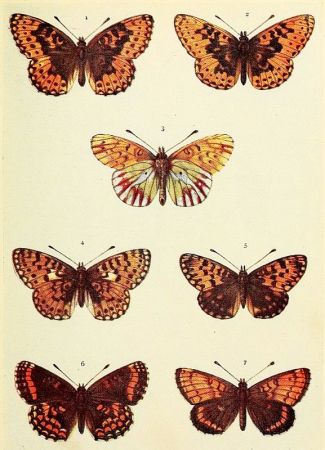
Pl. 56.
1, 2, 3 Pearl-bordered Fritillary vars.
4, 5 Small Pearl-bordered Fritillary vars.
6, 7 Heath Fritillary vars.

Pl. 57.
1, 2 Silver-washed Fritillary vars.
3 High Brown Fritillary var.
Moses Harris, in 1775, gave this butterfly the name "Queen of Spain;" it had been known to English entomologists from 1710 until then as the "Lesser Silver-spotted Fritillary." Gamlingay in Cambridgeshire seems to have been the only British locality in which it had been observed until 1795, when Lewin mentions a specimen taken in a Borough (London) garden in August. All the Cambridge specimens had been captured in the month of May. Stephens, writing in 1828 ("Ill. Brit. Ent. Haust.," i. 37), says—
"Previously to the year 1818, few cabinets possessed even a single specimen; and from the very few known instances of its capture (six only, according to Mr. Haworth), there is reason to believe that some of the specimens at that time [1803] placed in collections were foreign; but in the above remarkable year for the appearance of certain papilionaceous insects, this species occurred simultaneously in several, and very distant, parts, having been taken in August by Mr. Haworth at Halvergate, in Norfolk; by Mr. Vigors in Battersea-fields; by myself at Dover, and, during that and the following month, near Colchester; Birchwood, Kent; and Hertford in plenty by others. At the latter place I saw several specimens, but was not fortunate enough to secure any."
The butterfly has been taken, chiefly odd specimens, in many of the eastern and southern counties, from Norfolk to Dover, and almost always in the autumn. It has also occurred at Scarborough (1868), and at least once in Ireland (1864).
The neighbourhood of Dover seems to have always been the most favoured locality, and no less than twenty-five specimens were captured there in 1882. Several examples were also obtained at Dover in 1883, and a single specimen in other parts of Kent in 1884 and 1885. The most recent records are—Brighton, one example in 1892; Clifton, one in July, 1898;[Pg 94] Christchurch, one in August, 1899; Poole, one in 1901. There does not seem to be any authentic record of the caterpillar having been observed in Kent or any other British locality in which the butterfly has been noted. This may possibly be due to its love of concealment.
There are two flights of the butterfly in the year, one in the spring and the other in the autumn.
Females from the Continent may arrive on our east or south coasts in May, and deposit eggs from which the autumn butterflies are developed. Some of these might wander farther inland, but eggs would almost certainly be laid on the spot. The fate of the caterpillars from autumnal eggs would depend on the winter; if mild they, or at least some of them, might manage to get through and attain the butterfly state about May, but their doing so is rather doubtful.
The species is widely distributed and often common on the Continent, and its range extends to Persia, Northern Asia, and North Africa. In Eastern Asia it is represented by var. isœa.
Some authors consider the smaller Fritillaries to be generically separable from the larger kinds, and place this and the next species in the genus Brenthis, whilst the Queen of Spain is referred to the genus Issoria, Hübner. Here, however, they are retained in Argynnis.
In colour and in the marking of the upper side the Pearl-bordered is very like the High Brown, but, as will be seen from the figures, it is much smaller in size, and the ornamentation on the under side is different. There is one silvery spot at the base of the hind wings, a larger one about the middle of the wings, and a row of spots on the outer margin. The female is rather larger than the male, and darker at the bases of the wings.
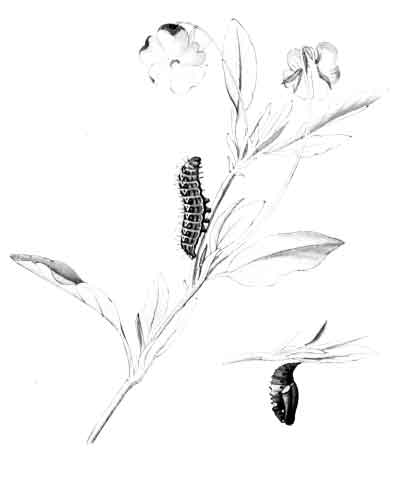
Pl. 58.
Queen of Spain Fritillary.
Caterpillar and chrysalis.
Variation on the upper side consists of more or less black suffusion on the basal or general area of the wings, and an increase in the size of the black spots, resulting in the formation of bands or patches; or the black spots may be much reduced in size, and some of them entirely absent. Some of the more striking kinds of aberration, both above and below, are represented on Plate 56, Figs. 1-3, and Plate 65, Figs. 1-4. The usual colour is sometimes replaced by buff, and this may be yellowish or whitish in tint; occasionally white spots appear on the wings. The life-history of this butterfly is depicted on Plate 60.
The egg, which is laid in May or June, is whitish-green at first, and afterwards turns brownish. It is distinctly ribbed, and the top is somewhat rounded and hollowed in the centre.
The full-grown caterpillar is black, and the numerous minute hairs with which it is clothed give it a velvety appearance. There is a greyish-edged black line down the middle of the back, and the spines on each side of this are whitish or yellowish, with the tips and the branches black; all the other spines are black. A greyish stripe runs along the lower part of the sides, and this is traversed from the fourth to the last ring by a blackish line. Head black, shining, downy, and slightly notched on the crown. The natural food-plant is dog-violet (Viola canina), but the caterpillar will also eat garden pansy, and has been known to nibble a leaf of primrose. It retires for hibernation when quite small, and recommences to feed in March.
The chrysalis is brownish, with the raised parts of the thorax and head greyish; the body is paler brown, and the points thereon are blackish.
This butterfly seems to be fairly common in woods throughout England and Wales, and it is often abundant in some of the more extensive woodlands, especially in the southern counties. It used to be plentiful in Northumberland and Durham, but has become scarcer in those counties, and in some others in the north of England. It occurs in Scotland, and is not uncommon [Pg 96]in Sutherlandshire, but Kane does not include it in his Irish catalogue.
Clearings in woods are generally the best places in which to find this pretty little Fritillary; but it also seems to have a fondness for the margins of brooks and rills, where these run through or by the sides of woods. Usually it is on the wing in May or June, but sometimes, in early seasons, it puts in an appearance at the end of April. To entomologists of a bygone age it was known as the "April Fritillary," but this name would hardly be a suitable one for it in the present day. Very rarely a few specimens have been taken in August; and there is at least one record of caterpillars that had ceased feeding in July, in the usual way, and were apparently settled down for hibernation, suddenly arousing from their slumbers, and completing their growth in August.
Abroad, the species is distributed throughout Europe, except the extreme south, and extends into Armenia, Northern Asia Minor, the Altai, and Amurland. It is stated to be double-brooded on the Continent.
This butterfly differs from the last one referred to in having a rather deeper colour on the upper side, and heavier black markings on the outer margin of the hind wings. The female is slightly more orange in tint, and has a series of pale spots on the outer margin of each wing. On the under side the red markings are browner in tint, and there are more silvery spots on the hind wings. Variation in colour and marking is similar to that mentioned under the Pearl-bordered. On Plate 66 a white spotted female and a specimen with the hind wings clouded with black are represented. These are rather uncommon aberrations. The life-history of this species is figured on Plate 62.
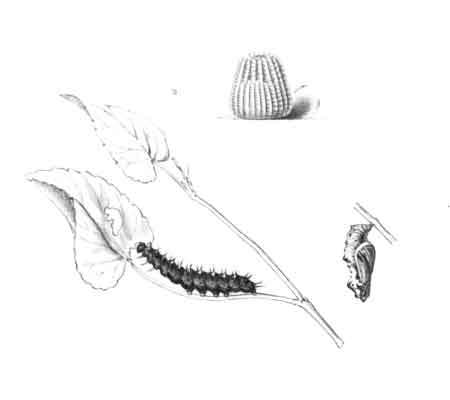
Pl. 60.
Pearl-bordered Fritillary.
Egg, natural size and enlarged; partly grown caterpillar; chrysalis.
The egg is at first greenish, then yellowish, and afterwards [Pg 97]greyish, and then becoming blackish towards the hollowed top. The ribs seem to be eighteen or twenty in number; laid in June or July on plants of dog-violet. On emerging from the egg the young caterpillar devours most of the shell. It is then of a pale olive colour with brownish warts, from each of which there is a pale and rather long jointed bristle; the head is black. The full-grown caterpillar is smoky pink and velvety-looking. There is a brownish line along the middle of the back. The spines are "ochreous in colour, tinged with pink, and beset with fine pointed black bristles." The upper ones are rather stouter than the others, and the pair on the first ring, the only spines on this ring, are rather more than twice the length of the others, and are directed forward over the head, thus giving the appearance of a pair of horns; the second and third rings have each four spines, which are rather finer than those on the rest of the body, which are arranged in six rows. A pale pinkish stripe runs along the lower part of the body; just above the feet. Head black and notched on the crown (Buckler). The chrysalis is brown on the thorax and the body; the wing-cases are more ochreous and marked with black near the edge. There is a black V-mark on the thorax, with a silvery spot on each side, one silvery spot on each side of the head, and other metallic spots on the body near the thorax (Buckler).
On the Continent there are two broods of the butterfly, and specimens are occasionally seen in August in this country; one of these late examples, taken by Mr. Barker in 1881, is shown on the plate (Fig. 6). Sometimes one or two caterpillars of a brood in confinement will feed up and attain the perfect state in August instead of settling down with their companions for hibernation.
The butterfly in June and July frequents similar places to those favoured by the Pearl-bordered, and its distribution in Britain is somewhat similar, although it is a more local species. [Pg 98]It seems, however, to be commoner in Scotland than the Pearl-bordered, and has been recorded at least once from Ireland.
Its range abroad extends farther east, as it is found in Corea.
The ground colour of this butterfly, sometimes called the "Pearl-bordered Likeness" or "May Fritillary," is brownish-orange, and the markings are black or blackish; the bases of the wings are clouded with blackish, and the fringes are white checkered with black.
The ground colour varies in tint, and may be pale tawny or deep reddish. The black markings are subject to modification in two directions; in one leading up to almost complete disappearance from the central area, and in the other they are much intensified and greatly obscure the ground colour. Sometimes the whole of the wings, with the exception of a series of orange spots on the outer area, are blackish. This form is known as var. navarina. The left-hand figure at the bottom of Plate 68 shows an aberration approaching this form, whilst the right-hand figure comes close to var. corythalia. Specimens with all the wings thinly marked with black, as in the fore wing of the variety last referred to, would be referable to var. obsoleta.
According to Barrett, specimens from Essex have the ground colour on the under side of the hind wing much yellower than are the same parts in specimens from Sussex. I have not noticed this, but some Essex examples that I have seen were much darker and more heavily marked with black on the upper side, and especially on the hind wings, than any that I have seen from other parts of England, except, perhaps, a few individuals from North Devonshire. These Essex specimens reminded me very much of M. dictynna, a Continental species, with which, it appears, the Heath Fritillary was confounded by some of the old authors.
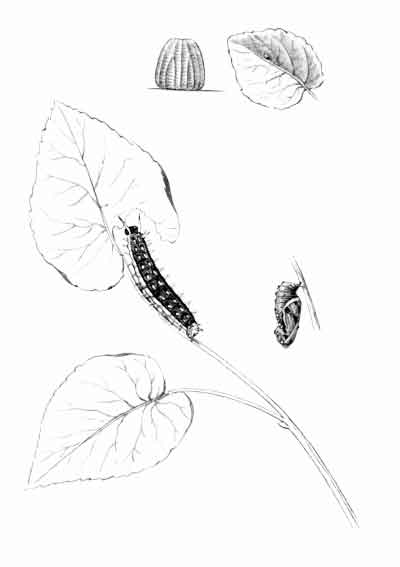
Pl. 62.
Small Pearl-bordered Fritillary.
Egg, natural size and enlarged; caterpillar (after Buckler), and chrysalis.
There is a good deal of variation on the under side, but chiefly of a minor character, and most often unconnected with variation on the upper side. The following are more important varieties.
Var. tessellata, the Straw May Fritillary of Petiver, and figured by him in 1717 and by Stephens in 1827, has the under side of the hind wings entirely straw-coloured with black veins. There are three large squarish yellow spots on the basal area, outlined in black; a yellow central band, margined and traversed by black lines. On the outer margin there is a series of yellow crescents, outlined in black.
Var. eos of Haworth (the Dark Underwing Fritillary) is the pyronia of Hübner and Stephens, and a modification of var. corythalia, Hübn. On the under side the fore wings are fulvous, and have two black spots in the discal cell, and a black band, intersected by the veins, on the central area. On the hind wings the basal third is fulvous with eight black spots; the central area is whitish intersected by the black veins. On the yellow-tinged whitish outer area there is a series of black-margined orange crescents; a row of black lunules precedes a thin black line on the outer margin.
The egg is upright, ribbed, and pale whitish-green in colour. As the caterpillar matures the shell becomes greyish. The eggs were laid in a cluster on a leaf of cow-wheat (Melampyrum pratense) as shown in the figure, but failed to hatch.
The full-grown caterpillar is black on the back, becoming olive tinged on the sides and olive-brown underneath; the divisions between the rings are olive. The whole of the upper surface, except a line along the middle of the back, is dotted with white, and there are eleven white-tipped orange or yellowish spines on each ring, except the last two and the three nearest the head; the first and the last each have four spines, the third has eight, and the second and the eleventh have each ten spines. The head is black marked with white, and is clothed with short, stiff, black hair or bristles (Buckler). [Pg 100]The chrysalis is pale whitish-ochreous, the markings on the wing-cases are black, and those on the other parts are orange and black.
Cow-wheat appears to be the chief food of the caterpillar, but it will also eat, and has been found on, foxglove (Digitalis purpurea) and woodsage (Teucrium scorodonia). Plantain is also said to be a food-plant, but Buckler says that his caterpillars would not eat this. The caterpillars are rather shy in their habits, and, except when the sun is shining brightly, require to be carefully looked for among their food-plant and the dead leaves, etc., around. They hatch from the egg in July, feed for a few weeks, and then hibernate in companies under a web. In April and May they become active again, feed up quickly, and appear as butterflies in June and early July.
The species is, unfortunately, becoming scarcer in England than it used to be. It seems quite to have disappeared from some of the districts in which it was formerly common. No doubt in one or two of its old and well-known localities the butterflies, and perhaps the caterpillars also, have been too freely taken, and its natural enemies have probably completed the business. Clearings in woods or heathy borders of woods are the kind of places this species appear to prefer. Its headquarters in any given locality seems to be changed from time to time, so that the exact spot where it will occur next year cannot be predicted from this year's observations.
The butterfly seems to be unknown in Scotland, and has only been recorded from Killarney in Ireland. In England it is to be found in the counties of Essex, Kent, Surrey, and Devonshire.
Its geographical distribution extends through Europe into Asia Minor, East Siberia, and Northern Amurland. In Corea and Japan it is represented by a larger form known as var. niphona.
This butterfly is bright brownish-orange with black markings, as shown on Plate 71. The under side of the hind wings and the tips of the fore wings are very pale yellowish; the former with two black-margined brownish-orange bands, and lines of black dots; the tip of the fore wing is also dotted and marked with black. The female is slightly paler, and the markings are often blurred.
There is variation in the black markings on the upper side. Sometimes these are enlarged, but more often they are much reduced, and the central one may be completely absent from all the wings. Connected with the suppression of the middle black line above there is usually aberration on the under side of the hind wings also, where the central area is clear of black dots, and the basal area is fulvous, edged and marked with black. Two very remarkable aberrations are represented on Plate 65, Figs. 7, 8.
The eggs, which are yellowish-white, and sometimes tinged with green, are laid in a cluster on the under side of the tip of a leaf of the narrow-leafed plantain (Plantago lanceolata). The caterpillars hatch in July and August, and hibernate in companies under a web. The mature caterpillar is black with white dots, and black bristles arising from greenish warts. The red head, which is notched on the crown, and the red fore legs distinguish this at once from the caterpillars of the Heath, or the Marsh Fritillary. It feeds in early spring on plantain, but seems to prefer Plantago maritima to P. lanceolata when both are present.
The chrysalis is brownish in colour, and is ornamented with orange on the thorax, and with orange points and black marks on the body. It may be found in April and early May suspended from the lower parts of the stems of the plantain or [Pg 102]other plants around. Newman states that he found "dozens of the chrysalids in company," but I have only occasionally met with them, and always singly.
Quite early in the eighteenth century this butterfly had only been observed in England in Lincolnshire, where, according to Ray, it was common, and in a wood at Dulwich. Petiver, who mentioned the last-named locality, calls it the "Dullidge Fritillary." Wilkes in 1773 wrote of it as the "Plantain Fritillary," although he gives clover and grass, as well as plantain, as the food of the caterpillar. Moses Harris in the Aurelian (1779) calls the butterfly the "Glanville Fritillary," and states that it was named after Lady Glanville, who was interested in butterflies, and whose will was disputed on that ground. This fact will serve to show that entomology as a pursuit was not much in vogue at that time, and that those who collected butterflies, etc., were apt to be regarded by their friends as being—well, just a "wee bit daft."
Both Wilkes and Harris, it may be remarked, seem to have been acquainted with the caterpillar of this species as well as with that of the Marsh Fritillary, and there seems little reason, therefore, to suspect that they confused the two species. The localities given by the earlier authors appear, however, to suggest that the butterfly they wrote about may have been the Marsh Fritillary; but there is no direct evidence of this.
Stephens in 1827 ("Illustrations of British Entomology," Haustellata, vol. i. p. 34) wrote—
"This is a very local species, and is found in meadows by the sides of woods; in Wilkes' time it was not uncommon in Tottenham wood; recently the places where it has been chiefly observed have been near Ryde and the Sandrock Hotel, Isle of Wight; in the latter place in plenty: also at Birchwood, and near Dartford and Dover, and in a wood near Bedford. I believe that it has been found in Yorkshire."

Pl. 65.
1, 2, 3, 4 Pearl-bordered Fritillary vars.
5, 6 Marsh Fritillary vars.
7, 8 Glanville Fritillary vars.
There is no doubt that between 1858 and 1863 the butterfly [Pg 103]was more or less common on parts of the Kentish coast between Folkestone and Sandgate, but it seems to be equally certain that the species has long been absent from that part of England as well as from other localities that have been mentioned, except the Isle of Wight, where it is still to be found. It flies in May and June, and seems to have a preference for the rougher parts of the undercliff; but I have seen butterflies and caterpillars too on the higher slopes of St. Boniface. Whenever the caterpillars are met with, it will be well to remember that only the full-grown ones should be taken, as the smaller ones do not thrive very well in confinement. A little self-denial in this matter will bring its own reward in the shape of fine specimens for the cabinet, and the pleasant reflection that the useless sacrifice of a number of caterpillars has been avoided.
The butterfly is widely spread and generally common on the Continent, and in the Channel Islands it is plentiful in Alderney and Guernsey. Its range extends into Asia Minor, Central Asia, and Siberia.
This species, of which several forms are represented on Plate 73, is subject to considerable variation in depth of colour, and also in size and intensity of the markings, in all localities. The varieties here referred to are more or less characteristic of the countries in which they occur. To mention all the forms, or even those to which varietal names have been given, would occupy more space than is available for the purpose.
Reddish-orange or bright tawny, veins black, breaking up the yellow or yellowish transverse bands; there are three or four transverse black lines, the first and second, counting from the base of the wing, not always distinct; basal area more or [Pg 104]less suffused with black. On the under side the fore wings are fulvous, with faint traces of the upper-side markings; the hind wings are rather redder, especially on the outer half, and have yellowish markings, comprising some spots towards the base of the wings, a band beyond the middle, a series of black centred spots, and crescents on the outer margin. The above applies more particularly to the form of the butterfly occurring in England and Wales.
The Irish form known as præclara has the transverse band straw-coloured, the red colour is more vivid, and the black veins and cross-lines heavier; the area nearest the base of the wings is often blacker.
In a form occurring in Scotland, and known as var. scotica, the black is still more intense, and the straw-coloured markings are dull in colour.
The egg is pale brownish and very glossy. It appears smooth towards the rounded base, but is ribbed from just before the middle to the top. The eggs are laid in batches on leaves of scabious, chiefly the Devil's bit (Scabiosa succisa).
The full-grown caterpillar is black, with a number of tiny whitish dots, each bearing a short black hair; short black spines are arranged in nine rows from ring four, the first ring is only hairy, the second and third have each two spines. The head is black, with a groove down the front and short hairs on the sides. The true legs are black, and the false legs and the under parts of the body are dull rust-coloured. The caterpillars hatch from the egg in June or July, and towards the end of August they construct silken webs, in which they establish themselves for hibernation. Early in March they recommence feeding, and under the influence of much sunshine feed up quickly. Besides wild scabious, they will eat honeysuckle and the garden kinds of Scabiosa. The chrysalis is pale buff, with orange points on the body; the wing-cases are marked with black and orange. The chrysalids are suspended from a silken [Pg 105]web, which is attached to a leaf or drawn-together leaves. The early stages are figured on Plate 70.
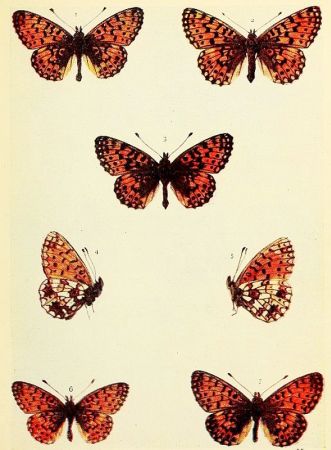
Pl. 66.
Small Pearl-bordered Fritillary.
1, 3, 4 male; 6 do. (second brood); 7 do. var.; 2, 5 female.

Pl. 67.
Heath Fritillary.
Eggs, natural size and enlarged; caterpillar (after Buckler), and chrysalis.
Kane (Catalogue of the Lepidoptera of Ireland), referring to this species, remarks: "This butterfly has been known to increase so prodigiously that whole fields and roads became blackened by the moving myriads of larvæ. An instance of this was observed by the Rev. S.L. Brakey, near Ennis, Co. Clare, where he drove out to see a reported 'shower of worms,' and found as above described, the larvæ being so multitudinous in some fields that the black layer of insects seemed to roll in corrugations as the migrating hosts swarmed over each other in search of food. The imagines that resulted from the starved survivors were extremely small and faded in colour."
These caterpillars are destroyed in great numbers by Hymenopterous parasites, chiefly Apanteles, and it is almost certain that a large percentage of those collected will prove to have been stung.
The butterfly is on the wing in May and June, and seems to affect damp meadows, marshy ground on the sides of hills, and such kind of places. It does not necessarily occur wherever its food-plant is abundant, but scabious is always found to be present in the haunts of the butterfly; so if we know that the insect occurs in a particular district we should probably get a clue to its exact whereabouts by noting the likely places in that district where the food-plant flourishes.
Although it has seemingly disappeared from various English localities where it was formerly common, the butterfly may be found in many parts of the British Islands, but it is local and does not occur northwards much beyond the Caledonian Canal.
Abroad it spreads over Europe to Northern Africa, and its range extends eastward through Asia to Amurland and Corea.
The fine butterfly next in order is regarded as a member of the Danainæ by most authors. Although its generic position [Pg 106]seems to be established, its proper place in the classification of butterflies is still unfixed; and even the question of its trivial or specific name is not finally settled. According to Kirby, this butterfly is Anosia menippe, Hübner, and not the true Papilio plexippus of Linnæus, nor the P. archippus of Cramer. American authors, however, consider it to be the Linnean plexippus, and give menippe Hb. as a synonym. The species is here retained in Danainæ, but Holland places it in Euploeinæ and Skinner in the Family Lymnadidæ.
The butterfly figured on Plate 120 is brownish-orange, with black veins and margins on all the wings. White spots are arranged in double rows on the black outer margin of each wing, and there are seven other rather larger white spots on the black apical patch of the fore wings. The male has a patch of black scales, covering the scent pouch, close to vein 2 on the hind wings.
The egg is long, oval in shape, with over twenty low upright ridges and many cross-lines; is of a pale green colour; and is laid singly on the food-plant of the caterpillar (various kinds of milkweed, especially the commonest kind, Asclepias cornuti), and usually upon the under surface of the upturned apical leaves near the middle. The egg state lasts only about four days (Scudder). The caterpillar has the head smooth and rounded, yellow, conspicuously banded with black. Body cylindrical, tapering a little in front, naked, but with two pairs of long and very slender black thread-like filaments, one pair, the longer, on the second thoracic, the other on the eighth abdominal segment. The body is white, with numerous slender black and yellow, and especially black, transverse stripes, repeated with considerable regularity on each of the segments, so that there are nowhere any broad patches of colour (Scudder).
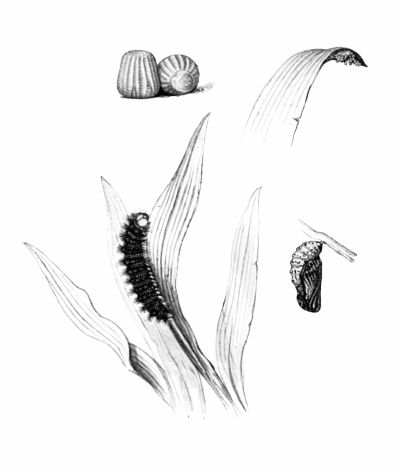
Pl. 69.
Glanville Fritillary.
Eggs, natural size and enlarged; caterpillar and chrysalis.
The chrysalis is stout and not elongated, largest in the middle of the abdomen; where it is transversely ridged; elsewhere it is smooth and rounded, with no striking prominences, but with little conical projections at most of the elevated points, like those which half encircle the body at the abdominal ridge, all of a golden colour except the latter, which are situated in a tri-coloured band, black in front, nacreous in the middle, and gilt behind (Scudder).
According to Dr. Holland, "the butterfly is considered to be polygoneutic, that is to say, many broods are produced annually; and it is believed by writers, that with the advent of cold weather these butterflies migrate to the South [in America], the chrysalids and caterpillars which may be undeveloped at the time of the frosts are destroyed, and that when these insects reappear, as they do every summer in North America, they represent a wave of immigration coming northward from the warmer regions of the Gulf States. It is not believed that any of them hibernate in any stage of their existence. This insect sometimes appears in great swarms on the eastern and southern coasts of New Jersey in late autumn. The swarms pressing southward are arrested by the ocean." Within quite recent years it seems to have effected a settlement in Australia, "and has thence spread northward and westward, until in its migrations it has reached Java and Sumatra, and long ago took possession of the Philippines. Moving eastward on the lines of travel, it has established a more or less precarious foothold for itself in Southern England.... It is well established at the Cape Verde Islands, and in a short time we may expect to hear of it as having taken possession of the continent of Africa, in which the family of plants upon which the caterpillars feed is well represented."
So far as is shown by the published records, the actual number of specimens of the Milkweed, or, as it is sometimes called, Monarch butterfly, seen or caught in England between [Pg 108]1876, in which year it was first observed in this country, and the present time, does not much exceed thirty, and about one-third of these were obtained in September, 1885. In 1876 single specimens were captured at Neath, S. Wales; Hayward's Heath and Keymer, Sussex; and Poole, Dorset. In 1896 single specimens were reported as seen at Lymington, Hants, in May; Newlands Corner, Surrey, in July; and the Lizard, Cornwall, in September. The years in which the butterfly has been noticed in Britain are 1876, 1881, 1884, 1885, 1886, 1887, 1890, and 1896. It was first observed on the Continent in 1877, when, according to Barrett, a specimen was taken in La Vendée, France. In 1886, when half a dozen were recorded from England, single specimens were obtained in Guernsey, and at Oporto and Gibraltar. "More recently," Barrett states, "Mr. H.W. Vivian found it, I believe not uncommonly, in the Canaries, and very kindly brought me a specimen."
There seems to be no question that the species is migratory in its habits, but exactly how it reaches this country is not definitely known. Neither is it known whether the species, having arrived, is able to reproduce its kind here. From the fact of its recurrence in England for four years in succession, the possibility of its breeding in this country might be assumed. One objection to any such inference, however, is that it is a many-brooded species, but, with the exception of two records in 1896, all British specimens were captured or seen in August, September, or October, and none seem to have been observed in the earlier months of those years in which the autumnal butterflies were obtained.
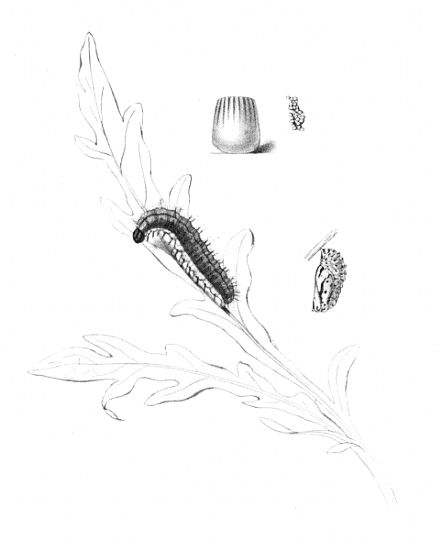
Pl. 70.
Marsh Fritillary.
Eggs, natural size and enlarged; caterpillar (after Buckler) and chrysalis.
The Milkweeds (Asclepias) are not indigenous plants, but, as pointed out by the late Mr. J. Jenner Weir, A. purpurescens and A. tuberosa are hardy in this country. He endeavoured to ascertain whether these plants, or either of them, were grown in any of the gardens in the Cornish locality where four fresh specimens were captured in September, 1885. I do not find [Pg 109]that the desired information was furnished. Recently I have ascertained that A. cornuti, which grows to a height of four feet, is used as a border plant in some parts of England. It is commonly known as Swallow-wort, and is esteemed for its fragrant pale purple flowers.
We now come to the Satyrinæ, which, as regards the number of species belonging to it, is a very large sub-family. In Great Britain, however, there are but eleven species, and although some of these are rather local, none are really scarce, and most are common.
Older English names for the butterfly figured on Plate 75 are "Our Half-mourner" (Petiver, 1717), "The Marmoris" (Wilkes), and "The Marmoress" (Harris). The ground colour is white or creamy white, and the markings are black. On the under side the markings are similar in design to those on the upper side, but much fainter: the eye spots, which are not always in evidence above, are well defined below, and especially so on the hind wings. The female is generally whiter and larger than the male, and has the basal half of the costa, or front margin of the fore wing ochreous brown, and the markings on the under side of the hind wings are tinged with the same colour.
Variation consists chiefly of increase or decrease in the size of the black markings. At least one specimen is known in which all the wings are uniform smoky black. This is in the collection of Mr. A.B. Farn, and was captured near Rochester, Kent, in 1871. Between this extreme and specimens with the black markings of typical proportions there are various modifications; but striking aberrations are rare in this country. Sometimes there is entire or partial absence of black pigment. A [Pg 110]remarkable example of this kind of aberration, taken on the cliffs between Dover and Walmer some years ago, is described as of a clear milky-white colour, and has not, either on the upper or under side of the wings, the smallest speck of black. The ground colour is sometimes decidedly yellow, and very occasionally brownish.
The life-history of this butterfly is figured on Plate 74.
The egg is whitish, opaque, with a dark speck on the apex; base flattened and slightly hollowed; finely reticulated, but without distinct striations or anything resembling ribs. The eggs are laid in July, and are not attached to anything.
The caterpillar when full grown, is whity-brown in colour with brownish lines. The head is brown, tinged with pink, and the tail-like points on the last ring are pink. The head, as well as the body, is clothed with short hair.
The chrysalis is also whity-brown with a pinkish tinge, browner speckling on the wing cases, and the body is marked down the back with yellow.
Hellins says, "It hibernates when very small, becomes full fed in June, and changes to a pupa without suspending itself in any way, or making a cocoon; I think it would hide itself, as my examples did; I found they had got among the thick moss with which I had furnished the bottom of their cage, and apparently made little hollows for themselves by turning round."
Cock's-foot grass (Dactylis glomerata) and cat's-tail grass (Phleum pratense) are given as food-plants, but the caterpillars in confinement seem to eat any kind of grass that is supplied.
The butterfly is found in most of the Midland counties and in nearly all of the Southern ones, but is especially common on the chalk downs of the South-west. It does not occur in Ireland or Scotland, and seems to be absent from the Northern counties of England except Yorkshire. In the last-named county it was supposed to be extinct, but during the past ten[Pg 111] years it has been observed at Sledmere, and near Scarborough and Helmsley. It is also reported to be not uncommon in three localities not far from York.
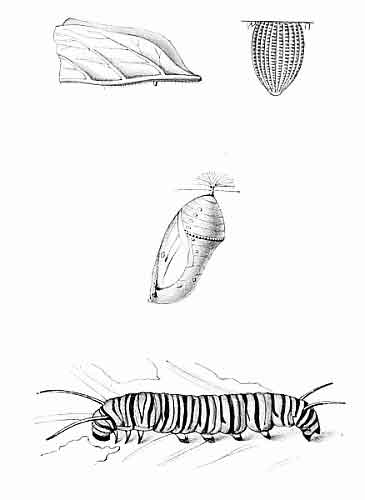
Pl. 72.
Milkweed Butterfly.
Egg, natural size and enlarged; caterpillar and chrysalis (after Smith).
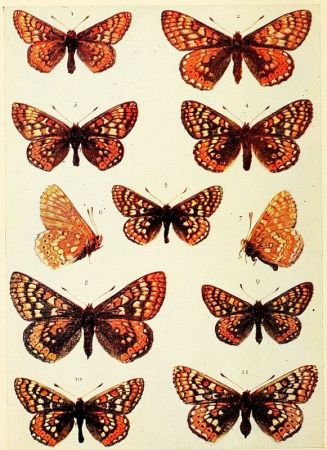
Pl. 73.
Marsh Fritillary.
1, 3, 5, 9, 10 male; 2, 4, 6, 7, 11 female.
1, 2, 4, 6, 7, 9 English; 8 Welsh; 3, 5, 10, 11 Irish.
The butterflies usually affect broken ground, rough fields, grassy slopes near woods, or even sunny banks on the edges of cornfields. Occasionally an odd specimen or two may be met with here and there, but as a rule they seem to keep pretty much together, so that when one comes upon a colony of these butterflies, the selection of a series on the spot is quite an easy matter, and can be effected without destroying a single specimen over and above the required number.
Abroad, this species is abundant in Central and Southern Europe, and its range extends to Northern Asia Minor and Armenia.
The typical form of this butterfly, epiphron, Knock, has the tawny bands unbroken on the fore wings, and almost so on the hind wings; the black dots on the hind wings of the female are often pupilled with white, and more rarely this is so in the male also. It has been stated that specimens occur in Perthshire which exhibit these characters. All the British examples of the Small Mountain Ringlet that I have seen are referable to the form known as cassiope, Fab. (Plate 77). The tawny, or orange, bands are rarely so entire on the fore wings as in epiphron, and are generally rather narrower; and that on the hind wing is broken up into three or four rings. The black dots are usually smaller and without white pupils. The female is somewhat larger and the bands or rings paler.
Variation in the markings is extensive. The bands on the fore wings become less and less complete, until they are reduced to a series of mere rings around the black dots. The black dots decrease in size and in number until they, together with the [Pg 112]tawny marking, entirely disappear, and a plain blackish-brown insect only remains. This extreme form has been named obsoleta, Tutt. The earliest rings to vanish seem to be the third on the fore wings and the first on the hind wings. Similar modifications occur on the under side also, but there may be aberration on the upper side of a specimen, and not, or at least not in the same way, on the under side.
The egg, when first laid, is yellow, changing afterwards to fawn colour with darker markings, especially towards the top. It is laid in July on blades of grass. The larva hatches in about sixteen days.
The young caterpillar, before hibernation in October, is greenish, with darker green and yellow lines. Head brownish. Feeds in July and after hibernation on various grasses, among which Poa annua, Festuca ovina, Aira præcox, and A. cæspitosa have been specified as eaten by caterpillars in confinement. A distinct preference, however, has been shown for mat grass (Nardus stricta), and it has been suggested that this may be the natural food. The full-grown caterpillar appears to be undescribed.
The chrysalis is described by Buckler as being "little more than three-eighths of an inch in length, rather thick in proportion, being less dumpy in form than hyperanthus, but more so than blandina. The colour of the back of the thorax and wing cases is a light green, rather glaucous; the abdomen a pale drab or dirty whitish; a dark brown dorsal streak is conspicuous on the thorax, and there is the faintest possible indication of its being continued as a stripe along the abdomen. The eye-, trunk-, antenna-, and leg-cases are margined with dark brown, and the wing nervures are indicated by the same colours."
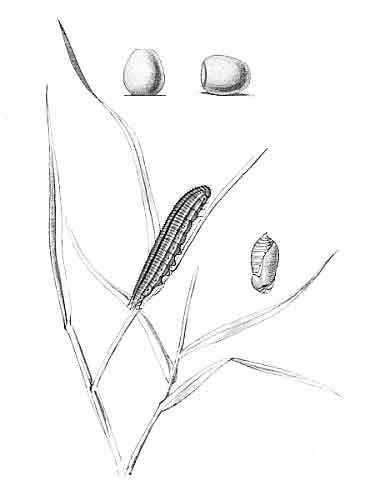
Pl. 74.
Marbled White.
Eggs enlarged, caterpillar and chrysalis.
As is indicated by its English name, this interesting little butterfly only frequents high ground, and is rarely found below about 1500 feet. All its English localities are in the lake district of Cumberland and Westmoreland. It seems to like [Pg 113]boggy ground, and in such places on Gable Hill, Red Skrees, and at Langdale Pikes, among others, it is not uncommon. Previous to 1809 the species was unknown to occur in Britain, but in June of that year specimens were captured by Mr. T. Stothard on the mountains at Ambleside. Haworth, in 1812, referred to these specimens as from Scotland, but the butterfly was not taken in that country until 1844, when it was discovered by Mr. R. Weaver in Perthshire. It is now known to occur, sometimes in abundance, on Ben Nevis and other adjacent hills, also in suitable spots and the proper elevation around Lochs Rannoch and Vennachar, as well as in the Tay district and Argyleshire.
In Ireland it was taken by Mr. E. Birchall, in June, 1854, in a grassy hollow about halfway up the Westport side of Croagh Patrick. About five years ago Mr. W.F. de Vismes Kane met with the butterfly on Nephin, Mayo, and he mentioned a specimen believed to have been taken on the hilly slopes on the eastern shores of Lake Gill, Sligo.
Abroad the species is found in mountainous parts of South Germany, Switzerland, France, North and Central Italy. The typical form, epiphron, is more especially obtained in the Hartz and Alsatian Mountains, Silesia, Hungary, and Bulgaria.
The butterfly figured on Plate 77 is deep velvety brown, appearing almost black in very fresh male specimens. There is a broad fulvous band on the outer area, but not reaching either the costa or the inner margin; it is contracted about the middle, the upper part encloses two white pupilled black spots, and the lower part has one such spot. The hind wings have a narrow fulvous band, usually enclosing three white pupilled black spots. The under side is more distinctly brown and not[Pg 114] velvety, band of fore wings similar to above; the hind wings have a greyish band beyond the middle, with three small white pupilled black spots on its outer edge; the basal area is often greyish also. The female is generally less dark and velvety, the bands are rather wider, more orange in colour, and the white pupils of the spots are more conspicuous; on the under side the alternate dark and pale bands are more striking, and sometimes the grey colour is replaced by ochreous, which seems to constitute the aberration named ochracea, Tutt. The spots on the fore wings, upper side, are often increased to four by the addition of a small one between those previously mentioned. More rarely there is an extra spot above the upper pair, and still less frequently, and in the female sex, an additional pair is found below the usual lower spot, thus making six in all. On the other hand, the only spots in evidence may be the pair in the upper part of the band. The spots on the hind wings range in number from two to five, but occasionally all are absent. The fulvous bands on the fore wings may be reduced to rings around the upper and lower spots respectively, and altogether wanting on the hind wings. Such an aberration would be referable to obsoleta, Tutt, which is considered to be very rare. There are many other modifications, but these mentioned will serve to show the variable character of this local butterfly.
The egg is ochreous white, or bone colour, finely freckled with pale brown or pinkish-brown; it has a number of ribs, and is also reticulated.
The caterpillar in its last skin is pale drab, the warts pale whitish-brown, emitting short tapering bristles; dorsal stripe blackish-brown, enclosed by two paler drab lines; subdorsal stripe paler drab, becoming narrow towards the anal point, edged above with a greenish-brown thread, and below with blackish or brownish dashes, that almost form a continuous line; below this come two thin pale lines, above the lower of [Pg 115]which are the circular black spiracles; the under parts and the legs are of a somewhat warmer tint of the ground colour of the back. It changed on June 22nd to a pupa, unattached, but placed in an upright position amongst the grass near the ground.
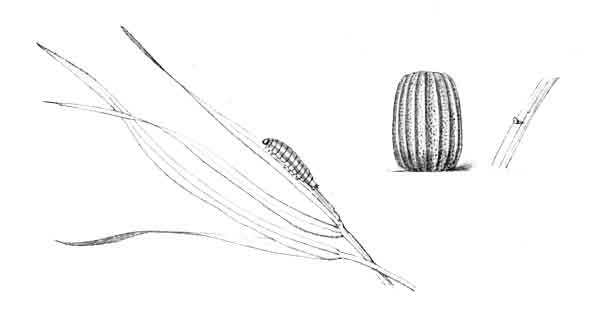
Small Mountain Ringlet.
Egg, natural size and enlarged; young caterpillar.
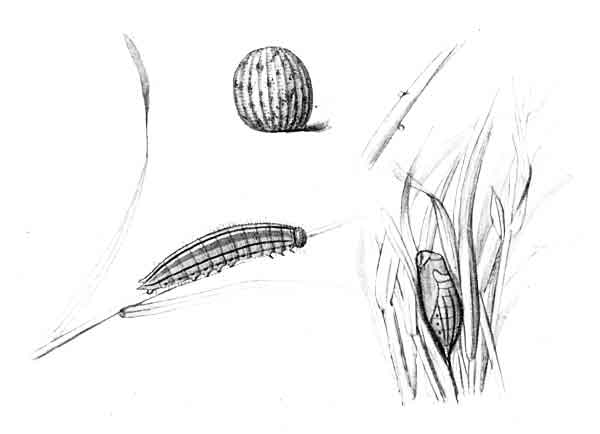
Pl. 76.
Scotch Argus.
Eggs, natural size and enlarged; caterpillar and chrysalis.
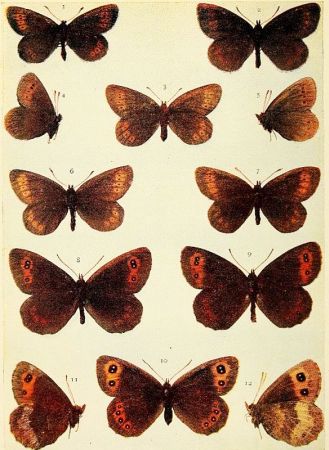
Pl. 77.
Small Mountain Ringlet.
1, 4 male; 3 female (English); 2, 5, 6, 7 male (Scotch).
Scotch Argus.
8, 11 male (Scotch); 9 do. (English); 10, 12 female (Scotch).
The chrysalis has the body ochreous, with a darker stripe down the back, and other lines; the eye covers are black, and the thorax, antennæ cases, and wing covers are dingy, dark purplish-brown.
The above descriptions of caterpillar and chrysalis are adapted from Buckler, whose figures of these stages are also reproduced on the plate.
Aira præcox, A. cæspitosa, and Poa are the grasses that seem to be the food of the caterpillar.
Mr. Haggart, of Galashiels, who had exceptional opportunities for observing the habits of this butterfly in its natural home, gives a most interesting account of it in the Entomologist for November, 1895. He writes—
"The haunt of this species is, almost without exception, the margin of a plantation or wood where the different species of Poa grow abundantly, and always situated in such a position as to receive the first rays of the rising sun. This last-mentioned fact is so plainly evident, that the least observant cannot fail to notice it. The insect is truly sun loving, and no collector need go in search of it with any thought of success if the day be dull.
"It is most interesting to observe the extreme sensibility of the insect to shine and shade. A very good day to illustrate this is one when heavy clouds at intervals obscure the sun; the moment it disappears so also does the butterfly, and no sooner does it shine forth again than, as if by magic, scores of the insect are on the wing.
"The under side of the insect bears a marked resemblance to that of a dead leaf, and I have often watched the males being deceived by withered leaves lying among the moss. They [Pg 116]would flutter down quite close to the leaf, immediately rise with a disappointed air and fly a little further, only to be deceived again and again.
"The ova are deposited amongst the Poa grass, and hatch in September. Towards the end of October the larvæ go down and hibernate throughout the winter and spring, coming up to feed again in May; they are generally full-fed about the end of June; and the insect appears in July or August. The larvæ are nocturnal feeders, coming up to feed on the grass just about dusk. The method of procuring the larvæ is by no means enviable, even to the most ardent entomologist, as in the uncertain light it necessitates crawling on one's hands and knees amongst the grass, and there is always the risk of grasping those little brown slugs in mistake, which resemble the larvæ very much in shape and colour. No artificial light can be used, as the larvæ immediately drop down amongst the grass if this is done. The only alternative, therefore, is to use one's eyes to the best advantage until the darkness makes that impossible.
"They are not difficult to rear in confinement if the larvæ are kept properly supplied with food."
This butterfly, which as a British species was discovered in the Isle of Arran in 1804, only occurs in the north of England and in Scotland. Its localities in the latter country are Glen Tilt and other valleys in the Perthshire highlands, Strathglass in Inverness, Altyre woods at Forres; Selkirk, Roxburgh, and various parts of Argyleshire; around the Lowther Hills, Dumfrieshire; also in Arran and the Isle of Skye. In most of the places it is plentiful. In England it occurs in the counties of Durham, Westmoreland, Cumberland, Lancashire, and Yorkshire. It is common in Castle Eden Dene, Durham; at Grassington, in Yorkshire; at Witherslack and Arnside, in Westmoreland; and at Grange and Silverdale, in Lancashire.
Abroad, it is distributed through Central and Southern [Pg 117]Europe, and its range extends into Northern Asia Minor, Kurdistan, and Armenia; the Altai and South Siberia.
It may be noted here that E. ligea was supposed to have been taken in Arran at the same time as E. blandina, that is in 1804. If this were so, it would seem that the captor must have exterminated the species, for, although the island has often been closely explored, no one has been able to detect the "Arran Brown" again.
On the upper side, this butterfly (Plate 78) is brown, more or less suffused with black, and this is especially noticeable on the outer area of the wings in the male, where it obscures the ochreous or rust-coloured bands, which in the female are almost free from the suffusion. The fore wings have two black spots, the upper one generally, and the lower often, pupilled with white. On the hind wings the bands are clear of blackish suffusion to a greater or lesser extent, and there is one black spot towards the anal angle which may be pupilled with white. Apart from its larger size and brighter bands, the female may be distinguished from the male by the absence of the blackish brand on the disc of the fore wings. On the under side, the fore wings are ochreous, tinged with orange on the basal half or two-thirds; hind wings are greyish, with darker markings, and an irregular white or whitish band beyond the middle.
Variation is largely confined to the under side of the hind wings, and these wings, as well as the costal edge and the tips of the fore wings, are coloured and marked, in various localities that the butterfly affects, so that the insects may be protected from their enemies when resting.
On the upper side of the fore wings an additional spot is [Pg 118]sometimes present below one or other of the usual ones. The bands of the wings are pale ochreous in some examples, and rust-coloured in others; but it is not unusual for a specimen with ochreous bands on the fore wings to have rust-coloured bands on the hind wings, or ochreous bands with rust-coloured patches on the outer portion; these patches are most frequently triangular in shape, and placed between the veins. Gynandrous specimens also occur, but very rarely.
The egg is of a dull creamy tint, ribbed, and with a slight depression on the top. The eggs were laid early in August, on blades and stems of a kind of grass; also on the leno covering, and the sides of the glass jar in which the female butterfly was enclosed.
The caterpillar when full grown "is drab, delicately mottled, with longitudinal stripes broadest along the middle segments, viz. a dorsal stripe of olive-brown, very dark at the beginning of each segment, with a thin edging of brownish-white. Along the subdorsal region are three stripes, of which the first is composed of a double narrow line of yellowish-brown, the second wider of the mottled ground colour, edged with paler above and with white below; the third of similar width is of a dark grey-brown, edged above with black. The spiracular stripe is broader and of nearly equal width, pale ochreous-brown, edged with brownish-white both above and below; the spiracles are black. The head is brown, and the principal stripes of the body are delicately marked with darker brown" (Buckler).
The chrysalis is described as "obtuse, rounded, tumid, and smooth, the abdominal rings scarcely visible, and wholly of a deep red mahogany colour." It was "in a hollow space a quarter of an inch below the surface, the particles of sand and earth very slightly cohering together, and close to the roots of the grass, yet free from them." The figures of caterpillar and chrysalis are drawn from those in Buckler's "Larvæ of British Butterflies."
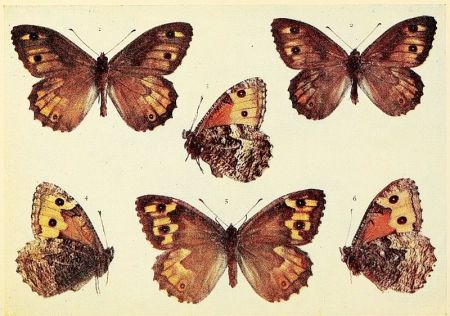
Pl. 78.
Grayling Butterfly.
Males, 1, 3 (Chalk), 2 (Heath); females, 4 (Heath); 5, 6 (Chalk).
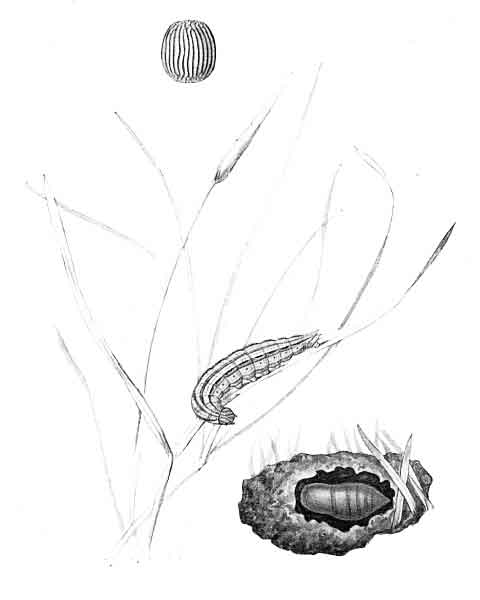
Pl. 79.
Grayling Butterfly.
Egg enlarged; caterpillar and chrysalis (both after Buckler).
The caterpillars hatch in August, hibernate when quite small, and feed up in the spring and early summer. They live upon grasses, such as Triticum repens, Aira cæspitosa, and A. præcox.
The butterfly delights in sitting rather than flying about cliffs and sand-hills, heaths and downs, stony hillsides, dry fields, and even open woodlands. It is fond of sunning itself on rocks, and by some of the old Aurelians it was called the "Rock Underwing," no doubt in reference to the pattern and colour of the under side. It was also known as the "Tunbridge Grayling" some two hundred years ago, when it was said to be "very rare about London." It has long since been ascertained to occur in almost every county in England and Wales, as far north as Sutherlandshire in Scotland, and is widely distributed in Ireland.
On the chalk downs and cliffs the butterfly has the under side of its hind wings so admirably agreeing in colour and marking with the soil, etc., that although one may watch it settle a few yards ahead, it is not to be seen when one reaches the spot. Whilst we are intent on the search the insect starts up, flies a short distance, and there repeats the disappearing butterfly trick. The same remarks apply to those Graylings that affect peaty or sandy heaths, etc. When the butterfly alights on the ground—and it rarely gets on the wing unless disturbed—it immediately closes its wings, and then allows them to fall more or less on one side, so that the whole of one hind wing is presented to view. It is said to have a fancy for the resinous sap that oozes from pine trees, and has also been observed to visit the trunks that have been "sugared."
Abroad, it is found commonly throughout the temperate parts of Europe, North Africa, and Northern and Western Asia.
Quite early in the eighteenth century Petiver met with the butterfly shown on Plate 80 at Enfield, so he figured it as the "Enfield Eye" in that curious old book entitled "Papiliorium Britanniæ Icones." Later on, Wilkes named the butterfly the "Wood Argus," thus indicating its favourite haunts, as well as a prominent character in its ornamentation. Harris changed the name to the "Speckled Wood Butterfly," which seems even more suitable.
The general colour is blackish-brown, and the spots are yellowish. The fore wings have one white-pupilled black eye spot towards their tips, and the hind wings have three such eye spots on the outer area. The male has a long oblique patch of blackish scales on the middle of the fore wings, which is, perhaps, more easily detected if the insect is held up to the light. The female is usually slightly larger than the male, the wings rather rounder, and the yellowish spots, are, as a rule, distinctly larger. The typical or southern form of this butterfly has the spots of a tawny colour, but it does not occur in Britain. Our form, in all its modifications, belongs to egerides, Staudinger. Occasionally, in the south of England, specimens are found in which the spots are tinged with fulvous; others have almost white spots. The spots are sometimes much reduced in size in the male, or greatly enlarged in the female.
The egg is pale greenish, finely reticulated; as the caterpillar matures within, the shell becomes less glossy than at first, and the upper part is blackish.
The caterpillar has a green head, which is larger than the first ring of the body (1st thoracic), covered with short fine whitish hairs, with which are mixed a few dark hairs. The body is rather brighter green, with darker lines, edged with yellowish, along the back and sides; the skin is transversely [Pg 121]wrinkled, the rings being subdivided, and the whole of the body is clothed with fine whitish hair and a few dark hairs arising from warts; the anal points are whitish and also hairy. It feeds on various grasses, among which are Triticum repens and Dactylis glomerata.
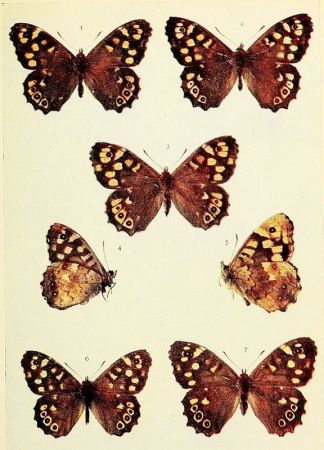
Pl. 80.
Speckled Wood.
Spring Brood: 1, 2 male; 3, 5 female. Summer brood: 4, 6 male; 7 female.

Pl. 81.
Speckled Wood.
Egg, natural size and enlarged; caterpillar and chrysalis.
The chrysalis is pale green, tinged with yellowish or whitish; the edges of the wing covers are brown, and there are whitish dots on the body. According to Hellins the colour varies, and green chrysalids may be covered all over with very fine smoky freckles. Barrett states that they are occasionally brownish with darker brown lines. Suspended by the cremaster from a silken pad.
From eggs laid in early May butterflies were reared at the end of June; and from eggs laid at the end of June butterflies resulted during middle August. Early July eggs produced perfect insects in early September, and from caterpillars fed up in October butterflies were obtained in November. These observations were not all made in the same year.
Barrett writes, "In the south of Surrey in 1862, the first emergence took place in April in abundance, these specimens became worn and disappeared, and a second emergence took place at the end of May, a third at the end of July, and a fourth in September; the next year the first emergence was in the third week in March, and again four broods were observed, but this is not the case every year, three emergences being probably the rule."
Mr. Joy has recorded that of caterpillars, resulting from a pairing induced in captivity, in August, eighty per cent. hibernated as pupæ, twenty per cent. as half-fed caterpillars. Butterflies from the winter pupæ emerged in May, but the caterpillars that had gone through the winter in that state did not produce butterflies until June. Possibly something of this sort occurs in the open, and we may suppose that the early and late spring butterflies are not separate broods, but early and late emergences of one brood. Butterflies seen on the wing in [Pg 122]November may be a few individuals that, owing to favourable weather, have emerged from chrysalids which under ordinary conditions would have remained as such during the winter.
Shady lanes, rides in woods, as well as the borders of the same, are its favourite haunts. It is not a sun-loving butterfly, but is generally found to frequent places where the sun's rays are more or less intercepted by a leafy screen. It seems to be more abundant in wet seasons than in dry ones. It is generally distributed throughout England and Wales, but more plentiful in southern and western counties than in the eastern and northern. In Ireland, Kane says, it is "everywhere abundant and double brooded." It is local in Scotland, and rare north of the Caledonian Canal.
Abroad our form of the butterfly egerides is found commonly in Central and Northern Europe, except in the extreme north, and in Northern Asia Minor and Armenia. The typical form, egeria proper, occurs in South-Western Europe, North Africa, and Syria.
The butterfly now under consideration is figured on Plate 82. It is bright fulvous in colour, with blackish-brown veins, margins, and transverse lines. There is one white pupilled black spot on the fore wings, and four of such spots on the outer area of the hind wings; the fourth, which is generally blind, is placed at the end of the series near the anal angle. The male has a very conspicuous sexual brand on the central area. The under side of the fore wings is paler than above, but the markings are similar, except that the brand is absent and the margins are greyer; the hind wings on the under side are greyish marked with brown and traversed by dark lines; there is a row of six eyed spots on the outer area; that nearest the anal angle is double. The female has more ample wings, and as the brand [Pg 123]is absent on the fore wings in this sex, the central black transverse lines are more distinct.

Pl. 83.
Wall Butterfly.
Eggs, natural size and enlarged; caterpillar and chrysalis.
Variation is chiefly in the size of the eyed spots; sometimes the apical one of the fore wings has a smaller one attached to its lower margin, or in the interspace (i.e. between the veins) above it or below it; or both extra spots, which are usually without white pupils, may be present. Very rarely the apical spot may be almost absent on one fore wing, but well defined on the other. The central transverse lines on the fore wings of the female are sometimes broad, and very occasionally the space between the lines is blackish; blackish-banded male specimens are also [Pg 124]found in some localities, such as the slopes of Dartmoor, Devon, as mentioned by Barrett.

Fig. 26.
The Wall Butterfly just emerged from the Chrysalis, and with wings distended.
The ground colour varies in tint, darker or lighter than normal, but specimens of a bright golden yellow-brown, straw colour, or whitish are known to occur, although such extreme aberrations are exceptional.
The egg is pale green when first laid, and in shape it is almost spherical, but rather higher than broad; it is finely ribbed and reticulated, but unless examined through a lens it appears to be quite smooth.
The caterpillar when full grown is whitish-green, dotted with white. From the larger of these dots on the back arise greyish bristles; the three lines on the back (dorsal and subdorsal) are whitish, edged with dark green; the line on the sides (spiracular) is white, fringed with greyish hairs; anal points green, hairy, extreme tips white. Head larger than the first ring (1st thoracic segment), green dotted with white and hairy, jaws marked with brownish. It feeds on grasses.
The chrysalis is green, with yellow-tinted white markings on the edge of the wing covers and ridges; the spots on the body are yellowish, or sometimes white. Occasionally the chrysalids are blackish, with white or yellow points on the body.
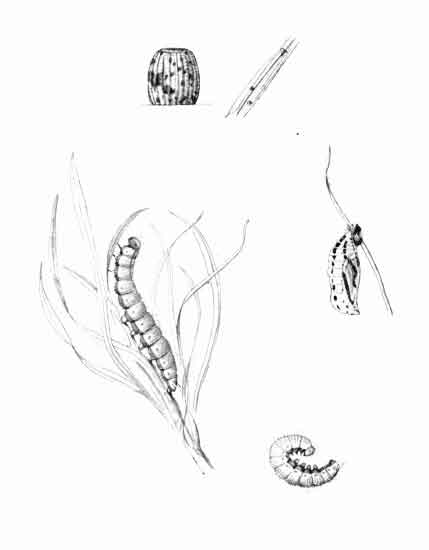
Pl. 85.
Meadow Brown.
Eggs, natural size and enlarged; caterpillars and chrysalis.
There are certainly two broods of this butterfly in the season, and in favourable years there may be three broods. In an ordinary way the first flight is in May and June, and the second flight in July and August. The caterpillars feed on Poa annua, Dactylis glomerata, etc. Those hatched in autumn hibernate more or less completely, and become full grown in early or late spring according to the season. Sometimes, however, they seem to feed during the winter, and assume the chrysalis in March. Probably it is from such precocious caterpillars that the butterflies sometimes seen in April result.
The Speckled Wood, it was noted, prefers shady places; the present butterfly is more partial to sunshine and plenty of it. [Pg 125]As its English name suggests, it is fond of basking on walls, but it does this also on dry hedge banks, sides of gravel pits, tree-trunks—in fact, wherever it can enjoy the full sunshine. It is not at all shy, and will be pretty sure to introduce itself to the notice of the collector as soon as he enters its domain. Although it now seems to be absent from certain districts in which it was once abundant, it may still be regarded as a generally common species in England and Wales, and even plentiful, in some years, in the southern, eastern, and western counties; it appears to be more local in North England. In Scotland it seems fairly distributed, and not scarce in the south; its range extends to Aberdeenshire. Kane states that it is everywhere abundant throughout Ireland. Abroad it is common throughout Europe, except the extreme north, and extends into North Africa, Asia Minor, and Armenia.
The female is the jurtina of Linnæus, and as he described this sex before the male, under the impression that they were distinct species, the law of priority, we are told, must be observed and the earlier name be adopted.
This fuscous-brown butterfly of the meadows is marked, especially in the female, with dull orange. The male, of which sex three specimens are shown (Plate 84, Figs. 1-3), has a broad black sexual brand on the central area of the fore wings, and a white pupilled black spot towards the tips of the wings; this spot is usually encircled with orange, and there is often more or less of this orange colour below it (Fig. 2 typical). The under side of the fore wings is orange with the costa narrowly, and the outer margin broadly, greyish-brown to match with the colour of the under side of the hind wings. The female is without the black brand, and is more ornamented with orange, which generally forms a broad patch on the outer area of the fore [Pg 126]wings (Fig. 6), but it is sometimes continued inwards, so that almost the whole of the discal area—that is, nearly all but the margins, appears to be orange (Fig. 7); the hind wings have an indistinct paler band on the outer area, and this is sometimes suffused or clouded with orange. On the under side the pale band is more defined (Fig. 5). The apical spot of fore wings is sometimes double, and a tendency to this variation is shown in Fig. 6, but in the complete form there are two white dots (bi-pupillated). At the other extreme, and generally in the male, the apical spot is entirely absent (var. anommata), or is greatly reduced in size, and is without the white pupil. Spots on the under side are as often absent as present. They may be from one to five in number, and either simply black dots or ringed with orange, as in Fig. 4. Occasionally the orange on the upper side of the female gives place to a pale straw or even whitish colour; and on the under side to whitish-grey.
Not infrequently a greater or lesser area of the wings is "bleached," and this seems to be due to absence of pigment in the scales on such parts. This bleaching may affect the whole or a portion of one wing only, or it may take the form of symmetrical blotches on each wing. All such abnormal specimens of this, and of other species similarly affected, are certainly of value to those who are interested in teratology, but they seem to be out of place in a collection of butterflies where the aim should be to show the true variation of species rather than "freaks," which are the result of accident or disease.
The egg, laid on a blade of grass as shown (Plate 85), is upright and ribbed; the top is flattened, with an impressed ring thereon. Colour, whitish-green inclining to brownish-yellow as it matures, and marked with purplish-brown.
The caterpillar is bright green, clothed with short whitish hairs; there is a darker line down the back, and a diffused white stripe on each side above the reddish spiracles; the anal points are white. Head rather darker green, hairy.
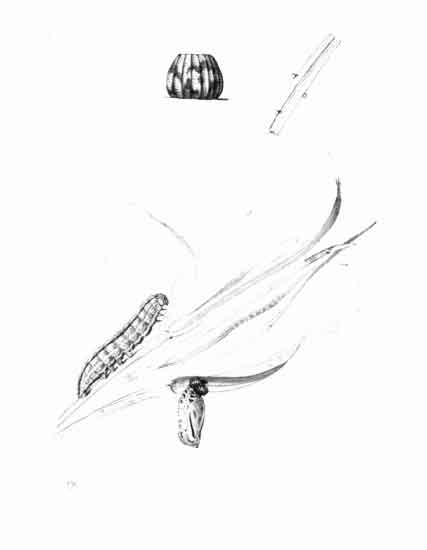
Pl. 86.
Gatekeeper.
Eggs, natural size and enlarged; caterpillar and chrysalis.
The chrysalis is pale green, marked with brownish on the wing-covers, the thorax is spotted with blackish, and the points on the body are brownish. Suspended, and with the old skin attached, as shown in the figure.
From its wide distribution and general abundance, this may be said to be our commonest butterfly. It appears to be always on the wing, in dull weather as well as in sunshine, and, except for a short interval in early August, it is to be seen in hayfields, open places in woods, on grassy slopes, or borders of highways and byways from June to September.
Although quite fresh specimens are fuscous-brown, the butterfly, after a short time on the wing, loses the dusky tinge and becomes brown. It is, therefore, always desirable to rear specimens for the cabinet from caterpillars. These feed on grasses of various kinds in May, are easily managed, and may be found in most hay meadows at night, when, of course, a lantern will be needed to throw a light on the business of collecting them.
The not infrequent occurrence of fresh specimens in the autumn is strong presumptive evidence of at least an occasional second brood. Perhaps, as has been suggested by Mr. R. Adkin, "a late emergence of Epinephele ianira is the rule rather than the exception," especially in the warmer parts of the country.
The butterfly is found throughout England and Wales, Ireland, and Scotland, including Isles of Lewis and Orkney. Abroad it occurs in all parts of Europe except the most northern, Asia Minor, Armenia, North Africa, and the Canary Isles.
Other English names in use at the present time for this butterfly (Plate 87) are "Small Meadow Brown," "Hedge [Pg 128]Brown," and "Large Heath," but the latter is more often applied to another species which will be referred to later. Petiver called it the "Hedge Eye."
The general colour is brownish-orange, and the margins are fuscous-brown; there is a black spot towards the tips of the fore wings, and this, as a rule, encloses two white dots; one or both of these dots sometimes absent in the male. The male differs from the female in its rather smaller size, and in having a fuscous band on the central area; the latter is broadest towards the inner margin, and in this part are some patches of blackish androconial scales or plumules; at the upper end of the band there is sometimes a fuscous cloud. Occasionally, one or more small black spots, some with white pupils, are present below the apical one. Four such spots are rare, but specimens with one or with two are not uncommon. There is usually a white-pupilled black spot towards the anal angle of the hind wing, but I have several males and females that are without this spot. Sometimes there are as many as four spots on the hind wings, but this is perhaps exceptional (Plate 113, Fig. 5). On the under side of the hind wings there are often two white dots, sometimes ringed with black, towards the costa, and two or three other similar dots towards the anal angle; but the number of dots may be reduced to two, one of which is near the costa, or be increased to six. Colour changes, similar to those in the last species, occur, and the orange colour, in both sexes, may be replaced by yellow (var. mincki, Seebold), or by white (var. albida, Russell, Plate 119, Figs. 6, 7). Such aberrations are very local and rare; a few have been obtained on chalk hills in South Hampshire.
In an extraordinary aberration, taken in Sussex in 1897, the whole of the dark brown colour of margins and band is replaced by pale pinkish-ochreous, but the normal brownish orange remains. Other somewhat similar specimens have been recorded.
The egg (Plate 86) is pale yellowish when first laid, becoming lighter and irregularly blotched with reddish-brown, the upper blotches forming a sort of band round the egg; as the caterpillar matures the shell assumes a darker tinge, inclining to slaty, and the markings are less distinct.
The caterpillar, when full grown, is pale ochreous, clothed with short pale hair, and freckled with brownish; the line down the back is darker, one on each side is paler, and that above the feet is yellowish. The head is rather darker than the body, marked with brownish, and bristly.
According to Hellins, the newly hatched caterpillar is whitish-grey, with rusty yellow lines on the back. In October, after the first moult, it becomes green with a brownish head. In April the body is greenish-grey, and the head pale greenish-brown. At the end of April it moults for the last time, and is then pale ochreous generally, but some caterpillars are darker than this, and some paler with a greenish-grey tinge.
The chrysalis is whitish-ochreous, with dark brown streaks on the wing-covers and some brownish spots and clouds on the back and sides. Suspended from stem or blade of grass; the old skin remains attached.
The caterpillars feed at night on grasses, such as Poa annua, Triticum repens, and Dactylis glomerata, from September to June. The butterfly is on the wing in July and August. Although these butterflies may be seen, sometimes in considerable numbers, where the rides are grassy, in woods, they are perhaps more attached to hedgerows. Bramble flowers are their special attraction, but they are not indifferent to the blossoms of the wood sage (Teucrium scorodonia) or of marjoram (Origanum vulgare).
Pretty generally distributed throughout England, it is often exceedingly plentiful in the south and also in South Wales. In Scotland the butterfly seems to be common in Kircudbrightshire, but not common in other southern counties up to Argyle [Pg 130]and Fife. Kane says that in Ireland it is almost confined to the southern counties.
Abroad it is found throughout Europe, except the North-East, and its range extends into Northern Asia Minor.
The sombre-looking butterfly, of which several figures will be found on Plate 89, has been known by its present English name since 1778, the year in which Moses Harris published "The Aurelian." The Latin specific name was written hyperantus by Linnæus, but Esper corrected this to hyperanthus. It has, however, been supposed that Linnæus really intended to have written hyperanthes (a son of Darius), and this form of the name has been used, but Esper's emendation is here adopted.
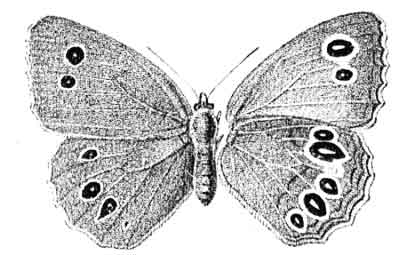
Fig. 27.
Var. lanceolata.
All the wings are sooty-brown, the male when quite fresh appearing almost black, and the sexual brand is then difficult to see; there are one or more black spots with pale rings, and sometimes white pupils, on the fore wings, but these are always more prominent in the female than in the male; in the latter sex they may be entirely absent. On the under side there are generally two, sometimes three, ocellated spots on the fore wings, and there are five such spots on the hind wings, the two nearest the costa being double, and not very infrequently there is a smaller spot near or attached to the lower edge of the double one. In the matter of size of the spots on the under side there is a wide range of variation, and at one [Pg 131]end of this is var. lanceolata, Shipp, and at the other var. obsoleta, Tutt, in which not a trace of any of the spots remains. Specimens with a varying number of white dots, with or without yellow rings, are usually referred to var. arete, but Fig. 6 on the Plate represents a modification of this variety, known as cœca.

Pl. 88.
Ringlet.
Egg, natural size and enlarged; caterpillar and chrysalids.
Occasionally, on the under side, there are transverse lines on the outer half of all the wings, and the space between these lines is suffused with whitish. The specimen showing these lines faintly (Fig. 3 on the Plate) is from North Cumberland.
The early stages are figured on Plate 88.
The egg is yellowish-white at first, but soon turns to a pale brown. As will be seen on comparing the enlarged figure of this egg with those of the two previous species, it is quite different in shape, and is pitted rather than ribbed. The eggs are not attached to anything, but are allowed to fall down among the roots of the grass over which they are deposited.
The caterpillar is described by Newman as pale wainscot brown in colour, with a darker line down the back, and the head has three broad, slightly darker but faint, stripes on each cheek. According to others it is ochreous or brownish-grey, with a dark brown line on the back, a pale one with darker edge on the sides, and a whitish stripe above the feet.
The chrysalis is ochreous-brown sprinkled with reddish-brown, and marked with brown on the wing-covers. It lies low down among the tufts of grass. The figures of caterpillar and chrysalis are from Buckler's "Larvæ of British Butterflies."
The caterpillars feed upon various grasses, including Poa annua and Dactylis glomerata, growing about damp places in woodland districts. They emerge from the egg in August, feed leisurely until October, when they appear to hibernate. In March they resume feeding, but do not attain full growth until June. The butterflies are on the wing in July and August, and frequent lanes and the outskirts of woods. They usually fly [Pg 132]along the shady side, but they are not averse to the nectar of the bramble blossom, and I have seen them taking a sip here and there although they were fully exposed to sunshine all the time.
Wherever there are suitable haunts the butterfly may be found throughout the greater part of England and Wales. It seems, however, to have disappeared from some districts in Lancashire and Yorkshire where it was formerly common. It is fairly plentiful in most of the southern counties of Scotland, and its range extends north to Aberdeen. In Ireland it is abundant in the south and the west, and seems to occur in most suitable places; also common in certain localities in Donegal and Antrim. Abroad it is distributed through Europe and Northern Asia eastward to Japan.
The butterfly now to be considered is a most variable one, both as regards colour and marking. Several of the varieties have been named, and in the time of Haworth down to Stephens, and even much later, at least three of these were regarded as distinct species. In the present day, however, it is generally accepted that all the varieties are forms of one species, although two local races are recognized.
The typical form is typhon, Rottemburg, and polydama (The Marsh Ringlet) of Haworth (Plate 90, Figs. 1, 2, 5, 7-11). The colour ranges from darkish-brown to a pale tawny; there is an ochreous ringed black spot towards the tips of the fore wings, sometimes another similar spot above the inner angle, and occasionally when both spots are present there is an ochreous spot between them; the hind wings have from one to three of these spots, but a larger number than three is exceptional. The under side of the fore wings is either bright or dull fulvous, and the spots are pretty much as above, but with white pupils, [Pg 133]and there is a whitish band before them; the under side of the hind wings is olive brown on the basal two-thirds, covered with pale hair, and the outer third is brownish merging into greyish on the outer margin; an irregular white or whitish band limits the two areas; there are six ochreous ringed black spots, with white pupils, but they are always rather small in size. The female is much paler than the male.
This is the usual form in Northumberland, Cumberland, Yorkshire, and Ireland; it also occurs in Lancashire, Westmoreland, and the South of Scotland.
Var. philoxenus, Esper. This is davus (Small Ringlet), Haworth, and rothliebii, Newman (Plate 90, Figs. 3, 4, 6).
On the upper side the colour is dark brown in the male and rather paler in the female; the spots are very distinct, ringed with fulvous; those on the hind wings are generally three in number, and often five or six; on the under side, the bands are whiter, and often broader, and the spots are very black, large, and conspicuous.
This form is found on some of the mosses in Lancashire and Westmoreland, in Delamere Forest, Cheshire, and in North Shropshire; but the most characteristic examples of the form are chiefly obtained in the first-named county, from which it was first made known, in 1795, as the "Manchester Argus," or "Manchester Ringlet."
Var. scotica, Staudinger (laidion, Staud., but not of Borkhausen), Pl. 90, Figs. 1, 2, 4, 5♂, 3♀, is the typhon of Haworth, as stated by Newman; the latter author, however, figures it as davus, Fabricius, which is doubtful.
The ground colour is pale tawny, sometimes suffused with brownish, greyish on the margin, and broadly so on the outer area of the hind wings; the spots are often absent, and when present are rarely very distinct. The female is much paler than the male. The under side of the hind wings is somewhat similar to that of the typical form, but sometimes the whole area is a [Pg 134]uniform greyish; the spots are only rarely at all distinct, and then only one, or perhaps two, on a wing, and not infrequently they are entirely absent. This form occurs in Scotland, especially in Aberdeenshire and Sutherlandshire, also in the Isle of Arran, in the Orkney and Shetland Isles, and in the Outer Hebrides. Kane states that he has met with single specimens at "Killarney, Westmeath, Galway, and Sligo."
In some localities, such as Carlisle, Rotherham, and others in Yorkshire, forms intermediate between the type and var. philoxenus are found; modifications of the type form in the direction of var. scotica occur in Cumberland, Northumberland, and Co. Leitrim, in Ireland; and forms approaching the type more nearly than var. scotica are met with in the Glasgow district, and at Pitcaple in Aberdeenshire.
The egg is very pale greenish-yellow at first, but the green fades, brownish blotches appear, and some dark markings appear around the upper part a short while before the caterpillar hatches out. It is finely scored almost from the base to the top, which is depressed, and has a raised boss in the centre, as in the egg of the Small Heath.
From some eggs sent to me in July, caterpillars hatched in August. They fed on ordinary meadow grass, and in September were figured, when they were about half an inch in length. Head shallowly notched in front, green, roughened with whitish dots, eyes and jaws brownish. Body green, roughened with white dots, with darker line down the back, and paler, almost white lines along the sides, anal projections reddish (these were greenish when younger).
The figure of the full-grown caterpillar is after Buckler, who describes it as "of a bright green, with dark bluish-green dorsal line, edged with pale lemon-yellow, the subdorsal and spiracular lines are of the same pale yellow, but the subdorsal is edged above with dark bluish-green, and between these two lines is an interrupted streak of a darker colour, posteriorly with a slight [Pg 135]tinge of reddish or pink, and the caudal fork is tipped with pink."

Pl. 90.
Large Heath.
1, 3, 4, 6 male, 2 female (Delamere); 7, 9 male, 5 female (Arran);
8 male (N. Salop); 10 do. (Ireland); 11 do. (Carlisle).
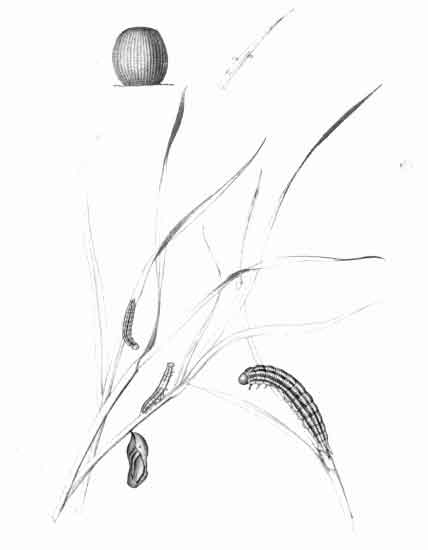
Pl. 91.
Large Heath.
Eggs, natural size and enlarged; caterpillars and chrysalis.
The chrysalis is bright green, with brown streaks on the edges and centre of the wing-covers, and at the tip of the tail, turning dark brown just before the butterfly emerges. (Figure and description after Buckler.)
The eggs are laid in July on blades of grass, and the caterpillars hatch out in that month and August. The food of the caterpillars is said to be the beaked-rush (Rhynchospora alba); those that I had from Witherslack eggs fed well upon ordinary grass until October, but they died during the winter. After hibernation they recommence feeding, and are full grown in May and June, when they pupate, and the butterflies appear at the end of June and in July.
Barrett, writing of the butterfly in all its forms, says, "Its most southern known locality in England is Chartley Park, Derbyshire, and it is common in all 'mosses' of Lancashire and Cheshire—all moors about Grange, and in Chat Moss, Risley Moss, Rixton Moss, Simondswood, Lindon Moss, and Carrington Moss, as well as at Delamere Forest. In Yorkshire abundant in Thorne Waste, not scarce in Wensleydale, and found on Cottingham Moor, Hatfield Moors, and elsewhere. Northward it is found in all suitable mosses and moors in Durham, Westmoreland, and Cumberland, but seems to have been exterminated in Northumberland."
In Scotland it appears to be pretty generally distributed, and occurs up to an elevation of some 2000 feet. Kane states that in Ireland it is widely spread throughout, on the bogs and mountains. It is stated to have occurred in North Wales a long time ago, but there are no recent records from that country. Abroad it is found in Central and Northern Europe, extending to Lapland, and through Northern Asia to Amurland. In North America it is represented by two forms, which are not quite like any of those occurring elsewhere.
To the ancient fathers the male of the butterfly on Plate 92 was known as the "Selvedged Heath Eye," and the female was called the "Golden Heath Eye." Harris figured it as "The Small Heath," or "Gatekeeper;" the latter name being now associated with another species, it may be allowed to drop out in the present connection.
The wings are pale tawny, with a brownish or greyish-brown border, of variable width, on all the wings, and stronger in the male than the female; there is a black spot towards the tip of the fore wing. The under side resembles that of the last species in some degree, but the eyed spots of the hind wings are not always prominent, often only white dots, and may be absent altogether (Fig. 9).
Variation in this species is extensive, but not striking. The tint of the ground colour may be reddish or yellowish; occasionally brownish or greyish-brown specimens of the male occur, and more rarely purplish-brown examples of the same sex have been found. Females, in all cases paler, and generally larger than the male, are sometimes whitish-ochreous in colour, and, very rarely, yellowish-white. The brown border is also a variable character, and may be very dark and broad (var. lyllus), or reduced to linear proportions. The apical spot on the fore wings may be of fair size and very black, very pale and indistinct (Figs. 8, 12), or entirely absent; it does not seem to be pupilled with white (as it is on the under side), but sometimes there is a pale speck in the centre. On the under side of the hind wings there is variation in the width of the central whitish band-like patch, in some specimens with unusually dark ground colour this patch is very broad; in other examples, of normal coloration, the band is complete, and extends to the inner margin. The white dots that normally do duty as ocelli are[Pg 137] not infrequently set in reddish-brown spots, and then become rather more noticable (Fig. 14). This form is var. ocellata, Tutt.
The egg is green at first, afterwards becoming whitish or bone-colour; later on a brownish irregular ring appears a little above the middle, and there are various brownish freckles. It is finely ribbed, and the top is depressed, forming a hollow with a central boss. Laid in a cluster of four on a blade of grass, but this may have been accidental. Others were deposited singly on muslin and on fine grass, all in mid-June. The caterpillar is of a clear green colour, "with darker green dorsal stripe, and a spiracular stripe not so dark; the anal points pink" (Hellins).
The chrysalis is of "a delicate pale rather yellowish-green, with a faintly darker green dorsal stripe, the edge of the projecting wing-covers on each side whitish, outlined with a streak of reddish-brown; the abdomen freckled very delicately with paler green; the tip of the anal point, with a short streak of brownish-red on each side; the wing-cases faintly marked with darker green nervures" (Buckler).
The figures of caterpillar and chrysalis on Plate 93 are from Buckler's "Larvæ of British Butterflies."
Some caterpillars, from eggs laid in May or June, become full-grown in four or five weeks, and appear as butterflies in August, but others do not complete their growth until the following spring. Just exactly what happens in the case of eggs from autumn females does not seem to be very definitely ascertained. It has, however, been stated that caterpillars hatching from eggs laid in August, attain the size of the slow-growing contingent from May eggs, and then hibernate. Probably, therefore, it is these that produce the July butterflies, and if so, the succession of emergences may be something in this way: May and June butterflies from May and June eggs (twelve months' cycle), July butterflies from August eggs (eleven months [Pg 138]cycle), August and September butterflies (partial second brood) from May and June eggs (four months' cycle).
This interesting little butterfly is to be seen almost everywhere, but it is perhaps most frequently to be found in grassy places in lanes, on heaths and downs, railway banks, in rough meadows, etc. It occurs on mountains even up to an elevation of 2000 feet. When flying in company with the blues and coppers, all frolicking together over some patch of long grass, the colour combination has an exceedingly pleasing effect. They rest by day, and sleep at night on grass or rushes.
A common species throughout England and Wales, Ireland and Scotland, as far north as Nairn, also in the Outer Hebrides. Abroad its distribution extends over Europe to South-West Siberia, Central and North-East Asia, Asia Minor, and North Africa.
We now arrive at the Hairstreaks, Coppers, and Blues. These belong to the Lycænidæ, a very large family of butterflies which is represented in all parts of the globe. There are eighteen species in Britain, but at least one of these is extinct and another is supposed to be so; two are very rare, and the chances of meeting with either are probably about equal.
The butterfly is represented on Plate 94, Figs. 1-3. The male is blackish-brown with a faint greyish tinge, and there is a conspicuous black bar at the end of the discal cell of the fore wing, followed by a pale cloud; there are two orange marks at the anal angle of the hind wings. The female is blackish-brown, and has the black bar at end of the cell, and an orange band beyond; there are usually three orange marks on the hind wings at the anal angle, but sometimes there are only two. The under side of the male is ochreous, but that of the female is more orange; the fore wings have the black bar edged on [Pg 139]each side with white, and there is a white-edged, brownish triangular streak beyond, the outer margin is tinged with reddish; on the hind wings there are two white irregular lines and the space between them is brownish, the outer margin is reddish, becoming broadly so towards the anal angle, where there is a black spot. Variation is not of a very striking character. The shade following the black bar at end of the discal cell on the fore wings in the male is sometimes yellowish tinged, not infrequently fairly large, and with two smaller spots below it. More rarely all three spots are distinctly ochreous-yellow (var. spinosæ, Gerhard). A similar aberration, but with the marks white instead of yellow, has been named pallida, Tutt. The orange band in the female varies in width and in length; occasionally it extends well below vein 2, and into the discal cell within the black bar. I have one specimen in which the band is broken up into three parts, and the upper one of these is but little wider than the same spot in var. spinosæ, the other two being almost exactly of the same size as in that variety.
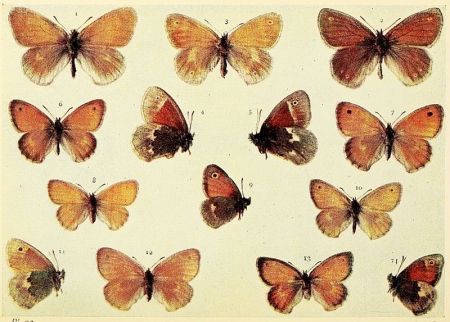
Pl. 92.
Scotch Large Heath. 1, 2, 5 male; 3, 4 female.
Small Heath. 6, 9, 10, 14 male; 7, 8, 11, 12, 13 female.
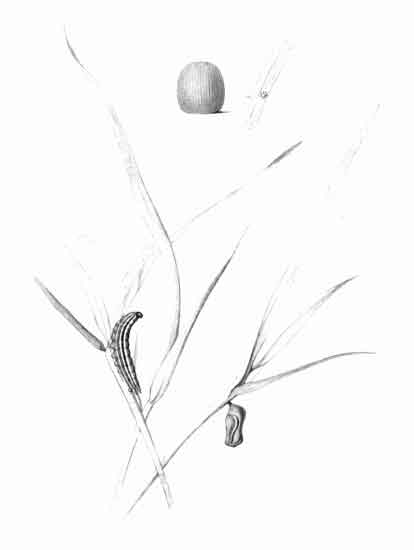
Pl. 93.
Small Heath.
Eggs, natural size and enlarged; caterpillar and chrysalis.
The life-history is figured on Plate 95—the lower set of figures.
The egg is described by Newman "as a depressed sphere and white," and he states, "it is attached to the twigs of blackthorn (Prunus spinosa) in the autumn, often as late as the end of September or beginning of October; it is not hatched until the spring."
The caterpillar is bright pale green, and the lines on the back and sides are yellowish, as also are the oblique streaks on the sides and the border of the ridge above the feet. There are some bristles along the ridge on the back and also on that above the feet. It feeds on blackthorn in May and June, and will eat the foliage of almost any kind of plum. I have reared fine specimens from caterpillars which fed on greengage.
The chrysalis is pale reddish-brown with a dark line down [Pg 140]the middle of the back and some pale oblique streaks on each side; the wing-cases are freckled with darker brown. Barrett, quoting Fenn, says, "Suspended by the tail and a silken girth to the stem of the food-plant close to the ground." Those that I have seen pupated on or under leaves, and so far as I could observe without any girth, and certainly not suspended.
Nearly two hundred years ago the male of this butterfly was known as the Brown Hairstreak, whilst the female was called the Golden Hairstreak. The caterpillar seems to have been observed in quite early times. It has always been a local species, and although it appears to frequent hedgerows occasionally, its haunts generally are open grounds in the neighbourhood of woods, where blackthorn or sloe is plentiful. August and September are the months for the butterfly, but it does not seem to be very often observed on the wing, even in places where the caterpillars are known to occur. When seen it is generally high up on, or around, some oak tree. Occasionally, however, it visits the bramble blossoms, and at such times becomes a fairly easy prey. The caterpillar is obtained by beating sloe bushes.
Barrett, who seems to have worked out its distribution in England and Wales pretty closely, remarks, "In the eastern counties it has been taken occasionally in Norfolk and Suffolk, more frequently in Essex, where, in Epping Forest, it has been fairly common; also in Cambridgeshire, Huntingdonshire, and Northamptonshire, in some plenty. In very few localities in Kent, Sussex, Hants, and Dorset; rarely in Gloucestershire, and possibly Somerset; but found in many Devonshire localities, especially in the sheltered valleys around the Dartmoor range, and in the charmingly wooded districts about Axminster and Sidmouth; becoming common towards Dartmouth. It has also been found commonly near Marlborough, Wilts, and plentifully in some parts of North Wales; apparently rare in South Wales, but certainly existing in some parts of the [Pg 141]wooded districts skirting Milford Haven. Also recorded from Worcestershire, and Cannock Chase in Staffordshire; and northward in the favoured districts of Grange and Silverdale in North Lancashire, and Witherslack in Westmoreland." As Surrey is not quoted in the foregoing, it may be mentioned as one of the counties in which the species is found. In Ireland Kane says that it is "abundant in certain localities in Munster; and in Co. Galway at Claring Bridge, and Oranmore; Cork; Killoghrum Wood, Enniscorthy; Blarney, Killarney."
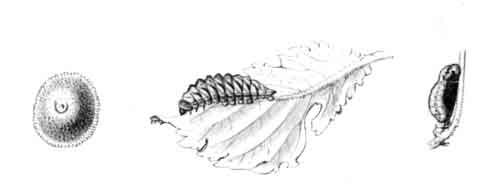
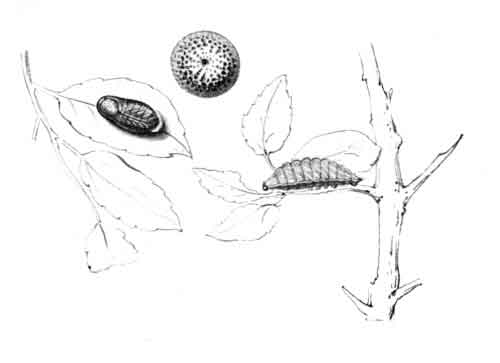
Pl. 95.
White-letter Hairstreak. Egg enlarged; caterpillar and chrysalis.
Brown Hairstreak. Egg enlarged; caterpillar and chrysalis.
It is distributed throughout Central and Northern Europe, except the Polar region, and its range extends through Northern Asia to Amurland, Ussuri, and China.
The butterfly (figured on Plate 96) has the sexes differently ornamented, as in the last species. The male is strongly tinged with purplish-blue, the veins are blackish; the outer margin of the fore wings are narrowly, and the costa and outer margin of the hind wings are broadly, bordered with black. The female is purplish-black, with two patches of bluish-purple in the discal cell and space below; often there is a smaller patch of the same colour between them, the whole forming a large blotch interrupted by the blackish veins. Under side greyish with blackish shaded white lines; two or three blackish clouds on the outer margin of fore wings above the inner angle; these are sometimes edged with orange; a black spot on anal angle of the hind wings, with an orange one above it, and a black-centred orange spot between veins 2 and 3.
Variation in this species is exceptional. An aberration known as bella, Gerhard, has a yellowish mark at end of the cell on the upper side of the fore wings, and at least one such variety has been taken in England. Sometimes the blotch on the female is rather blue than purple; a male specimen with blue streaks on the costa of the fore wings has been recorded, and [Pg 142]Barrett mentions a gynandrous specimen in which the right side was that of the male.
The egg is pale brown tinged with pink, and over this is a whitish network. The caterpillar is reddish-brown and downy; a black line along the back has a whitish edge, and there are whitish oblique stripes, with blackish edge, on each side of the central line; the segmental divisions are well marked, and the spiracles are blackish with pale rings. The head, which, when the caterpillar is resting, is hidden within the first body ring, is brownish and glossy, and there is a greyish shield-like mark on the second ring. The chrysalis is red-brown, with darker freckles; the body is downy, and there are traces of oblique marks thereon. It does not appear to be fastened by the tail, but the cast larval skin remains attached; there are a few strands of silk around and about the chrysalis, but these are very flimsy, although they hold it in position on the ground or under a leaf.
The eggs are laid in July or August on twigs of oak, but the caterpillars, it is said, do not hatch out until the following spring. In May and early June the caterpillars are full grown, and may be obtained by beating or jarring the branches of oak trees in places where the butterfly is known to occur. They have also been found on sallow.
This species frequents oak woods, or the borders thereof, in July and August, and is often more easy to see than to capture, as it has a tantalizing trick of flying around the upper branches of the trees. Occasionally it resorts to lower growing aspens, probably to feast on the honey dew, the secretions of Aphides, with which the leaves are often covered in hot summers. It seems to be pretty generally distributed in all parts of England and Wales, and in Scotland as far north as Ross. In Ireland it appears to be more local, and has only been recorded from the east and south.
It is found in all parts of Europe, except the northern.
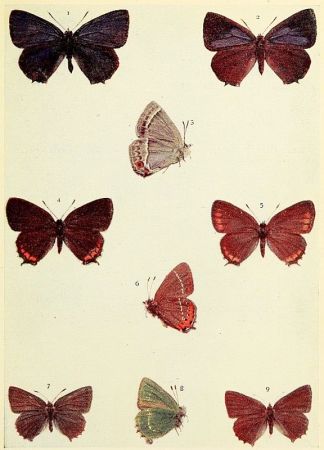
Pl. 96.
Purple Hairstreak. 1 male; 2, 3 female.
Black Hairstreak. 4, 6 male; 5 female.
Green Hairstreak. 7 male; 8, 9 female.
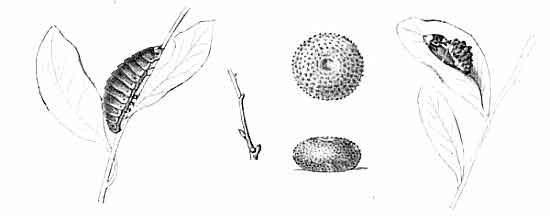
Black Hairstreak. Eggs, natural size and enlarged; caterpillar and chrysalis.
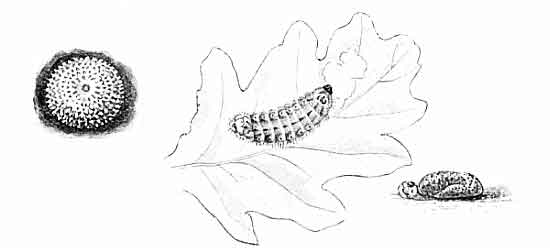
Purple Hairstreak. Egg enlarged; caterpillar and chrysalis.
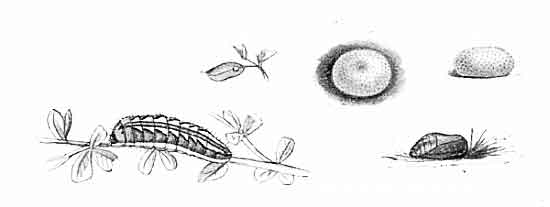
Pl. 97.
Green Hairstreak. Eggs, natural size and enlarged; caterpillar and chrysalis.
This butterfly is figured on Plate 96. In colour it is dark brown or, when quite fresh, brownish-black; there are some orange marks on the outer margin of the hind wings, and these are most distinct in the female, in which sex there are orange spots on the fore wings also. The male has a pale sexual mark at the end of the cell of the fore wings, but this is less distinct than in the following species. The under side is brown, with a bluish-white interrupted transverse line on each wing, that on the hind wings angled before reaching the inner margin. All the wings have an orange band on the outer margin, but on the fore wings of the male this is often indistinct; there are some white-edged black spots before it, and, on the hind wings, beyond it also.
The eggs are laid in July on the twigs of blackthorn, but the caterpillars do not hatch until the following spring. The egg figured on Plate 97 was reddish-brown and appeared rather shiny. The caterpillar is described as yellowish-green, with a darker green furrow and purplish ridges along the back; the latter are edged with whitish and the divisions between the rings are yellowish. The head is pale brown. The chrysalis, which is attached by the tail and has a silken thread around it, is black, marked on the head and body with yellowish-white.
The caterpillars feed on blackthorn (Prunus spinosa) in a state of nature, but will eat the leaves of damson in confinement. They may be obtained in May, in their particular haunts, by beating sloe bushes with a beating tray, or an inverted open umbrella, held under to intercept the evicted caterpillars, etc.
This butterfly was not known as British until 1828, when a number of specimens were captured at Monkswood in Huntingdonshire. These were sold by the captor as T. w-album, which was then called the Black Hairstreak. As soon as the mistake was detected, it was given out that the [Pg 144]specimens had been taken in Yorkshire, but this was only a ruse, as T. pruni has never occurred in that county. It is confined, so far as Britain is concerned, to three or four of the midland counties. "Mr. Herbert Goss, who has found it at Barnwell Wold, and in other wooded districts of Northamptonshire, at intervals, for more than twenty years past, says that it is fond of sitting on the flowers of privet (Ligustrum), and of Viburnum lantana, in the woods, and sometimes is to be found in numbers. Its time of emergence is very variable, apparently regulated by the lateness of the spring—from June 17th to the first week in July. Reared specimens made their appearance from June 13th to 27th. He writes, 'It was the greatest possible pleasure to see them walking about the table while I was at breakfast.' In 1858 it was found commonly at Kettering, and in 1859 at Oundle, and has been recorded at Warboys Wood, Huntingdonshire, and in Buckinghamshire. One specimen was taken at Brandeston, Suffolk, by the Rev. Joseph Green; and Mr. Allis found it commonly in the Overton Woods and about St. Ives. There is also a record in Monmouthshire, which may require confirmation. This butterfly does not appear to be losing ground in this country, its fondness for trees and lofty bushes rendering it difficult to capture" (Barrett).
A writer in the Entomologist for 1874 mentions Linford Woods, in Bucks, as a locality where he had observed several specimens, mostly females, on flowers of privet.
It is found throughout the greater part of Europe and also in Amurland and Corea.
The male of this butterfly (Plate 94) is blackish, with a small whitish sex mark at end of the discal cell of the fore wing; there is a small orange spot at the anal angle of the hind wings. The female agrees in colour [Pg 145]with the male, but the tails are longer, and there is no sex mark on the fore wings. The under side is brownish, with a white line on each wing, that on the hind wings forming a W before the inner margin; the hind wings have a black-edged orange band on the outer margin which is finely tapered towards the costa. Captured specimens are usually browner than those that are reared from caterpillars.
The species does not exhibit much tendency to variation. The white lines on the under side may be rather broad or very narrow, and that on the hind wings is sometimes so broken up towards the inner margin that the W character disappears; when absence of the anal orange spots on the upper side is associated with the broken line, the form is known as butlerowi. I have several males without the W, and some of these have the orange spot above, whilst others are without it. Barrett refers to a specimen in which there is "on the under side an extension of white colour from the white line towards the margin, in the fore wings forming a broad wedge-shaped band, but in the hind wings occupying the whole space from the white line to the orange band."
The egg has been described as whitish in colour, and in shape something like an orange with a depression on the top. The eggs are laid on twigs of elm in July, and, according to some writers, remain thereon throughout the winter. The caterpillar when full grown is yellowish-green and covered with short hairs; the ridges on the back are yellowish, and there are oblique whitish streaks on each side of the darker dorsal line. The head is black. When about ready to assume the chrysalis state, the whole body becomes purplish-brown. The chrysalis is brownish, sometimes tinged with purple; covered with tiny bristles except on the blackish wing cases, and there are two purplish lines on the back. It is attached by the tail, and has a strand or two of silk around it, generally on the under side of a leaf.
In a state of nature the caterpillar feeds on wych-elm (Ulmus montana), but it will eat the leaves of the common elm (Ulmus campestris). It is to be obtained in May and June by beating wych-elms in localities where the butterfly is known to occur.
The butterfly is on the wing in July, and usually disports itself around the elm trees, but it is fond of bramble blossoms, and may often be netted when feasting on those flowers. It is a local species, but, as a rule, plentiful enough in its localities. It is rare in Hampshire and Dorsetshire, scarce in Sussex, and not found in many parts of Kent. Ripley, in Surrey, was a well-known locality for it in the early part of the last century, and the caterpillars were found there commonly quite recently. In Essex it is generally common near Maldon. And, according to Barrett, it is "plentiful in various parts of Suffolk; very scarce in Norfolk; found more or less plentifully in Herts, Hants., Cambs., and Northamptonshire; very rare in Nottinghamshire; but again to be found in North Lincolnshire; and common in several localities near Doncaster, Barnsley, and elsewhere in Yorkshire. This appears to be its northern limit, and in this respect it contrasts curiously with Thecla betulæ [The Brown Hairstreak], since it extends farther north in the east than that species; yet in the west is recorded no farther than Cheshire and Shropshire, where I found it thirty-five years ago upon Benthall Edge. In Herefordshire it is recorded but rarely; more commonly in Worcestershire; also in Derbyshire and Needwood Forest, Staffordshire; common around Burton-on-Trent and elsewhere in Leicestershire; and in Oxfordshire, Bucks, and Berks. But its metropolis seems to be Wiltshire, where Mr. Perkins has found it around Marlborough and Savernake in thousands, as well as in Gloucestershire." It has also been obtained in Monmouthshire, but its extreme western limit seems to be Weston-super-Mare, Somersetshire. Abroad it is widely distributed in Europe, except the [Pg 147]extreme north and south-west; its range extends into Asia Minor, and to Amurland and Japan.
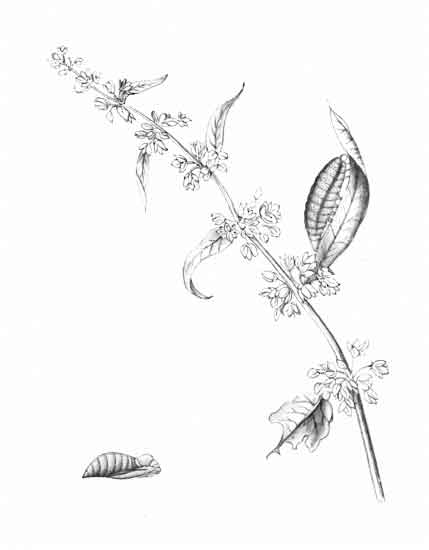
Pl. 99.
Large Copper.
Caterpillar and chrysalis.
Thecla spini and T. ilicis, two species of Hairstreak butterflies belonging to Central and Southern Europe, have been mentioned as occurring in Britain by some of the earlier authors. There is not, however, the slightest reason to suppose that either of them ever occurred naturally in this country.
Both sexes of this butterfly (Plate 96) are brown with a faint golden tinge above, and green on the under side. The male has a dark, or, when the plumules are dislodged, pale sexual mark, which is oval in shape, and placed at the upper corner of the discal cell in the fore wings. Occasionally there are some orange scales at the anal angle of the hind wings, and more rarely, and in the female, at the extremities of veins two and three also. On the under side of some specimens, chiefly from Northern localities, there is a transverse series of white dots across all the wings; more often these are confined to the hind wings, and sometimes they are almost or quite absent from all the wings. Now and then the under side of the hind wings is found to be brown in colour, and this change in colour has been ascribed to the action of moisture. The life-history is figured on Plate 97.
The egg is greenish, reticulated with paler or with whitish-green; the reticulation is somewhat rough on the side, but becomes finer towards and on the top, which has the centre hollowed. Laid on the petals of the common furze (Ulex europæus), and on leaves of rock-rose (Helianthemum chamæcistus).
The caterpillar feeds in June and July. It is pale green, with a darker line along the back, and yellow oblique stripes on the sides. Among the plants that it has been found upon, or is known to eat, are dyer's greenweed (Genista tinctoria), needle [Pg 148]furze (G. anglica), broom (Cytisus scoparius), dwarf furze (Ulex nanus), whortleberry (Vaccinium myrtillus); also the berries of buckthorn (Rhamnus), making holes through which the contents of the berry is extracted; buds of bramble (Rubus), and of dogwood (Cornus sanguinea), are also attacked in a similar way.
The chrysalis is clothed with tiny hairs, and when freshly formed is green in colour, but becomes purplish-brown after a time. It appears to be unattached to anything. I think, however, that there are generally a few strands of silk around or about it, but these are so easily broken when the chrysalids are removed that they escape observation. May and June are the months for the butterfly, which occurs in various kinds of situations, such as the outskirts of woods, high hedgerows, hill slopes, and boggy heaths. I once saw it in abundance about the entrance from Lynton to the Valley of Rocks. Its resemblance on the under side to the leaves on which it perches is as baffling to the collector as is the resting habit of the Grayling butterfly previously referred to. It seems to be pretty generally distributed throughout the kingdom, but is rather more local in Ireland than elsewhere, and it has not yet been recorded from the Orkney or Shetland Isles. Its range extends throughout the Palæarctic Region.
The brilliant butterfly, figured on Plate 99, is of a coppery orange colour. In the male the fore wings have two black dots in the discal cell, the outer one linear, and the outer margin is narrowly blackish; the hind wings have a linear black mark in the cell, and the outer margin is narrowly edged with blackish and dotted with black. The female is more conspicuously marked with black; there are two, sometimes three, spots in the cell of the fore wings, and a transverse series of seven[Pg 149] or eight beyond; the outer margin is broadly bordered with black, and there are generally two spots above the inner angle; the hind wings have a black spot in the cell, and a series of black spots beyond, but the whole basal three-fourths of these wings is often deeply suffused with blackish; the outer margin is bordered and spotted with black. The sexes are much alike on the under side, and have reddish-orange fore wings with bluish grey outer margins, and black spots as on the upper side of the female; the hind wings are bluish-grey, powdered with bluish towards the base, and with whitish ringed black spots; five of these spots are before the linear discal mark, and a series of nine or ten beyond; an orange band on the outer margin has black dots on each edge.
Except as regards the size and the shape of the spots, especially in the female, there appears to have been but little variation noted in this species in England.
The two fine female specimens figured on the plate have a more or less distinct wedge-shaped black spot in the basal end of the discal cell of the fore wings. Dale mentions that he has an "almost entirely black" example of the female in his collection.
The var. rutilus, which is the continental form of our butterfly, is smaller in size, as a rule, the spots are not so large, and the orange band is always narrower on the under side of the hind wings. It has been averred that some of the British specimens are referable to this form.
Newman, writing about 1870, gave the following life-history details:—"The egg is laid on the leaves of the great water-dock (Rumex hydrolapathum) during the month of August, and the young caterpillars (never, to the best of my belief, observed) probably emerge during the following month, and hibernate very early at the base of the petioles.
"The caterpillar is full fed in June, and then lies flat on the dock-leaf, rarely moving from place to place, and, when it does[Pg 150] so, gliding with a slug-like motion, the legs and claspers being entirely concealed. The head is extremely small, and can be completely withdrawn into the second segment: the body has the dorsal surface convex, the ventral surface flat; the divisions of the segments are distinctly marked, the posterior margin of each slightly overlapping the anterior margin of the next, and the entire caterpillar having very much the appearance of a Chiton; the sides are slightly dilated, the legs and claspers are seated in closely approximate pairs, nearly on a medio-ventral line. The colour is green, scarcely distinguishable from that of the dock-leaf; there is an obscure medio-dorsal stripe, slightly darker than the disk, and in all probability due to the presence of food in the alimentary canal. The chrysalis is obese, blunt at both extremities, attached by minute hooks at the caudal extremities, and also by a belt round the waist." Newman adds, "My acquaintance with the caterpillar and chrysalis was made very many years ago in Mr. Doubleday's garden at Epping, where the very plant of Rumex hydrolapathum, on which the caterpillars fed, is still in existence."
The caterpillar was described by Stephens, in 1828, as somewhat hairy, bright green, with innumerable white dots. The same author states that the chrysalis was "first green, then pale ash-coloured, with a dark dorsal line and two abbreviated white ones on each side, and, lastly, sometimes deep brown."
The figure of the caterpillar on Plate 98 is after Westwood, and that of the chrysalis after Newman ("Grammar of Entomology").
Although he refers to it as "hippothoë," the Large Copper seems to have been known to Lewin (1795), as he states that specimens had been taken in Huntingdonshire. Haworth (1803) mentions its occurrence in the fens of Cambridgeshire, and Stephens, twenty-five years later, wrote:—"This splendid insect appears to be confined to the fenny counties of Cambridge and Huntingdon, with the neighbouring ones of Suffolk [Pg 151]and Norfolk, unless the account of its capture in Wales by Hudson be admitted; but this may probably be the following species [hippothoë], which may, moreover, eventually prove synonymous with Ly. dispar. In the first two localities it appears to occur in great profusion, as several hundred specimens have been captured within these last ten years by the London collectors, who have visited Whittlesea and Yaxley Meres, during the month of July, for the sole purpose of obtaining specimens of this insect."
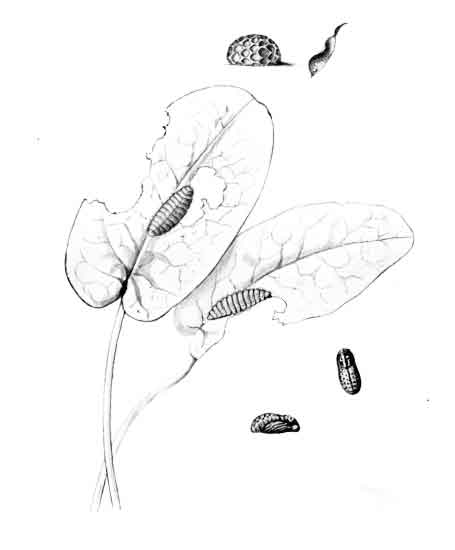
Pl. 100.
Small Copper.
Egg, natural size and enlarged; caterpillars and chrysalids.

Pl. 101.
Small Copper.
1, 2 Typical male; 3 typical female; 4, 5, 6, 8, 9, 10, 11, 12
varieties; 7 var. schmidtii.
Dale states that "the latest capture, consisting of five specimens, appears to have been made in Holme Fen, by Mr. Stretton either in 1847 or 1848."
There is evidence that floods, which were not uncommon in the home of the Large Copper, were not really injurious to the butterfly, and therefore the occasional submergence of its feeding grounds can hardly have been the cause of its almost sudden destruction. It seems more probable that its disappearance was due to the draining of the fens, and at least it is significant that the two events were almost coincident.
There are records of the butterfly having been taken in various odd localities since it was last seen in fenland, but the latest of those dates back to the year 1865. There seems to be no question that the butterfly is now extinct in England, and, lamentable to relate, the chief locality where we can hope to secure a specimen or two for our collection is in the neighbourhood of Covent Garden, where the only requirement for the capture will be a well-lined purse.
The continental form rutilus is found in Germany, France, Northern Italy, South-Eastern Europe (except Greece), Northern Asia Minor, Armenia, and the Altai. The Asian form auratus occurs in South-Eastern Siberia, Amurland, Corea, Northern China, and Amdo.
Four other kinds of "Coppers" have been reported as [Pg 152]occurring in England: these are Chrysophanus hippothoë and C. virgaureæ, both of which have even had English names bestowed upon them, to wit, the Purple-edged Copper and the Scarce Copper; C. gordius, and C. circe (dorilis). These are only mentioned to afford an opportunity for saying that there does not appear to be the least reason for considering either of them to be a British butterfly. Kirby, Barrett, and others, however, think it possible that the first two may have inhabited England in ancient times.
This little butterfly is very smart, in activity as well as appearance. In colour it is very similar to the last species, but both sexes are spotted with black on the fore wings, the outer series of six spots forming a very irregular row; the hind wings are black, with a wavy orange-red band on the outer margin.
There is considerable variation, and it is, therefore, deemed advisable to give a number of figures representing some of the more striking aberrations. The three figures at the top of Plate 101 depict the normal male and female; the latter sex is Fig. 3. For the loan of the other specimens (Figs. 4-12) my thanks are due to Mr. E. Sabine, who has a very fine and extensive series of varieties of this butterfly. Other examples of aberration on the under side are shown on Plate 119. Blue spots are sometimes found on the hind wings; these are placed near the orange-red band, and occasionally they attain a good size. Specimens much suffused with blackish sometimes occur; these are referable to var. eleus, which is the usual summer form in some of the warmer countries abroad. A very rare form is that known as schmidtii (Fig. 7), in which the ground colour of the fore wings and the band on the hind wings are silvery white instead of orange or coppery-red. A modification [Pg 153]of this form which is hardly less rare has a creamy tint. Straw-coloured or pale golden specimens are rather more frequently met with. The colour of the hind wings in fresh specimens is sometimes steely-grey, but blackish is the more usual hue; the band on the outer area, which as a rule agrees in colour with the fore wings, varies in width a good deal, and occasionally is more or less obscured by the blackish ground colour. The arrangement, size, and shape of the black spots, both above and below, are subject to much vagary, sometimes of a very striking kind, as, for example, when the spots of the outer series on the fore wings are united with the discal pair and form a large irregular blotch. A remarkable specimen taken some years ago in the Isle of Wight had a small patch of copper with a black spot in it on the under side. This gave one the idea of a clumsy attempt at patching, but as I happened to take that particular specimen, I know that it had not been tampered with. Gynandrous specimens of this butterfly sometimes occur, but these are very rare.
The egg is of a yellowish-white colour at first, and afterwards becomes greyish; the pattern on the shell, which resembles network, is always whiter.
The caterpillar is green and similar in tint to the leaf of dock or sorrel upon which it feeds. It is clothed with short greyish hair which arises from white dots; the dorsal line is brownish-olive, and the ring divisions, especially along the back, are well defined. Head very small, pale brownish, marked with blackish, drawn into the first ring of the body when resting. The legs and prolegs are tinged with pink, and sometimes the body is marked with pink.
The chrysalis is pale brown, sometimes tinged with greenish, and freckled with darker brown; there is a dark line along the middle of the thorax and body, the wing cases are streaked with blackish, and the body is dotted with black. Attached by the tail and loose silken threads around the body to a leaf or stem.
There seem to be three broods of this species in most years: the first is on the wing in May, sometimes in April; the second in July or early August; and the third in early October. It is not a difficult species to rear from the egg, and as varieties appear to be most frequent in the third brood, the eggs should be obtained from females of the second brood. Dock and sorrel (Rumex) are the food-plants of the caterpillar, and these are most useful in a growing condition.
The butterfly frequents all kinds of open situations, and is fond of basking upon flowers, more particularly those of the Compositæ, from which vantage ground it dashes with great alertness at any other small butterfly that may happen to fly that way. Whether these seeming attacks are really due to pugnacity, as has been stated by some writers, or are merely of a sportive character, is not altogether clear. As, however, the meeting of the two butterflies usually results, when both are Small Coppers, in a series of aërial evolutions by the pair, it would seem that there is a good deal of playfulness in the business. After the gambol is over, one butterfly may dart off with the other in hot pursuit, and then both move so rapidly that their course is difficult to follow. If the butterfly intercepted happens to be a Blue or a Small Heath, the Copper returns to the flower from which it started, and prepares for another raid when the opportunity offers. It occurs throughout the United Kingdom, but in Scotland it does not extend northwards beyond the Caledonian Canal.
Abroad it is found throughout the Palæarctic Region, and is represented in North America by the form hypophlæas.
The male is purplish-blue suffused with fuscous, especially on all margins except the inner one; there are two velvety black spots encircled with pale blue at the anal angle of the hind [Pg 155]wings, and a slender black tail, tipped with white, appears to be a continuation of vein 2. The under side is grey-brown, with numerous white wavy lines and broader streaks; there is a whitish band on each wing before the outer margin, and black spots as above, but these are ringed with metallic blue.
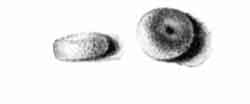
Short-tailed Blue. Eggs enlarged.
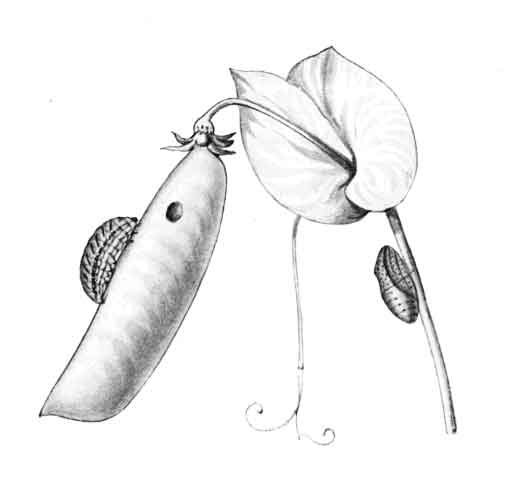
Pl. 102.
Long-tailed Blue. Caterpillar and chrysalis (after Millière).
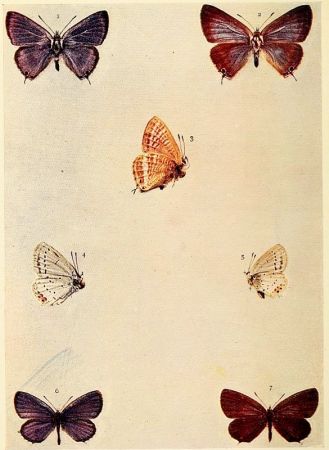
Pl. 103.
Long-tailed Blue.
1 male; 2, 3 female.
Short-tailed Blue.
4, 6 male; 5, 7 female.
I have not seen any of the early stages of this butterfly. The caterpillar, which feeds upon the green seeds in pods of the Leguminosæ, including the garden pea and the lupine, is figured on Plate 102. It is described as being green or reddish-brown in colour, with a dark stripe on the back, double oblique lines on the sides, and a white line below the yellow spiracles; head black. The chrysalis is of a red or yellowish colour, and dotted with brown. It has a silken girdle and is said to be attached to a stem, as shown in the figure, but probably it is more often fixed up among the withered leaves of the food-plant. Two of the earliest known British specimens of this butterfly were taken by the late Mr. Neil McArthur on August 4th and 5th, 1859, on the Downs at Brighton; the third example was captured by Captain de Latour at Christchurch, where it was flying about a plant of the everlasting pea in his garden on August 4th of the same year. Newman has noted that in that particular year the butterfly was very abundant in the Channel Islands and on the coast of France. No other specimen seems to have been observed in England until 1879, in which year one was taken at Freshwater in the Isle of Wight on August 23rd. In 1880 a specimen was captured in a garden near Bognor, Sussex, on September 12th. On October 2nd, 1882, one was obtained at West Bournemouth. Three were netted in 1893, one of these in late August, and one in the third week of September, both in Sussex; the third was taken in Kent (inland) in September. In 1899 a specimen was found at Winchester on September 1st, and one at Deal on the 16th of the same month; each of these, curiously, was sitting on a window. On August 2nd, 1904, one example was taken in a[Pg 156] garden near Truro, Cornwall. In addition to the above, single specimens have been reported as taken at Brighton, July, 1890, and at Heswell, Cheshire, in 1886 or 1887.
It will thus be seen that the occurrence of this butterfly in England is exceedingly infrequent. The species is common in Africa and in Southern Europe; thence it extends eastward through Asia to China and Japan, and southwards to Australia. It is also found in the Sandwich Islands. It is believed to be migratory in its habits, and it is supposed that the occasional specimens that arrive in this country come to us viâ the west coast of Europe.
In its proper home there is a succession of broods of the butterfly, and if by chance a few females were to visit this country in the early summer, they most probably would lay eggs, and the caterpillars resulting from these would almost certainly be able to feed up and attain the perfect state here. So far there is no reason to suppose that the caterpillar has ever occurred in England.
The interesting little butterfly represented on Plate 103 was not known to occur in Britain until 1885, when the Rev. O. Pickard Cambridge made the startling announcement that his sons had captured two specimens, a female on August 18th, and a male on August 20th of that year, the scene of capture being Bloxworth Heath, Dorset. Shortly after this fact was made public the Rev. J.S. St. John added a record of two males that he had discovered in a small collection of Lepidoptera made by Dr. Marsh, who stated that he had taken the specimens of C. argiades in 1874, close to a small quarry near Frome. In addition to these a specimen, also recorded by Mr. Cambridge, was taken at Bournemouth in August, 1885; one is reported to have been captured at Blackpool, about 1860; and [Pg 157]one at Wrington, about twelve miles north of Bristol, in 1895 or 1896.
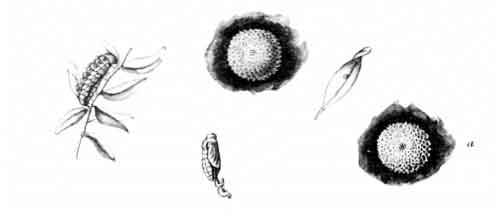
Brown Argus.
Egg, natural size and enlarged; caterpillar and chrysalis;
(a) Egg of "Scotch Argus" enlarged.
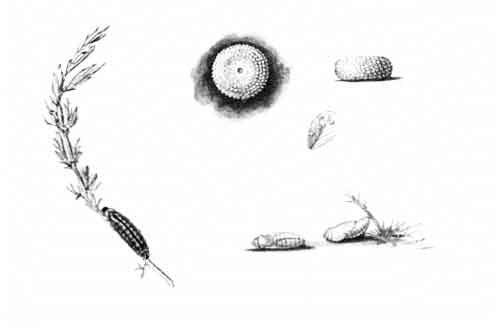
Pl. 104.
Silver-studded Blue.
Eggs, natural size and enlarged; caterpillar and chrysalids.
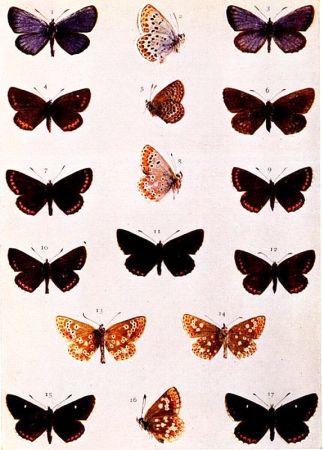
Pl. 105.
Silver-studded Blue. 1, 2, 3 male; 4, 5, 6 female.
Brown Argus. 10, 12 male; 7, 8, 9 female; 11, 13, 14
male (Durham); 15 male, 16, 17 female (Scotland).
The following details of the early stages are obtained from Mr. Frohawk's life-history of the species published in the Entomologist for October, 1904. The egg (Plate 102, figured from a photomicrograph by Mr. Tonge) is of a pale greenish-blue, but varies both in the extent of the ground colour and in the structure of the reticulations, which are white, resembling frosted glass.
The full-grown caterpillar (August 23rd) measures 3/8 inch in length. It is of the usual wood-louse shape, with only a very shallow furrow on the back, bordered on each side by a fringe of spinous bristles, which vary in length; the whole surface is densely studded with shorter but similarly formed whitish or brownish bristles. The ground colour is pale green, with a darker green stripe along the centre of the back, and fainter green oblique stripes on the sides. The head is black and shining, and is hidden under the first ring when the caterpillar is not feeding or moving about.
The caterpillars hatched on July 30th, from eggs that were laid in the South of France on July 24th, and were reared on bird's-foot trefoil (Lotus corniculatus), of which they ate the flowers, seeds, and leaves.
The chrysalis, which is attached to the food-plant by a silk pad at the tail and a thread round the body, is pale green and very finely reticulated; the wing-cases are rather whiter green, sprinkled with minute black specks, and the veins are white; there is a blackish line along the centre of the back, but this is only well defined on the head and thorax. The whole surface, except the wings, is sprinkled with slightly curved and moderately long white hairs.
The butterfly emerges in about ten to fourteen days, according to temperature.
The male is violet-blue with the veins rather darker; the [Pg 158]outer margin is narrowly bordered with blackish, and there are some black dots on the outer margin of the hind wings; the fringes are white, and there is a slender tail on the hind wings. The female is brownish, tinged with violet towards the base; the hind wings have black spots on the outer margin, and some of these are inwardly edged with orange; the tails are slightly longer than those of the male.
All the available information concerning the occurrence of this species in England has already been given. No doubt the localities from which specimens were recorded have been closely investigated during the past twenty years, but no further captures of this butterfly have been recorded. This seems to indicate that it is not really indigenous, but that its presence here may possibly have been due to accidental introduction.
The spring form, polysperchon, is smaller than the specimens occurring in the summer, but so far that form has not been seen in England.
The species is widely distributed over Central and Southern Europe, and its range extends through Northern Asia to Amurland, Corea, and Japan. It is also represented in Northern and Central America by var. comyntas, and has been recorded from Australia.
The male of this butterfly (Plate 105) is purplish-blue with a black border on the outer margins, and sometimes black dots on that of the hind wings. The female is sooty-brown, powdered to a greater or lesser extent with blue scales on the basal area; there is generally a series of orange marks forming a more or less complete band on the outer margin of the hind wings, and sometimes on the fore wings also. The under side is bluish-grey in the male, and brownish-grey in the female; the black spots are ringed with white, and on the [Pg 159]fore wings there is one at the end of the discal cell and a series of seven beyond; the hind wings have from three to five spots before the discal spot, and a curved series of seven beyond; there is a black-edged orange band on all the wings, and beyond this on the hind wings there is a series of metallic blue centred spots; hence the English name of the butterfly, given to it by Moses Harris, which is certainly more suitable than Petiver's "Lead Argus."
In a general way the male is rather larger than the female, but this is not invariably the case. The colour of the male varies in shade, and very occasionally, perhaps, is of a lilac tint; the border varies in width, and is sometimes reduced to a mere line. In the female the orange marks may be of a brownish or yellowish tint, and now and then there may be a series of wedge-shaped blue spots above these marks on the hind wings. On the under side there is a good deal of modification of the black spots as regards size and shape, and occasionally there is at least one extra spot on the fore wings placed between the discal spot and the base of the wing; white markings sometimes appear on the fore wings between the outer series of black spots and the orange band, and with this there is generally a white band in a similar position on the hind wings. Female specimens with splashes of the male colour on one or more of the wings have been obtained, and, more rarely, examples entirely male on one side and female on the other have been recorded.
Frohawk states that the egg both in colour and texture, resembles white porcelain; "all the depths produce a deep purplish-grey shade. The ova are deposited singly, and adhere firmly to the receptacle."
Caterpillars hatched out from eggs, laid the previous summer, on April 1st to 3rd. They were reared on gorse (Ulex europæus), pupated towards the end of June, and the first butterfly, a male, appeared on July 10th.
The caterpillar figured on Plate 104, when full grown, was reddish-brown, finely dotted with white, and from each dot a tiny hair arose; the stripe on the back and line on the side were black edged with white, head black and shining. This caterpillar was found on the last day of May, crawling on the ground under heather at Oxshott. It was then about half-grown, and was reared on heather, pupated in due course, and produced a female butterfly on July 11th.
The chrysalis, of which two figures are given, had a pale brownish and rather shining head; the body was brown with a darker line on the back; the thorax and wing-cases dull yellowish-green, the former rather glossy. It was placed in an angle formed by a side and the floor of the cage, lying quite flat and secured by silken threads, which, owing to position, I was unable to examine. Some of the caterpillars that Mr. Frohawk reared were pale green with a dark purplish stripe on the back. Another food-plant is bird's-foot vetch (Ornithopus perpusillus).
The butterfly is on the wing in July and August, and seems to be more often found on sandy heaths than elsewhere. It is especially common, in some years, in the heather-clad districts of Surrey and Hampshire, as well as other counties in England. In Norfolk and Suffolk it is said to be common, but scarce in Gloucestershire and Somersetshire. Its range extends through the greater part of England and Wales, and into Scotland as far as Perthshire. Specimens from the northwest coast of Wales are said to be larger than those from inland localities.
As regards Ireland, there is only Birchall's record, "The Murrough of Wicklow, and near Rostrevor," in evidence of the butterfly occurring in that country at all.
Abroad, it appears to range pretty well over the whole of Europe, and through Asia eastward to Siberia, Corea, and Japan.
Fore wings blackish or sooty-brown with a black discal spot, and a row of reddish-orange spots on the outer margin of all the wings; the fringes are white, sometimes with blackish interruptions. The under side is greyish or greyish-brown, and the black spots are distinctly ringed with white. On the fore wing there are seven of these spots, one at the end of the cell, and the others in an irregular series beyond; the last in this series is sometimes double, or it may be absent. On the hind wings the spots comprise a series of four preceding the white discal mark, and a series of seven beyond; the second spot in this series is placed directly under the first, forming a colon-like mark, and this character will help to distinguish the Brown Argus from the blackish or brown females of the next species.
The female has larger orange markings, and the outline of the fore wings is rather rounder on the outer margin, otherwise the sexes are very similar.
The orange spots referred to in the male are sometimes absent towards the tips of the fore wings, and in this respect lead up to the form known as the Durham Argus (var. salmacis, Stephens), which is blackish above and ochreous-brown below; the black spots on the under side are much smaller then in typical specimens, and some may be absent altogether. The male has a black discal spot, and the female a white one, on the upper side of the fore wings; the hind wings have a red or orange band on both surfaces. Sometimes the male also has a white spot on the fore wings. Specimens with the orange spots on upper side almost entirely absent are referable to var. allous.
Artaxerxes is the form occurring in Scotland, and is known as the "Scotch White Spot." Both sexes have a conspicuous [Pg 162]white discal spot on the fore wings, and the spots on the under side are white, and rarely centred with black. In var. quadripuncta, Tutt, all four wings have a white discal spot above. Occasionally an odd specimen with white discal spots is found in the south.
Figures of the butterfly will be found on Plate 105, and of its life history on Plate 104; the upper egg is that from a typical female, and the lower one was laid by a female artaxerxes.
The egg, which is whitish, with a faint greyish tinge, is laid on the upper side of a young leaf of the rock-rose (Helianthemum chamæcistus). The caterpillar has a black shining head; the body is green with whitish hairs, a pinkish line along the back, a whitish one bordered with pinkish along the sides; the green colour becomes dingy as the caterpillar matures. The chrysalis is obscure yellowish-green, the front of the thorax is edged with pinkish, and there are bands of the same colour on the back and sides of the body; the thorax and the wing-cases are rather glossy. Held in position by a few silken threads between leaves of the food-plant.
The ordinary form of the butterfly is on the wing in May and June, and again in August. It is widely distributed throughout the southern half of England, and also in Wales.
Although chiefly associated with rock-rose, especially in chalky districts, it occurs too among stork's-bill (Erodium cicutarium), upon which plant the caterpillar also feeds, in sandy places inland as well as on the coast.
Caterpillars from the first flight of butterflies may be found in July, and those from the second flight hibernate and feed up in April.
The butterfly has a marked liking for roosting on the flower stems of long grasses, and quite a number may often be found resting together towards sundown, or on dull days, in sheltered hollows. Sometimes several specimens of this species and of the Common Blue may be found on the same perch. It is [Pg 163]rather less frequently seen in the Midland counties, but it is more or less common in some parts of Derbyshire, Yorkshire, and Lancashire.

Pl. 107.
Common Blue.
Eggs, natural size and enlarged; caterpillars and chrysalids.
The intermediate form, salmacis and its modifications, is found in the neighbourhood of Richmond, Yorks, and thence northward to the Scottish border.
Var. artaxerxes occurs in Scotland from Roxburgh to Aberdeenshire on the east, and from Dumfries to the Clyde on the west. Kane records four specimens from Co. Galway, and these are all that are known of the species from Ireland. This form, together with the var. salmacis, are not found anywhere outside the United Kingdom, and, it may be added, the latter appears to be getting scarce—at least, in some of its old haunts in Durham.
The species is distributed throughout the Palæarctic Region, except the Polar parts.
The male is blue, with either a tinge of violet or mauve in its composition. Sometimes, though rarely, it assumes the brighter shade of the Adonis Blue. All the wings are very narrowly edged with black on the outer margins; the veins are generally pale, shining blue, sometimes becoming blackish towards the outer margins, and occasionally continued into the fringes, but not to their tips. The female is most often brown, with some blue scales on the basal area of all the wings; there is a black discal spot on the fore wings, and a series of orange crescents before a row of black spots on the outer margin; the hind wings have an outer marginal row of black spots, edged outwardly with white and inwardly with orange.
On Plate 106, Fig. 1 represents a typical male, and Fig. 3 a typical female, whilst the normal under sides of the sexes are [Pg 164]shown in Figs. 10 and 11. The size of this butterfly ranges from one inch and a half to three-quarters of an inch. The large specimens at the bottom of the plate are from Scotland.
Scotch and Irish males often have some black spots on the outer margin of the hind wings, as in Fig. 2, but this is from Ventnor in the Isle of Wight. The female is sometimes of a uniform brown coloration, devoid of blue scales, and, with the exception of slight traces of orange on the outer margin of the hind wings, entirely without marking. On the other hand, this sex is sometimes almost as blue as the male in colour (var. cærulea), but the discal spot, outer marginal borders, and orange markings are present. Occasionally the orange spots give place to yellow ones. The discal spot on the fore wings may be encircled with bluish-white scales, and now and then this spot on all the wings is surrounded very distinctly with bluish-white. I have seen the latter form from Durham and Ireland only, but it probably occurs in other parts of the kingdom.
Quite a number of gynandrous specimens of this species have been recorded, some of them being male on the right side and female on the left, in others the reverse was the case.
On the under side the male is greyish and the female brownish, consequently the white rings around the black spots show up more distinctly in the latter sex. A not uncommon aberration is without spots between the discal spot and the base of the fore wing; this is known as icarinus. Another form that occurs fairly often has the lower basal spot united with the last spot of the outer series, as in Fig. 9, this is ab. arcua, and a modification, with the junction bar-like instead of arched, has been named melanotoxa. Very rarely the whole of the under side, except the outer margins, is free of spots (Plate 119). A specimen exhibiting aberration in this direction is shown on Plate 118, Fig. 6, whilst Figs. 1 and 3 show modifications of what is known as the streaked form.
I am indebted to Mr. E. Sabine, of Erith, for the loan of all the fine aberrations of the Blues figured on Plate 118.
On Plate 107 will be found figures of the early stages.
The egg, which is usually laid on the upper side of a terminal leaf of bird's-foot trefoil (Lotus corniculatus) or on rest-harrow (Ononis spinosa), is whitish-green in colour, netted with glossy white.
The caterpillar is green, covered with short brownish hairs, with which are mixed some longer ones; it is wrinkled on the side, ridged on the back, and the line along the middle of the back is darker. Head black and glossy.
The chrysalis is green, with the head, wing-cases, and sometimes the hinder parts of the body, tinged with buff; thorax brighter green, rather shiny; a darker line down the centre of the body.
The plants mentioned, and especially rest-harrow, are known to be the food of the caterpillar, but eggs have also been found, in Scotland, on red clover, plantain, burnet saxifrage, and yarrow. The caterpillars are to be found, after hibernation, in April, and a second brood in June and July. Those feeding on rest-harrow seem to prefer the blossom.
This caterpillar is stated to form a cocoon, but the only approach to any such structure made by the seven individuals I had under observation was in the case of two caterpillars that pupated among leaves of Lotus, which were drawn together by the slenderest of threads. Four effected the change at the bottom of the cage and seemed to be quite free, one had climbed to the leno top of the cage and there spun a silken carpet under itself, which drew the leno together, and so formed a shallow cave in which the chrysalis rested. In every case the cast skin was attached to the tail, and so remained after the butterflies emerged.
The butterfly is to be found almost everywhere in the country, and its distribution extends throughout the United Kingdom, [Pg 166]except, perhaps, the Shetland Isles. There appears to be only one flight in the north of Scotland and Ireland, and this occurs in June and July. In England there are two broods, and in some years probably three in the southern counties. It may be seen on the wing, in greater or lesser numbers, all through the season from May to September.
Abroad, the range extends over the whole of Europe to North Africa, and through Western and Northern Asia to Amurland and China.
The Common Blue, as well as the Chalk Hill and the Adonis Blues, are to be found, often commonly and sometimes in large numbers, in their favourite haunts. Each of them is subject to a considerable range of variation on the under side, and this seems to be of a similar character in all. Very striking aberrations are, perhaps, not often obtained, but still many modifications are to be found, and the possibility of a really good thing turning up, induces one to give attention to the business of overhauling these butterflies. A very good method of conducting this kind of work is to first ascertain the places where they chiefly congregate, and then to visit there on dull days or late in the afternoon, when the butterflies are asleep or, at all events, resting. They can then be easily examined as they sit on the long grass stems, etc. (Plate 27), but only the under sides can be viewed in this way. So to avoid passing over a good upper-side variety, it will be needful to take each specimen between the finger and thumb of the right hand, seizing the closed wings gently, but firmly, near their base, and then quickly secure the thorax from underneath with thumb and index finger of the left hand, when the upper as well as the under side becomes available for inspection. There is no reason whatever to damage the insects in any way, and those that are not required may be set free again none the worse for their short detention. Work against the wind, and to avoid a second interview, turn rejected specimens to the rear.
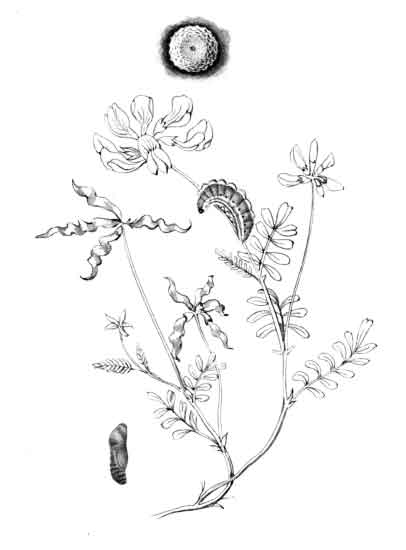
Pl. 108.
Chalkhill Blue.
Egg enlarged; caterpillar and chrysalis.
Although this butterfly (Plate 109) is, in England, fairly constant in the matter of colour, and, as regards the male especially, differences in tint are noticeable when series from various localities are ranged side by side. Silvery-blue perhaps best expresses the general colour of the male on the upper surface, sometimes very pale, and sometimes faintly tinged with greenish. The blackish border on the outer margin of the fore wings varies in width and in intensity; often there are indications of eyed spots on this margin, and occasionally these spots are quite distinct, although the whitish rings are not always clearly outlined. The black border on the outer margin of the hind wings is often narrow and external to a series of white-edged black spots, but sometimes it is broad and obscures the spots; orange markings rarely appear on this margin, but such aberrations have been taken on the Dorset coast. The fringes are white chequered with blackish on the fore wings, but with seeming continuation of the veins through those of the hind wings. The female is sooty-brown above, with a black discal spot on the fore wings, and sometimes on the hind wings also, and these spots may be ringed with blue or bluish-white; the outer marginal borders are hardly darker, and those on the fore wings are limited by a wavy pale line, which may be faintly or strongly marked with orange, but orange marking on these wings is rather the exception than the rule; on the outer margin of the hind wings there are some black spots, edged outwardly with white and inwardly with orange. The fringes are white chequered with brown, and those of the fore wings are tinged with brown. There are generally some blue scales at the base of the fore wings and over a larger portion of the basal area of the hind wings, but occasionally the whole discal area of the hind wings (Fig. 7, Plate 117), or of all [Pg 168]the wings, var. syngrapha (Fig. 8, Plate 117), is of the male colour. The former is from Eastbourne and the latter from Wiltshire. They are rather uncommon varieties, but intermediate forms are more often met with in the same localities as well as in other parts of England where the species occurs.
On the coast of Dorsetshire a very unusual form occurs. The border of the outer margin is white instead of the usual black or blackish; the inner limit of this border is, on the fore wings, defined by a dusky shade, and the black nervules break up the border into six spots; on the hind wings four or five of the white spots are centred with black dots. The female has a similar border, but on the hind wings it is inwardly edged with orange. It has been named var. fowleri, and I have seen one example of this form without black dots in the marginal white spots of the hind wings. On the under side variation is on somewhat similar lines to that adverted to in the last species. On Plate 109, Fig. 8 represents the typical under side of the male, and Fig. 7 that of the female. It will be noticed that the male is greyer than the female. Some of the ordinary aberrations are shown on the same plate, and some rarer ones will be found on Plate 118, and of these Fig. 12, if without the basal spot on the fore wings, would represent var. lucretia.
For figures of the early stages see Plate 108; that of the caterpillar is after Buckler. The egg is flat on the top, with a slightly darker pit in the centre (the micropyle); the sides are rounded, netted, and studded, and the colour whitish-green. The above short description was taken from one of a few eggs of this butterfly sent me in August last by Mr. Ovenden, and the same egg has been figured.
Mr. Frohawk has described the egg more fully in the Entomologist for 1900. With reference to the egg-laying of the butterfly he writes: "On August 13th, 1900, I watched several females in the act of depositing, on various stems of the usual stunted herbage to be found growing on chalk downs. [Pg 169]They frequently crawled among the plants for a distance of about a couple of feet, occasionally curving the abdomen downwards among the small plant-stems and grasses, and here and there depositing an egg. I therefore dug up portions of the turf, potted it, and placed a couple of females on each lot; they deposited ova on the 14th and 15th, on the stems of various plants; a few were laid upon the brown dead trefoil leaves, as well as on the living leaves; but the site generally chosen is the intermingled stems of both plants and grasses. Another female, placed upon a similar pot of plants, deposited about fifty ova on September 10th, nearly all being placed upon the stems, and a few upon the under side of the leaves of rock-rose; in all cases the eggs are deposited singly."
The caterpillars do not hatch out until the following spring. According to Buckler and Hellins, the only difference between the caterpillar of this butterfly and that of the next species, Adonis, is that the latter "has its ground colour deeper green, with the hairs or bristles black, while Corydon has the ground colour of a lighter, brighter green (a green with more yellow in its composition), and the hairs light brown."
The butterfly is common and often abundant in July and August, chiefly the latter month, on chalk downs in Oxfordshire, Buckinghamshire, Berkshire, Kent, Surrey, and Sussex; it is also found in the Newmarket district of Cambridgeshire and on one chalk hill in Norfolk, according to Barrett, who adds: "on the oolite as well as the chalk in Wilts, Dorset, Gloucestershire, and Somerset; and on limestone at Grange and Silverdale in North Lancashire, in Lincolnshire, Westmoreland, and Cumberland. It has also been taken in Essex, Hants, Cornwall, and in one locality in Glamorganshire."
Mr. Sydney Webb has stated that a dwarf form occurs pretty regularly in a valley about two miles east of Dover, but that it only appears to be found at odd times in other parts of England.
Abroad, the species is found in Central Europe, also in the Pyrenees, Aragonia, and the Balkan Peninsula.
The butterfly on Plate 110 is the Clifden Blue of Moses Harris (1775), so named because it was said to have been first observed at Clifden in Bucks. The male is of a beautiful bright blue colour, but as in the same sex of the previous two species, it is not quite constant in tint. In some specimens we find a distinct mauve shade, and in others, but more rarely, the blue colour is tinged with greenish (Plate 118, Fig. 11): the veins become distinctly black on the outer margins, and appear to run through the white fringes on all the wings. Often there are black dots on the outer margin of the hind wings. The female is dark brown, sometimes slaty-black, with orange spots or crescents on the outer margins; these are often only faintly in evidence on the fore wings, and sometimes this is the case on the hind wings also; there is a black discal spot on the fore wings, and the fringes of all the wings are white chequered with black. The bases of the wings are powdered with blue, but this is more noticeable on the hind wings. On the under side the fore wings of the male are greyish, and the hind wings greyish-brown; all the wings of the female are brownish, with a faint grey tinge in some specimens; the ornamentation is very similar to that of the Common Blue. The two figures on Plate 110, showing specimens with the wings closed, represent typical male and female, and the other figures of under sides on this plate exhibit minor aberrations from typical lines; examples of the more extreme variations will be found on Plate 118, where also are figured some uncommon aberrations in the colour of the male on the upper side.
There is often a tendency in the female to assume the colour of the male, and this is usually seen on the hind wings, but occasionally on the fore wings also. In the extreme form of this phase of variation, var. ceronus, the whole of the upper surface, [Pg 171]with the exception of the orange-spotted borders, is almost as blue as that of the male. This is a parallel aberration to that of the Chalk Hill Blue known as syngrapha, but it seems to be somewhat rarer in this country.
Figures of the early stages will be found on Plate 111.
The egg is greenish-white, becoming rather greener in tint towards the top, which is depressed; the netting is whitish and shining, and somewhat rougher on the sides than towards and on the top.
Buckler describes the full-grown caterpillar as deep, full green in colour, covered with tiny black speckles, bearing little black bristles, which are longest on the dorsal humps and on the yellow-edged ridge above the spiracles; on the top of each of the eight pairs of dorsal humps is a deep bright yellow longitudinal dash, somewhat wider behind than in front; these dashes form in effect two yellow stripes interrupted by the deeply sunk segmental divisions; the line along the back is darker than the ground colour, and the spiracles are black. The head is dark brown, and there are two yellow dots on the first ring of the body near the head.
The chrysalis, when first formed, is greenish-brown with the wing-cases greenish, the whole afterwards becomes ochreous; the thorax and wing-cases are rather glossy, and the body is slightly hairy. Buckler states that some of his caterpillars buried themselves about half an inch deep in the loose soil, and formed a weak sort of cocoon; others, not having been supplied with soil that could be so easily penetrated, retired under the stems of their food-plants, and in angles formed by the branching stems spun a few weak threads to keep themselves in place.
The food-plant is the horseshoe vetch (Hippocrepis comosa). From eggs laid in August, the caterpillars appear to hatch towards the end of September, but do not feed up until the spring. Butterflies from these caterpillars are on the wing [Pg 172]between the middle of May and the middle of June, thus occupying about nine months in passing through the various stages from egg to perfect insect. From eggs laid in May and June the butterflies appear in August and September. Although it is found in similar kinds of situations to those affected by the last species, and sometimes on the same grounds, it is more local, and almost confined to the counties of Kent, Surrey, and Sussex. It is, however, rather common at Ventnor and in some other parts of the Isle of Wight, and is found near Winchester. Barrett states that it is abundant at Corfe Castle, Dorset, and gives as localities for the butterfly Wotton-under-Edge, and near Bristol, near Torquay, Sidmouth, and Seaton. Its range abroad extends through Central and Southern Europe, to Armenia, Northern Asia Minor, and Western Kurdistan. It is also found in North-West Africa, where the males are greenish-blue with conspicuous black spots on the outer margins of the hind wings; this is the var. punctifera.
About the beginning of the eighteenth century this butterfly (Plate 113) was known as the "Blue Speckt," but Harris, in 1775, changed the name to the "Azure Blue." The male is a pretty lilac-tinged blue, with a narrow black edging on the outer margin of the fore wings, often only in evidence towards the tip, and a narrow black line on the outer margin of the hind wings. The white fringes of the fore wings are distinctly marked with black at the ends of the veins. The female is of the same shade of blue, or sometimes much paler (var. clara, Tutt), with a broad blackish border on the outer margin of the fore wings extending along the front margin to about the middle; this border varies in width and seems to be wider in summer specimens than in those of the earlier flight; the discal mark on the fore wings is black, but this is sometimes very [Pg 173]faint; there is a series of black dots on the outer margin of the wings.
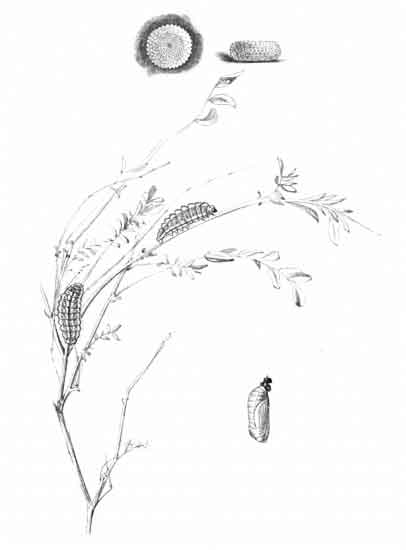
Pl. 111
Adonis Blue.
Eggs, natural size and enlarged; caterpillars and chrysalis.
Although the colour of the upper side is somewhat like that of the Common Blue, it should not be confused with that species, as the under side is very different both as regards the colour, which is bluish-white, and the arrangement of the black spots. On the outer margins of the wings in some specimens there are more or less distinct traces of blackish crescents.
There is no considerable variation in this species, but the spots on the under side are subject to slight modification in the matters of size and shape; the borders also vary in width, and in the female the blue area is thus sometimes much restricted. A gynandrous specimen has been recorded, in which the right side is male.
The egg (Plate 112) is described as whitish or bluish-green in colour.
The full-grown caterpillar has a blackish head, the body is bright yellowish-green with paler lines; eight rings from and including the second are crested with two ridges of humps, between which lies the sunk dorsal space; the whole skin of the body is velvety, with its surface thickly covered with yellowish warty granules, each bearing a minute bristly white hair. Sometimes the humps and the middle of the back are marked with rose-pink.
The chrysalis is pale brownish-ochreous with a thin blackish-brown line on the back of the brown freckled thorax; the body is marked with rather blotchy arrow-head dashes, and some larger dark brown blotches; the wing-cases are pale greyish freckled and outlined with brown, their surface is smooth and rather more glistening than the other parts, which are thickly studded with fine, short, brownish bristles. (Adapted from Buckler.)
The following is a brief summary of a paper by Mr. R. Adkin [Pg 174](Proc. S. Lond. Ent. and Nat. Hist. Soc. for 1896), in which he gives a most interesting account of the earlier stages of the second brood of this species.
At the time when the butterflies of the second brood are on the wing, the flower-buds of the ivy (Hedera helix) are still young, and form compact heads. The butterfly, having selected one of these heads, settles upon its top, closes her wings over her back, and bending her abdomen down and round underneath the buds, affixes an egg to the under side of one of the slender single bud-stalks. In about a week the eggs hatch. The young larva which in colour matches the buds very closely, rests on the bud-stalk with its anterior segments, which completely cover its head, pressed closely against the bud, and looks so exactly like a slight swelling of the upper part of the stalk as to make detection a matter of great difficulty, even with the aid of a fairly powerful lens. The larva is very sluggish in its habits, seldom leaving the head of the buds on which it is hatched, so long as sufficient food remains for its nourishment, or occasionally when about to change its skin. It appears to feed only at night, and its manner of feeding, which is the same throughout its life, is to eat a round hole through the outer shell of a bud, and pressing its head forward through it to clear out the soft inside of the bud. In from four to six weeks it is full-fed; it then quits the buds, and attaches itself by slender threads to a leaf, and in a few days becomes a pupa, in which state it passes the winter.
Normally the eggs of the spring butterflies are laid on the under side of the calyces of flower-buds of holly (Ilex). The caterpillars feed on the flower-buds and also on the young green berries. They are full grown in about a month, change to chrysalids, and the butterflies emerge in July and August. Among other pabula that have been mentioned are the flowers of dogwood (Cornus sanguinea), berry-bearing alder (Rhamnus frangula), and spindle (Euonymus europæus).
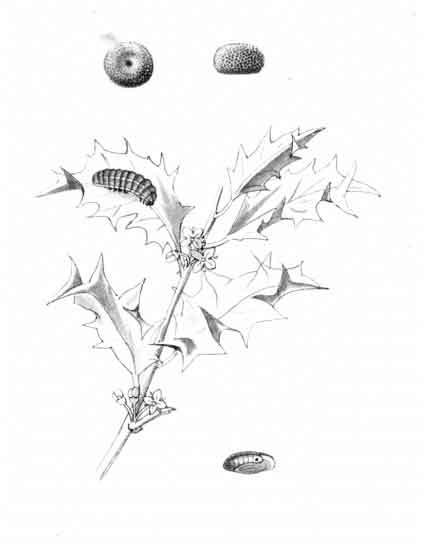
Pl. 112.
Holly Blue.
Eggs enlarged; caterpillar and chrysalis.
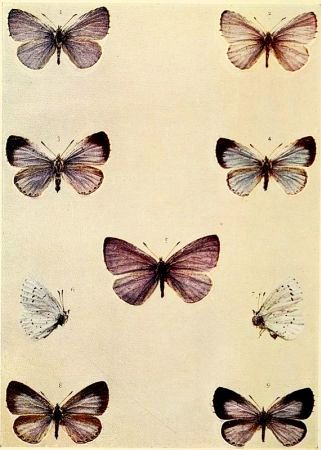
Pl. 113.
Holly Blue.
1, 2, 6 male: 3, 4, 7 female (spring); 5 male; 8, 9 female (summer).
In confinement the caterpillars will eat young leaves of holly and probably of ivy also, but where flower-buds are available they prefer them and ignore the tender leaves.
The Rev. Gilbert Raynor, on May 18, 1901, observed a female deposit an egg on an unopened flower-bud of rhododendron in his garden; and he also mentions that he beat a number of the caterpillars of all sizes from holly during the first week of July in the same year.
Mr. Dennis reported that on October 9, 1902, all stages of the species were to be found at Earl's Colne, Essex.
Butterflies of the first flight are usually to be seen in April and May, and of the second, which is perhaps only partial and may not be represented at all, in July and August. Specimens have been observed as early as the last week of March, and, as adverted to above, as late as October. For a few years in succession the species may become increasingly numerous, and then suddenly become quite scarce for a year or two. Most probably this is the result of favourable or unfavourable weather conditions.
The taller hollies, where these grow in gardens, open woody places, on hillsides, or even in hedgerows, are frequented by these butterflies in the spring; and the ivy-clad walls, etc., are their haunts in the summer.
The species is widely distributed, and often common, over the whole of the south of England and Wales. North of the Midlands, as well as in Ireland, it is more local, and occurs, I believe, only in the first brood. Possibly in the South of Ireland there may be a second brood. Barrett states that there is no reliable record for Scotland.
Abroad, its range extends throughout Europe and Northern Asia, except the Polar Regions, to China and Japan. It also occurs in North Africa.
The butterfly on Plate 115 is sometimes referred to as the "Bedford Blue" and also as the "Little Blue."
Both sexes are blackish, or sooty-brown; the male is powdered, more or less, with silvery-blue scales. The under side is greyish-white with a tinge of blue at the base of each wing, but chiefly on the hind pair; the spots are black encircled with white. As will be seen on turning to the plate, there is variation in size. Fig. 5 represents a giant race occurring in some localities, and the particular specimen depicted was taken, with many others, on the coast near Lymington, Hants; it seems to be referable to var. alsoides, Gerhard. Variation on the under side is usually in the direction of complete absence of spots, but Mr. Joy has recorded a specimen with the spots on the hind wings extended into streaks of considerable but varying length.
Figures of the early stages will be found on Plate 114.
The egg is pale greenish in colour, netted with whitish; it is laid in June on the calyx of a flower-bud, generally low down, of the kidney-vetch (Anthyllis vulneraria).
According to Buckler, caterpillars hatched on June 21 from eggs laid between the 16th and 18th of that month, and at once commenced to feed on the flowers of the kidney-vetch, and made their way to the seed, for which they evinced a marked preference. When full grown, the caterpillar is brownish, sometimes tinged with pink. The fine bristles are dark brown; there is a darker line along the middle of the back, and a line of dark marks on each side. The head is black and shining.
The chrysalis is described by Buckler as "dirty whitish-grey, approaching to drab, palest on the back of the abdomen, greyish on the head and thorax, both of which are marked with a black dorsal stripe, which is a little interrupted; on either [Pg 177]side is a subdorsal row of short slanting black dashes. The pale ground colour is sprinkled with some very minute black specks. The head, thorax, and abdomen are hairy with bristly whitish hairs." Although the caterpillars feed up rather quickly and are full grown and apparently ready to assume the chrysalis state, they do not effect the change until the following May or June.
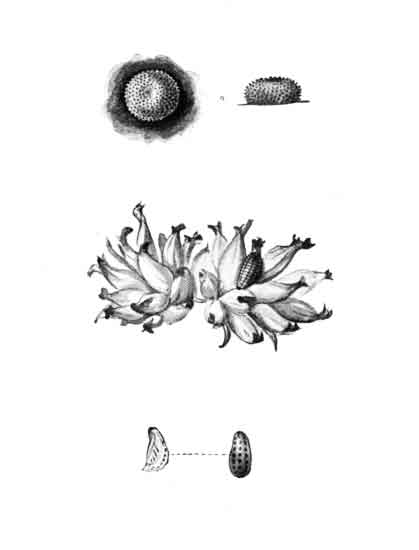
Pl. 114.
Small Blue.
Eggs, natural size and enlarged; caterpillar and chrysalids.

Pl. 115.
Small Blue. 1 male; 2, 3 female; 4, 5, 6, 7, 8 male vars.
Mazarine Blue. 9, 11 male; 10, 12 female.
The butterfly emerges in about three weeks, so it will be seen that this species continues the caterpillar existence for something over ten months.
On the Continent there are two broods of the butterfly, and in England there appears to be a partial second flight in some years, as, for instance, in 1901, when captures in August were reported from Herts, Kent, Surrey, and Wilts. Its haunts are warm and sunny grassy hollows and slopes, and it is often common in such places on the chalk hills in the south, from the end of May to the end of June. According to Barrett it is scarce in the Eastern Counties; widely distributed but local in the Midland and Western Counties, even to Devon, and in Wales, where chalk or limestone is found; also in extremely restricted localities in Yorkshire, Lancashire, Cumberland, and Durham, and in various places in Scotland, extending as far north as Aberdeen. In Ireland it is much more plentiful, especially on the limestone of the west and on the coast hills near Belfast, and even frequents the sand-hills of the Dublin coast.
It is widely spread over Europe, except the Polar parts, and, apparently, the south of Portugal and Spain; its range extends eastward to Amurland, Mongolia, and China.
The male is dull purplish-blue, narrowly bordered with blackish on the outer margin; the female is dark brown. On the underside both sexes are pale greyish-brown, with a bluish [Pg 178]tinge at the base; there is a black discal spot and a series of black spots beyond, all ringed with white.
The egg is described as being white in colour and small, and round in shape.
The caterpillar is of a dingy yellowish-green, with darker lines on the back and sides; there are fine hairs on the body, and the head and spiracles are dark brown (Rühl).
It feeds in July and August on the flowers and seeds of thrift (Armeria vulgaris), kidney-vetch (Anthyllis vulneraria), and melilot (Melilotus officinalis).
The chrysalis is rather oval in shape, pale olive-green in colour when first formed, in September, but olive-brown later; it is attached by the tail to a stalk of the food-plant and has a silken girdle (Rühl).
This butterfly (Plate 115) is the cymon of Lewin, who, writing in 1795, considered it very rare. In 1828 Stephens refers to it as scarce and local, "found in chalky districts in Norfolk, Cambridge, Yorkshire, and Dorsetshire; also near Brockenhurst and Amesbury, Hants; and on Windlesham Heath, Surrey, towards the end of May and of July." Newman (1871) adds Warwickshire, Herefordshire, Gloucestershire, Monmouthshire, Glamorganshire, Somersetshire, and Lincolnshire. Curtis gives Leicestershire and Worcestershire. It seems to have been fairly common, and even plentiful in some years around Glanville's Wotton, Dorset, but has not been seen in that district since 1841; at Wotton-under-Edge, Gloucester, it was not uncommon up to 1858; as late as 1864 it occurred at Epworth, North Lincolnshire. Probably the latest captures in Britain were the specimens taken in Glamorganshire in the years 1874-77. Tutt mentions that the butterfly was taken near Cuxton in Kent, some thirty-five years ago, but it has not since been seen in that locality.
Occurs in May and June and again in July and August over the greater part of Europe; its range extends to Asia Minor, and eastward to Siberia, Mongolia, and Amurland.
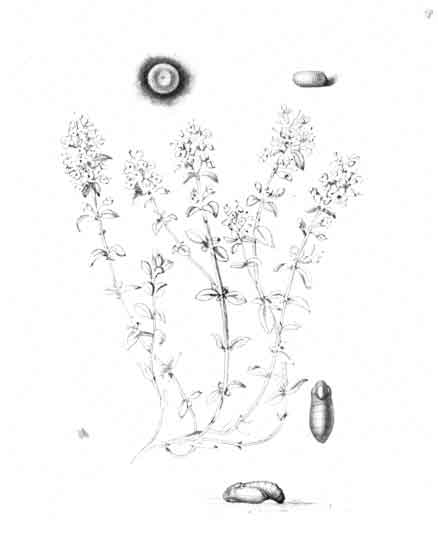
Pl. 116.
Large Blue.
Egg, natural size and enlarged; chrysalis.
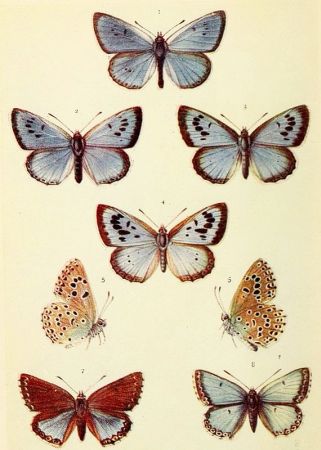
Pl. 117.
Large Blue. 1, 5 male; 2, 3, 4, 6 female.
Chalkhill Blue vars. 7 female; 8 do. var. syngrapha.
The butterfly on Plate 117, Figs. 1-6, is the largest "Blue" found in this country. All the wings on the upper side are deep blue, and their outer margins are bordered with blackish; the discal spot, and a row of spots beyond, are black; the hind wings have a row of black dots on the outer margin, and sometimes, and especially in the female, there is a series of black dots just beyond the central area; the fringes are white. The under side is greyish tinged with blue towards the base of each wing, but covering nearly the whole of the basal third of the hind pair; the spots are black ringed or edged with white; on the fore wings there are two in the discal cell and a row of six beyond; on the hind wings there are four or five before the discal spot, and a series of seven beyond; all the wings have a double marginal series, and some black dots at the ends of the nervules. Sometimes the wings have a purplish tinge, and this is more usually so in Gloucestershire specimens. The chief variation is in the number and the size of the spots; these are occasionally only faintly in evidence, but more rarely perhaps those beyond the discal spot on the fore wings are of large size and bar or wedge-like in shape; the smaller cell-spot is often absent. A dwarf form is stated to occur at times in all localities.
The complete life-history of this species has yet to be ascertained; no one seems to be acquainted with the caterpillar after hibernation. Pretty much all that is known of the early stages has been worked out by Mr. Frohawk, who has published some very interesting accounts of his observations in the Entomologist for 1899 and 1903, and from these the following details have been obtained.
The egg (Plate 116) is bluish-white in colour, and is laid singly among the buds of wild thyme (Thymus serpyllum).
Caterpillars hatched on July 10 from eggs received the [Pg 180]previous day; they were placed upon thyme blossoms and soon commenced to feed, one being observed to eat its way into the base of the calyx so that the forepart of the caterpillar was hidden. In its colouring and downy covering the caterpillar so closely resembles the flower-buds of the thyme that it is very difficult to detect. After the third moult (July 26) the colour is a uniform, dull, ochreous-pink; there are four rows of long curved hairs, each row composed of a single hair on each ring from the fourth to the ninth inclusive; the first three rings have each a set of three subdorsal hairs, those on the first ring curving forwards; the bases of the hairs resemble glass-like pedestals with fluted sides. The head is ochreous with dark brown markings in front. The caterpillar at this stage develops an aversion to thyme or any other plant offered to it, and seems to be anxious to hide itself in the ground.
The chrysalis, which is figured on Plate 116 (after Frohawk), is ochreous when first formed, but becomes darker gradually; the wing-cases, however, remain of the original colour, but their hind margins darken. From a chrysalis found on July 12 the butterfly emerged on July 16.
There is some evidence in favour of the supposition that this caterpillar is in some way dependent upon ants for nourishment after the third moult, if not before, but what the exact requirement may be is not known. Probably the circumstances connected with the discovery of the chrysalis in 1905 by Messrs. Frohawk & Rayward may afford a valuable clue to the direction in which their future investigation will have to be conducted. We may hope, therefore, that the mystery that has so long hung over the last stages of the caterpillar will be solved before very long.
Lewin (1795) and Donovan (1796) both refer to this as a rare English butterfly. The former states that it is on the wing in July, and is found on high chalky lands in different parts of the kingdom, having been taken on the cliffs in the [Pg 181]neighbourhood of Dover, Marlborough Downs, the hills near Bath, and near Clifden in Bucks.
Stephens, in 1828, wrote of it as "an insect of great rarity." He mentioned the localities given by the older authors, and added that it had been taken in the Mouse's Pasture, near Bedford, in rocky situations in North Wales, and had been plentiful near Winchester.
Newman (1871) wrote, "Its 'metropolis,' if I may borrow an expression from the revered fathers of British entomology, is in South Devon; it has occurred in some abundance in Somersetshire, and on the Cotswold Hills in Gloucestershire; from Gloucestershire we ascend to a Midland county, Northamptonshire, in which county (at Barnwell Wold) a considerable number have been taken." One specimen was reported from Charmouth in Dorsetshire, and the butterfly has also been recorded from Herefordshire, but these are matters of ancient history. At the present time the species is only to be found in limited numbers in the Cotswolds; it seems to have become much rarer than formerly in its South Devon locality, i.e. Bolthead, near Plymouth; one never hears of it now from Clovelly, in North Devon, where, according to Dale, it was once reported to be abundant. In 1891 Messrs. Waterhouse obtained a fine series of specimens in West Cornwall, and since that time the district has been annually visited by an increasing number of entomologists. Judging from the "big bags" that are made each year it would seem that the butterfly has a very strong and widely distributed settlement in those parts.
Abroad it is distributed throughout Europe, except the Polar and the south-western parts, and is also found in Armenia, Bithynia, and South Siberia.
Our next species belongs to the Nemeobiinæ, a sub-family of Lemoniidæ = Erycinidæ. Only one member of the family is known to occur in Europe; this is Nemeobius lucina.
As the fore legs of the male butterfly are aborted, and are therefore useless for walking, the species would seem to come near the Nymphalidæ, in which the fore legs of the butterflies, in both sexes, are reduced. In its early stages, however, the species seems to be most nearly related to the Lycænidæ.
This butterfly is figured on Plate 120. The male is black, with three transverse tawny bands on the fore wings; these are crossed by the black veins, and so form series of irregular spots. Those on the outer margin have black centres; on the hind wings there are three or four tawny spots on the disc, and a series of black centred tawny spots on the outer area. The female is similar to the male, but the tawny markings are wider, so that the fore wings appear to be of this colour, with a black patch at the base, two black irregular lines, and a series of black spots on the outer margin. On the under side of the hind wings there are two transverse series of whitish spots, and a series of black spots on the outer margin. The wings of this sex are always broader than those of the male, and the apex of the fore wings is not so distinctly pointed. Variation is not usually of a very pronounced character, and in a general way it consists mainly in a greater or lesser amount of black in the male, and this more particularly on the hind wings, and an increase in the tawny colour in the female; in the latter sex, outer marginal black spots are sometimes absent from all the wings. Barrett mentions two extreme aberrations. In one, a female, the usually dark spaces, bands, and veins are of an exceedingly pale brown, suffused with fulvous, so as to be comparatively indistinct; another example, a male, has the basal area of the fore wings pale, and the first transverse dark band absent.

Pl. 118.
1, 3 Common Blue vars., male; 6 do. female.
2, 5, 8, 11 Adonis Blue vars., male; 4, 7, do. female.
9, 10 Chalkhill Blue vars., female; 12 do. male.
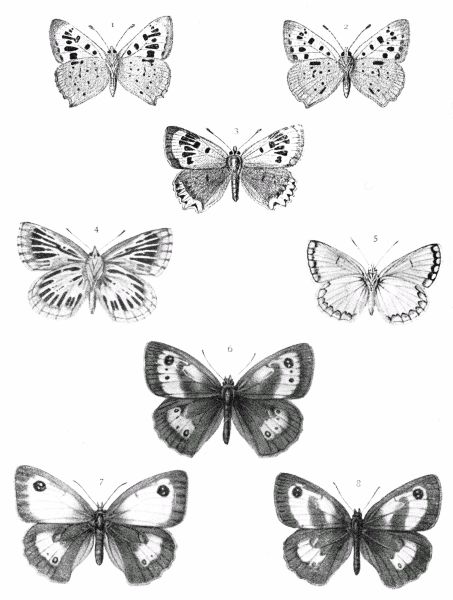
Pl. 119.
1, 2, 3 Small Copper vars.; 4 Adonis Blue var.
5 Common Blue var.; 6, 7, 8 Gatekeeper vars.
The eggs of this species are to be found at the end of May [Pg 183]on the under sides of the leaves of the cowslip (Primula veris), sometimes as many as ten on one leaf, but as a rule there will only be one or two on a plant. When laid, the egg is very glassy in appearance, but it gradually turns to a pinkish-grey; and when the caterpillar is formed inside, the shell becomes transparent, and its occupant can be clearly seen. It eats a considerable portion of the shell in making its exit therefrom, and afterwards consumes the remainder of the shell. When in its last skin the caterpillar is brown, covered with short whitish hair, among which are some longer dark brown or blackish hairs; the lines on the back and sides are blackish, and there are black dots on the front part of each segment or ring. Head, honey brown, notched on the crown; eyes and jaws, brownish. It feeds from June to August on cowslip, but will also eat primrose (Primula vulgaris), and hides among dead and withered leaves beneath the food-plant (Plate 121).
The chrysalis is pale whity-brown, hairy above, with black dots; head and the upper edge of the wing-cases streaked with black.
Occasionally a few butterflies emerge in August, but they usually remain in the chrysalis until May or June.
This is a woodland species, and prefers the sunny but sheltered nooks and glades, but also resorts to the broader rides and pathways. Flowers do not seem to have any strong attraction for it, but it may often be seen sitting on the foliage of a bush or sapling tree. It appears to be pretty widely distributed, although to a certain extent local, throughout the southern half of England, but seems to have almost or quite disappeared from the counties of Cambridgeshire, Suffolk, and Essex. Dumfries is the only locality in Scotland from which it has been reported.
Its distribution abroad is limited to Central Europe, Denmark, Livonia, Southern Sweden, Central Spain, North Italy, and the Balkans.
Now follow the Skippers (Hesperiidæ), of which kind of butterfly we have eight species in England. Of these the first two belong to the Hesperiinæ and the others to the Pamphilinæ.
The wings of the butterfly figured on Plate 122 are blackish, ornamented with numerous white spots, which are more or less square in shape, on the fore wings. The fringes are chequered black and white.
The male differs from the female in having the front edge of the fore wings folded towards the base, and these wings have scattered greyish scales on the basal area; the central series of spots on the hind wings are also more in evidence, and not infrequently unite and become band-like. Variation consists in modification of the markings, chiefly in a tendency of the spots to run together, culminating in var. taras, Bergstr., in which the white spots of the fore wings are confluent and form a large blotch. This variety was figured by Petiver in 1717, but was not named by Bergsträsser until 1780. Haworth described it as lavateræ, and Newman figured it under the same name.
On a small plant of Alpine strawberry, sent by the Rev. Gilbert Raynor, were three eggs of this butterfly. These were pale green in colour, ribbed, and delicately netted with cross-lines. On June 26, three caterpillars were noticed on the upper side of the leaves, each on a separate leaf, and under cover of a few coarse silken threads. They were pale steely-grey, with black heads, and plates on the first and last segments of the body.
As the supply of strawberry foliage was failing, the caterpillars were given bramble on July 21, and the next day each was found enclosed in a sort of envelope formed of a bramble leaf. They were then seemingly in their last skin, whitish-green in colour, and covered with short whitish hair; [Pg 185]a whitish edged dark olive-brown line along the back, and similar lines on the sides; between the rings the colour was pale ochreous. The date of pupation was not noted, but on September 9, one of the spun-together bramble leaves was opened, and a chrysalis found within. This was pale brown, with dark brown or blackish marks along the back and sides; the head and back were covered with dense pale reddish-brown bristles; the wing, leg, and antennæ cases were greenish, smooth, and shaded with brownish. Between the head and first ring of the body above there was a deep furrow, with a black-centred white spot on each side of it (Plate 123).
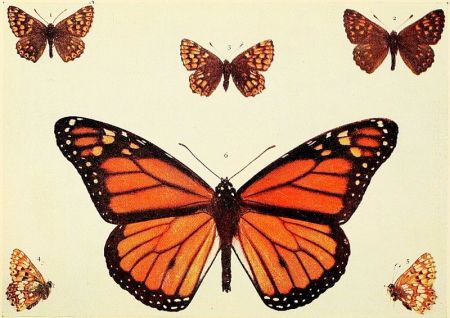
Pl. 120.
Duke of Burgundy Fritillary. 1, 2, 4 male; 3, 5 female.
Milkweed Butterfly. 6 male.
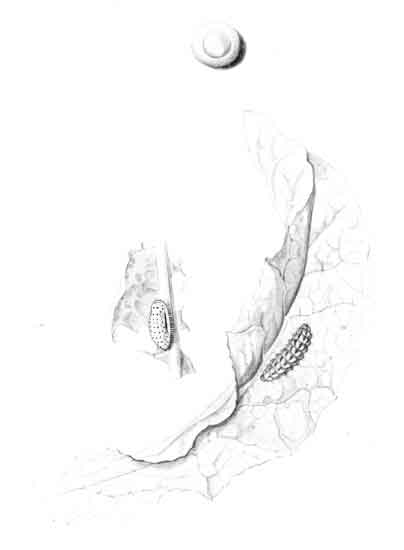
Pl. 121.
Duke of Burgundy Fritillary.
Egg enlarged; caterpillar and chrysalis.
Besides the plants adverted to above, the caterpillars will eat raspberry (Rubus idæus) and cinquefoil (Potentilla fragariastrum and P. reptans).
The butterfly is pretty generally distributed in Great Britain, but does not seem to be common in Ireland, as Kane only mentions two examples, from Killarney. It is found in May and June on chalk downs and other hillsides, especially in the hollows and sheltered nooks, also in and around woods, and in rough fields. On dull days and at night it may be found sitting, with the wings erect over the back, on various seed-heads, etc.
The species is double brooded on the Continent, and occasionally a few butterflies will appear in August, but such emergences depend on a combination of favourable circumstances. In very forward seasons it has been seen on the wing during the last week in April.
Its range extends over Europe and into Northern Asia.
As Barrett refers to the capture in Norfolk (May or June, 1860) of several specimens of the Central and South European species, H. alveus, Hüb., it maybe well to mention it here, if only for the purpose of quoting his remarks thereon. After detailing the facts connected with the occurrence, he states, "It seems undesirable now to introduce the species to a place [Pg 186]in the British list, but rather to record the captures in question as specimens accidentally introduced with plants, or else the result of a very exceptional act of migration."
The wings are fuscous, with darker fuscous transverse bands on the middle third of the fore wings; the space between these is sometimes, and in both sexes, whitish; there are some whitish spots on the outer band, usually towards the costa, but occasionally on the middle also, and a series of white points on the outer margin of all the wings. The hind wings have a whitish discal dot and a band beyond the middle, which is almost parallel with the outer margin. The male has a well-marked fold on the costa (Plate 122).
The egg is whitish-green when freshly laid; it afterwards changes in colour to orange. The caterpillar is yellowish-green with a darker line along the back and a paler line on each side; the spiracles are red and edged with whitish. The head is pale brown, striped and marked with purplish-black. The body, together with the head, is covered with a short whitish pile. It feeds on bird's-foot trefoil (Lotus corniculatus) from June until August, when it hibernates. I have not seen the chrysalis, but it has been described as dark green with the body tinged with rosy red.
The butterfly is on the wing in May and June; in some seasons it has been seen as early as the end of April. Very occasionally, perhaps, there is a partial second flight in August. It has been reported as plentiful at Lyme Regis in August.
I took one or two specimens about the middle of August, 1903, in the New Forest district, and in the same month of 1905 one of two caterpillars sent to me by Dr. Chapman pupated in August, and the butterfly emerged some time in the autumn, as I found it dead in the box early in October. Both the [Pg 187]caterpillars had spun together sprays of the food-plant as shown in the figure, Plate 123. One was removed for its portrait to be taken, and it was supposed that the other bundle contained a caterpillar also, and was not examined.
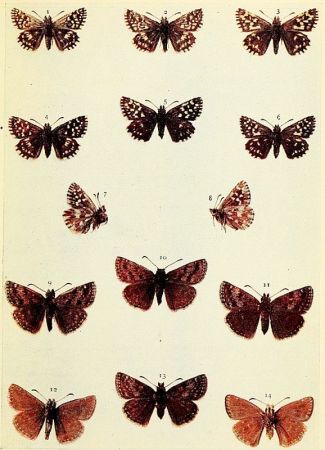
Pl. 122.
Grizzled Skipper. 1, 2, 7 male; 4, 5, 8 female; 3 var. male; 6 do. female.
Dingy Skipper. 9, 10, 12 male; 11, 13, 14 female.
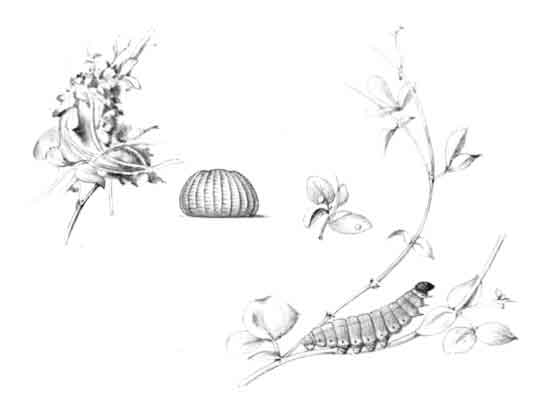
Dingy Skipper.
Eggs, natural size and enlarged; caterpillar and its shelter.
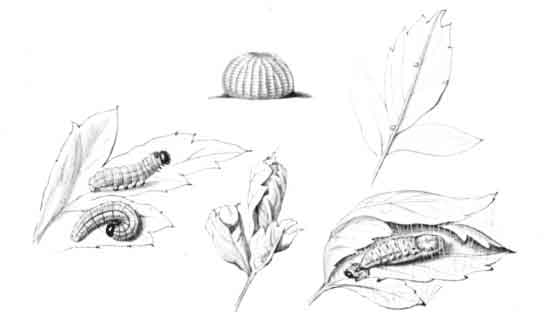
Pl. 123.
Grizzled Skipper.
Eggs, natural size and enlarged; caterpillar and shelter; chrysalis in cocoon.
The butterfly affects open places in, or the edges of, woods in chalky districts, also the slopes of chalk downs and other hillsides, as well as railway banks and even rough fields. It evidently delights in sunshine, and may often be seen basking on a stone or the bare earth. When at rest at night or on dull days it sits on a dead seed-head or grass glume, with the wings closed down over its back like a noctuid moth, and is then difficult to detect until the eye becomes accustomed to its appearance. It is widely distributed in Great Britain, but it is more at home on chalk and limestone than elsewhere. In such localities as the fens of Norfolk and Cambridge it is scarce, and seems to have a rather limited distribution in Ireland, in which country Galway is its headquarters, according to Kane.
Abroad, it is found throughout Europe, and its range extends to Western Asia.
All the wings are brownish-orange, with the veins darker and becoming black towards the outer margins, especially on the fore wings. The male has a black sexual mark (Plate 125).
Except that the colour varies in the direction of a pale golden tint there is little in the way of aberration in this butterfly. At least one gynandrous specimen has been recorded.
The following descriptions of the early stages (Plate 124), as well as the figures of the caterpillar and the chrysalis, are from Buckler's "Larvæ of British Butterflies":—
The egg "is of a long oval figure, half as long again as wide, the shell glistening, devoid of ribs or reticulation; at first white, then turning dull yellowish, and at last paler again, with the [Pg 188]dark head of the caterpillar showing through. The young caterpillar eats part of the empty egg-shell."
The full-grown caterpillar is of a delicate light green, the stripe along the back is rather bluish-green, with paler green central and side lines; the spiracles are flesh-coloured, and below these there is a somewhat creamy-white stripe. The head is deeper green than the body, and roughened with minute points. It feeds in June on Holcus lanatus, Brachypodium sylvaticum, and probably other kinds of soft grasses, and its assimilation, both in colour and texture, with the blades of grass is remarkable. Before changing to the chrysalis it encloses itself within two or sometimes three leaves of the grass, joined together longitudinally by lacing or spinning with white silk, the edges more or less close to each other, and becomes completely hidden.
The chrysalis is secured in the silken chamber, head upward, by an oblique cincture behind the thorax, and the anal tip fastened by a fan-like spread of fine hooks at the extremity fixed in the silk. The colour is similar to that of the caterpillar, and the lines are fairly in evidence. Caterpillars that spun up on June 18 to 23 produced butterflies on July 15 and 16.
Hellins states that eggs were laid in a row in a folded blade of grass about July 29, and that the caterpillars hatched out on August 12.
According to Hawes, the caterpillar of this species does not hatch from the egg until the following spring.
Although it does not seem to be very plentiful in fenlands, this butterfly certainly has a partiality for damp places, whether in the rides, or on the sides of woods, on hill slopes, or waste ground. Wherever there is a fairly large growth of the taller soft grasses that the caterpillars feed upon, there the butterfly may be found in July and August throughout the greater part of England and Wales. Reported from the Edinburgh district in Scotland; and in Ireland from Powerscourt and near Cork.
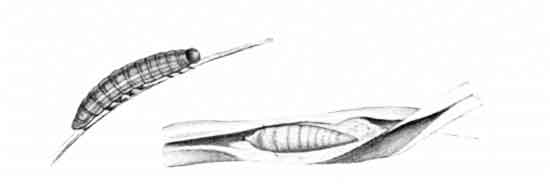
Small Skipper.
Caterpillar and chrysalis.
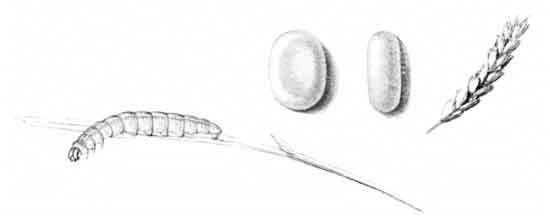
Essex Skipper.
Eggs, natural size and enlarged; caterpillar.
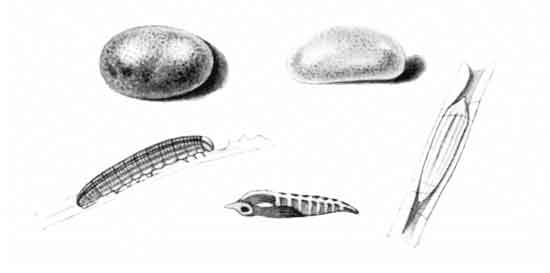
Pl. 124.
Lulworth Skipper.
Eggs enlarged; caterpillar and chrysalis.
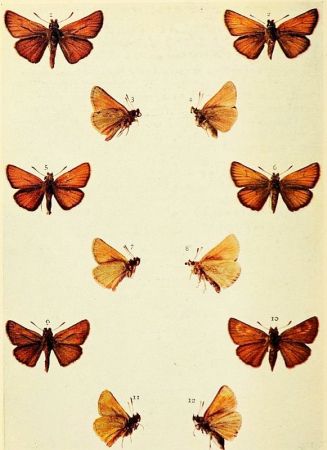
Pl. 125.
Small Skipper. 1, 3 male; 2, 4 female.
Essex Skipper. 5, 7 male; 6, 8 female.
Lulworth Skipper. 9, 11 male; 10, 12 female.
This butterfly is very like the Small Skipper, but may be separated from it, in both sexes, by the black under sides of the knobs of the antennæ. The black sexual mark in the male is finer, shorter, and much less oblique (Plate 125).
The egg (Plate 124) is pale greenish-yellow, oval in shape, flattened above and below; the top is slightly depressed. The eggs are deposited in July or August, in dried grass seed-heads and inside the sheath of a leaf, and the caterpillars, according to Hawes, do not hatch until April.
The caterpillar is green, with the incisions between the rings yellowish; there is a darker green stripe on the back, and the lines on the sides are yellow. The head is pale brown and striped with darker brown. It feeds from April to June on coarse grasses, such as Triticum repens. When full grown "it spins together the stems of the grass low down, with a network of white silk for pupation" (Hawes). The chrysalis is described as being long, yellowish-green in colour, and retaining the dark dorsal stripe seen in the caterpillar.
No doubt this butterfly has been with us all the time, but it appears to have escaped detection until the year 1888, when Mr. Hawes, in July of that year, met with it in Essex. He, however, did not then consider the three specimens that he had taken with A. thaumas anything more than queer varieties of that species, and it was not until January, 1890, that the fact of A. lineola being British was published. Since that time this Skipper has been found in a great many parts of Essex, but chiefly along the coast, and in such localities as Benfleet, Canvey, Dovercourt, Shoeburyness, Southend, etc. At Hadleigh it is often very abundant. Other localities are Sheerness, Cliffe, and Gravesend, in Kent. It has also been reported from near Sudbury, and from Harwich, and Chappel [Pg 190]in Suffolk; from Ashton Wold in Northamptonshire. In 1898 five specimens, identified by the Rev. Gilbert Raynor, were taken near Bedford. Barrett, who mentions Wicken Fen and Burwell among other localities, says that it has a "partiality for the embankments which protect the cultivated land from the inroad of the high tides which flood the salt marshes. Here it flits about, or sits on the coarse seaside grasses or on blossoms of thistle, or Lotus corniculatus, indicating rather sluggish habits, yet flying swiftly when disturbed. Further inland it seems to frequent chalky hillsides and marshes." It is on the wing in July and August.
The species is found in all parts of the Palæarctic Region except the most northern and the Canary Isles.
Compared with the other two species on Plate 125, the coloration of this butterfly is somewhat dingy; it is, however, enlivened, especially in the female, by a short dash and a curved series of orange spots in the upper half of the fore wings. The male has a black sexual mark which is very similar to that of the Small Skipper. There seems to be very little to note in variation, except that the orange markings referred to are subject to modification, and in the male may be altogether absent. An example taken at Swanage, in 1903, had the wings on the left side male, and those on the right side female.
The egg, figured, from a photograph, on Plate 124, is whitish, faintly tinged with yellowish.
The mature caterpillar is pale greyish, or yellowish, green, with the dorsal vessel darker, and edged with a slender pale yellow line on either side, and enclosing a pale longitudinal line along its middle. A narrow yellowish line runs above on the side and a broader one below. The two dorsal lines are [Pg 191]prolonged as far as the middle of the head, and run to the end of the flat anal shield, which is narrowly edged with pale yellow. The head is greenish with two yellowish lines. The two snow-white patches on the under side of the ninth and tenth rings of the body are conspicuous as in lineola, sylvanus, and comma. This white substance is spread out at the tail end of the caterpillar of actæon, when it has formed its chrysalis case (Zeller).
Buckler, referring to four caterpillars found on Brachypodium sylvaticum, June 11, states that they completed their growth on a diet of Triticum repens. They ate out wedge-shaped portions from the sides of the grass blades, and when they had finished their repast, they crawled down to the middle of the blade, and there spun a coating of white silk from one side to the other, causing the two edges of the blade to draw together a little, and then in the silk-lined hollow they rested until hunger obliged them to ascend the blade again for another meal. About June 23 they had ceased to feed, and were beginning to fasten themselves within more closely constructed retreats, formed where two blades of grass obliquely crossed each other. The colour of the chrysalis is similar to that of the caterpillar, and the lines are faintly traceable. The butterflies appeared July 14 to 18, emerging at night, and ready for flight in the morning.
This insect received its English name in 1832, when it was first discovered in this country at Lulworth Cove, in Dorsetshire. It has since been found to occur at Durdle Cove, and the Burning Cliff, Weymouth, and the latter locality appears to be its most eastern limit. Its range extends westward along the coast of Dorsetshire and Devonshire to Sidmouth, Seaton, and Torquay; and there are records of its having been observed in Cornwall. According to Mr. E.R. Bankes, as quoted by Barrett, this butterfly is not confined to the coast line in Dorset, but is to be found in two or three spots along the chalk range [Pg 192]of the Purbeck Hills, at a distance of four or five miles from the sea. He also states that the species is only single brooded, that the best time for it is from the beginning of July to the middle of August, and that the food-plant of the caterpillar is Brachypodium pinnatum.
The blossoms of rest-harrow (Ononis arvensis) are said to be the particular vanity of the butterfly, and it is seldom found visiting any other flower. Abroad the species is not especially attached to the sea-coast, but occurs inland throughout Central and Southern Europe, its range extending to Asia Minor and Syria, and also to North-West Africa.
The male has the discal area of the fore wings bright fulvous, and the outer area broadly brown; the sexual mark is black; the hind wings are tinged with fulvous on the disc, and have brighter fulvous spots. The female is brown with a fulvous discal wedge on the fore wings, and an angulate series of fulvous spots beyond; hind wings as in the male, but spots rather more defined. In some examples of this sex the spots on the fore wings are confluent, and the discal area is then fulvous as in the male (Plate 126).
The egg is whitish or greenish-white, and is laid on a blade of grass. Hellins states that from eggs laid about July 1 the caterpillars hatched on July 13; they chose cocks-foot grass (Dactylis glomerata) for food, and rested in the middle of a blade, fastening its edges across with five or six distinct little ropes of white silk.
The young caterpillar figured on Plate 127 was on September 11 about half an inch in length, and had been removed from the grass tube, also shown, to be figured; the head was then pale brown, bordered and lined with purplish brown; the body was darkish green, paler on the last ring, and with darker [Pg 193]lines on the back and sides. After hibernation (the figure of this stage of the caterpillar is from Buckler), in May, the caterpillar is about one inch long, pale green in colour; the skin is thickly covered with very short dark brown bristles, "the head dirty white with a dark brown stripe down the outer edge of each lobe, the neck whitish-green" (Hellins).
The chrysalis was formed in the grass cocoon shown with it. The general colour was brown with the wing-cases darker, and a darker suffusion on the back.
The egg-laying of this butterfly has been observed by Mr. Ullyett, who states that the female, having selected a suitable grass-stem, deposits eggs in a line in a sheath formed by the leaf round the stem. The caterpillars hibernate in tubes of grass, and feed up in the spring.
This butterfly has been supposed to be double brooded, but there does not seem to be any direct evidence that this is so. It is on the wing in grassy places on the slopes of downs and other hillsides, also in rides, and on the margins of woods, from early June until well into July, and sometimes even later in the year. It is found in most of our English counties, and also in Scotland, south of the Forth. In Ireland it is not uncommon in a meadow in Lord Kenmare's demesne, Killarney, and has been recorded from the Morrough of Wicklow.
Abroad its distribution extends through Europe and Northern Asia to China and Japan, and also to North Africa.
This butterfly is very similar on the upper side to the Large Skipper, but the spots, especially those nearest the front edge of the fore wings, are yellower. On the under side the greenish tinge of the ground colour, and the silvery spots, make the identification quite easy. The black sex mark in the male is very similar to that of the last species (Plate 126).
The males vary a little in the width of the marginal border, and in some females there is almost as much fulvous on the discal area of the wings as in the male; in the darkest females the spots always appear paler than in fulvous specimens. On the under side the ground colour is sometimes olive-brown rather than green.
The following account of the life-history of this butterfly is adapted from Mr. Frohawk's article on the subject published in the Entomologist for 1901:—
In August, whilst watching some of the butterflies on the wing over a patch of chalky ground covered with a short dense growth of various grasses, etc., he noted a female hovering close over the plants. Presently it settled on a tuft of hair grass (Aira cæspitosa), and after walking over and among it a little time, she curved her abdomen down, and deposited a single egg on one of the fine hair-like blades, or, rather, spines, and close by, within an inch, another egg was found. Afterwards some plants of this grass were potted up, and some females placed on them. These deposited a large number of eggs upon the grass-stems and blades.
The egg when newly laid is pearl white with the slightest yellowish-green tinge, which very gradually turns deeper in colour, assuming a pale straw-yellow on the sixth day, and so it remains until January, when it becomes paler.
The caterpillar hatches out at the end of March or early in April. It does not eat the empty egg-shell, but directly after leaving the egg it starts spinning the fine grass together into a somewhat dense cluster an inch or two above the ground. In this compact shelter the larva lives and feeds upon the grass surrounding it, remaining almost always completely hidden. Sometimes as many as three or four live together. When full grown and about one hundred days old, the caterpillar is of a dull olive-green colour, with a black collar on the first ring, and the entire surface densely sprinkled with minute shining black [Pg 195]warts, each emitting a tiny amber-coloured spine with a cleft knobbed apex. The head is blackish marked with ochreous lines. It still resides in a tube of grass spun closely together, and feeds on any other kind of grass that happens to be interwoven with the Aira. Just before pupation the caterpillar often crawls restlessly about, but in some instances it does not leave its place of feeding, and spins a strong, coarse network cocoon among the grass close to the ground, weaving the gnawed loose pieces of grass with the fine stems and blades, and therein pupates during the latter part of July.

Pl. 126.
Large Skipper. 1, 3, male; 2, 4 female.
Silver-Spotted Skipper. 5, 7 male; 6, 8 female.
Chequered Skipper. 9, 10 male; 11 female.
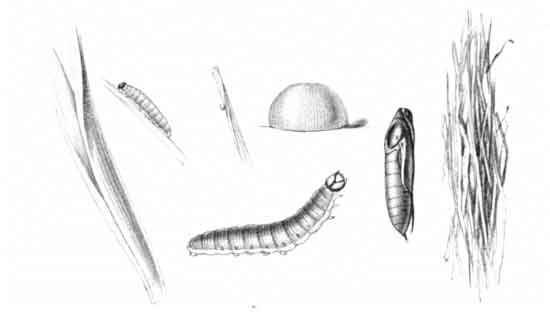
Large Skipper.
Egg, natural size and enlarged; caterpillars, chrysalis and cocoon.

Silver-spotted Skipper.
Egg, natural size and enlarged; caterpillar.
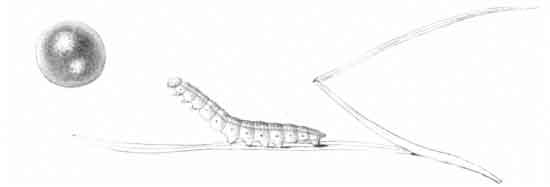
Pl. 127.
Chequered Skipper.
Egg enlarged and caterpillar.
The chrysalis is secured in the cocoon by hooks at the tail and by hooked bristles on the head; the head and thorax are pale olive mottled with blackish; the body olive, spotted with dark olive, and inclining to yellow on the ventral surface; below each spiracle is a short longitudinal mark; the spiracles are amber-brown.
The butterfly is to be found in August on most of our chalk hills, but has not been recorded from either Scotland or Ireland.
It is a very quick flyer and difficult to capture when on the wing, but it is fond of sitting on low-growing thistles, and is then sometimes easy to take. Abroad it occurs throughout Europe and Northern Asia to China and Japan.
The Chequered Skipper (Carterocephalus palæmon).
The well-defined yellow or orange spots on the blackish-brown ground colour distinguish this butterfly from all other British Skippers.
The variation is only of a minor kind, and chiefly in the direction of an increase or a decrease in the number and the size of the spots. Occasionally those on the central area of the fore wings are much enlarged and more or less confluent; and the spots on the outer margin of the hind wings are sometimes very small or entirely absent.
The following particulars of the early stages are abstracted from Mr. Frohawk's life-history of the species (Entomologist, 1892):—
Living females received in June were placed on a growing plant of brome grass (Bromus asper), and a few eggs were deposited, some upon the blades of grass, others upon the gauze-covered glass jar in which the plant was placed; they were laid singly, firmly adhering to whatever laid upon. The first lot of eggs were deposited on June 14. The egg has a pearly appearance, being whitish or yellowish-white in colour. Ten days after the egg is deposited the young caterpillar emerges by eating away the crown. Soon after hatching out the young caterpillar makes a little tubular dwelling, drawing together the edges of the grass-blade by spinning about three or four stout cords of silk, which quickly contract, causing the edges to draw together, and sometimes to overlap, forming a compact short tube; generally before spinning it nibbles off the extreme edge of the blade where the silk is afterwards attached. It feeds upon the blade both above and below its abode, devouring so much that frequently only the midrib of the blade remains, and the tube only just long enough to conceal it; it then shifts its quarters, and prepares a new home.
On October 3, when one hundred and one days old, the caterpillar was pale primrose-yellow, and the stripes of a slightly darker hue, the white lateral line showing clearly, and spiracles brownish; the head pale buff with a faint lilac tinge, with a black patch above the mouth and brownish at the sides. In the previous stage the caterpillar was whitish-green with a rather dark green line along the middle of the back, this line bordered on each side by an almost white, very fine line, followed by alternate darker and lighter lines, the lightest being extremely fine; "then a subdorsal darker green line, [Pg 197]bordered laterally by a conspicuous whitish line, which is again bordered below by a paler and indistinct green line, and a very faint spiracular whitish stripe, on which the spiracles are placed; they are white, outlined by a dark but indistinct ring; the under surface is whitish-green."
About the middle of October the hibernaculum was formed by spinning two blades of grass together at the edges, so making a tube, in which the caterpillar remained during the winter. On March 21 it left its retreat, but did not seem to feed, and generally remained quiet, lying along a grass-blade. On April 3 "it had drawn together with silk six blades of grass at the ends, forming a tent-like structure, and along the surface of one of the broadest a little carpet of silk was spun, upon which it rested with its head uppermost; a silk cord also encircled its body round the fourth segment." It assumed the chrysalis state on April 8, and had then passed two hundred and eighty-nine days in the caterpillar condition. The chrysalis measures five-eighths of an inch in length, is fairly cylindrical, but tapering to the tail. "Dorsal view: the head is pointed in front in the form of a short conical beak; the eyes are rather prominent; the thorax is swollen in the middle, the widest part, and then gradually tapers towards the last segment, which is elongated and flattened. Lateral view: the beak is slightly upturned, the thorax convexed, and the segment next to the thorax is rather swollen in the middle, so forming a rather decided depression at the base of the thorax, where the silken cord passes round; the body gradually tapering to the last segment, which terminates in a long compressed curved process furnished with long hooks; the wing-cases extend down two-thirds its length, and only very little, if at all, swollen; the antennæ and legs are but feebly modelled; the tongue is well defined, it is dusky at the base, blending into black at the apex; the colour is of a very pale primrose-yellow, shading into pearly grey, and semi-transparent on the head, wings, and [Pg 198]flap; a dark medio-dorsal line commences at the base of the beak, and passes down the entire length, gradually fading off in the anal extremity; it is blackest on the head and first abdominal segment, and palest on the thorax, where it is light brown; there are two rust-red subdorsal lines, which run parallel from the base of the antennæ to the last segment; another similar line, united along the inner margin of the wing, passes over two spiracles, and then runs parallel with the subdorsal lines.... The antennæ and wings are faintly outlined with dusky brown. In general appearance and colouring the pupa closely resembles a piece of dead withered grass."
A female butterfly emerged on May 20, the transformation from egg to perfect insect thus occupying about eleven months. This local butterfly is on the wing in June; sometimes it is seen in the latter part of May, and, more rarely perhaps, in July.
This species appears to have been first noticed as an inhabitant of Britain in 1798, in which year specimens were taken in Clapham Park Wood, Bedfordshire, by Dr. Abbott, who, four years later, also reported the butterfly from White Wood, Gamlingay, Cambridgeshire. In 1823 it was found to occur at Castor Hanglands, near Peterborough; and in 1841 Doubleday met with it, in large numbers, in Monk's Wood, Huntingdonshire. Among other localities from which it has been reported are Ropsley Wood, near Grantham, Notts, and Wychwood Forest, Oxfordshire.
In its special localities, which, at the present time, are chiefly the larger woods in Lincolnshire, Northamptonshire, and Buckinghamshire, it frequents the flowers of ground ivy (Nepeta glechoma) and of the bugle (Ajuga reptans).
Abroad it is locally common in various parts of Central Europe; also occurs in Finland, Central and Northern Russia, Dalmatia, Piedmont, and in Labrador, and other parts of North America.
* Species so marked in this Index are reputed British.
THE END.
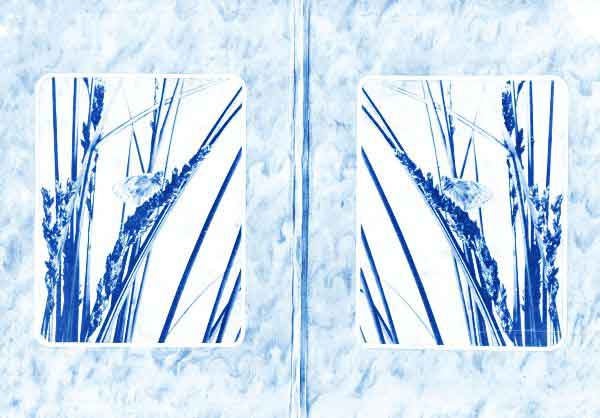
Transcriber notes:
Fixed various punctuation.
Added a List of Contents at the beginning.
P. 71. 'wing' changed to 'wings'.
P. 137. 'emergencies' changed to 'emergences'.
P, 168. 'localties' changed to 'localities'.
P. 197. 'next to the thorax'. Added 'to'.